Target2: The Silent Bailout System That Keeps the Euro Afloat
Abstract
Table of Contents
| 1. Introduction........................................................................................................................ | 2 | |
| 2. What is an Optimal Currency Area?............................................................................ | 3 | |
| 3. Some historical examples of unsuccessful and successful OCAs................................. | 4 | |
| 4. Examining the Eurozone as a possible OCA................................................................. | 5 | |
| 5. How has the Eurozone fared since its introduction in 1999?......................................... | 12 | |
| 6. Is the Eurozone an OCA?................................................................................................ | 24 | |
| 7. What is Target2 and how does it work?......................................................................... | 25 | |
| 7.1. What is Target 2?.................................................................................................... | 25 | |
| 7.2. How does Target2 work?........................................................................................ | 25 | |
| 7.3. How has Target2 operated...................................................................................... | 27 | |
| 7.3.1. First phase: 1999–2007.................................................................................. | 27 | |
| 7.3.2. Second phase: 2007–2014.............................................................................. | 27 | |
| 7.3.3. Third phase: 2015–2019............................................................................... | 29 | |
| 7.3.4. Fourth phase: 2020–..................................................................................... | 31 | |
| 8. How Target2 bails out the euro...................................................................................... | 31 | |
| 9. The costs of bailing out the euro.................................................................................... | 35 | |
| 9.1. Private debts are nationalised and monetised...................................................... | 35 | |
| 9.2. Target2 debts are being mutualised across the Eurozone.................................. | 36 | |
| 9.3. Target2 facilitates capital flight and this distorts interest rates in the Eurozone | ||
| ..................................................................................................................................... | 37 | |
| 9.4. Target2 treats sovereign debt as risk-free—the implications for central counterparties | 38 | |
| 9.5. The euro is a structurally incomplete sub-sovereign currency which operates | ||
| with vast amounts of unmanaged financial risk.................................................... | 39 | |
| 9.6. Target2 liabilities are not counted as part of a member state’s national debt and | ||
| the risks associated with them are unmanaged....................................................... | 42 | |
| 9.7. Spillover effects between Eurozone banks and sovereigns—the ‘doom loop’ | 43 | |
| 9.7.1. Two examples of a doom loop................................................................. | 43 | |
| 9.7.2. Breaking the doom loop........................................................................... | 46 | |
| 9.8. Cross-border spillover effects............................................................................ | 48 | |
| 9.9. Spillover effects between Eurozone banks and shadow banks....................... | 52 | |
| 9.10. Cross-border transmission of EZ monetary policy....................................... | 54 | |
| 9.11. Target2 is helping to bail out uncompetitive economies and delay the necessary | ||
| equilibrating adjustments to the real economies of underperforming EZ members | 55 | |
| 10. The Eurozone’s quantitative easing programme and Target2............................... | 57 | |
| 10.1. The ECB’s own capital keys prevented the full implementation of the first | ||
| phase of QE............................................................................................................. | 58 | |
| 10.2. The second phase of QE in response to the COVID-19 pandemic is perpetuating | ||
| a real estate bubble................................................................................................. | 60 | |
| 10.3. The third phase of QE—winding down, except in the case of Italy | 62 | |
| 10.4. The fourth phase of QE—quantitative tightening........................................ | 71 | |
| 10.5. Is the QE programme legal under EU law?.................................................. | 78 | |
| 11. Can a country leave the Eurozone?........................................................................ | 79 | |
| 12. Is there a political solution to the Eurozone problem?......................................... | 81 | |
| 13. Why is the problem with Target2 so Scarcely Known?........................................ | 86 | |
| 14. Implications for the UK.......................................................................................... | 88 | |
| 15. Conclusions............................................................................................................. | 90 | |
| Appendix A. The role of banknotes in Target2............................................................ | 93 | |
| Appendix B. Capital subscription to the European Central Bank, 1 January 2023 | 96 | |
| Appendix C. List of acronyms................................................................................... | 97 | |
| References..................................................................................................................... | 119 |
1. Introduction
- Is the Eurozone an Optimal Currency Area?
- How long can the euro survive if it is not?
- What role does Target2 play in prolonging the euro’s survival?
- Can a political solution save the euro?
2. What Is an Optimal Currency Area?
3. Some Historical Examples of Unsuccessful and Successful OCAs
4. Examining the Eurozone as a Possible OCA
Joining a single European currency dominated by and centred around a strong economic core (focused on Germany) may be beneficial to peripheral member regions in good economic times (such as the boom years of 2000–2007 when capital flowed from the core to the more peripheral parts of Euroland23), but it may prove highly disadvantageous once a major shock like the [Global] Financial Crisis of 2007–200824 occurs, since the scope for independent monetary intervention no longer exists. At the same time, the Eurozone lacks a centralised fiscal stabilisation mechanism by which to provide counter-cyclical intervention.25
Some of [the OCA] conditions were satisfied at the inception of the EMU, others were missing at the beginning, but improved over time as expected by the endogenous approach to the OCA theory. The common fiscal capacity was the main missing element of the initial construction of the Eurozone, and still is. The common budget is so exiguous that its effectiveness as a shock absorption mechanism is negligible….Some of the concerns raised on the eve of the euro did actually materialise, even if not immediately. First, in its first decade, the Eurozone did not experience major turbulences, because growing financial integration was compensating the need for fiscal transfers, channelling the excess of saving from the ‘core’ to the ‘periphery’. Second, the mechanism generated record-high private indebtedness in the ‘periphery’ and exposure of the banks in the ‘core’, making the whole system more fragile as it relied upon financial market stability. Third, once the long-feared shock [i.e., the GFC] hit, the mechanism proved weak and non-resilient. The inherent weaknesses of the EMU became evident. Fourth, as it had been foreseen, the cost of the adjustment after the shock fell mainly on labour, with much higher and longer unemployment in the Eurozone than both non-Eurozone EU and the US. Fifth, as the [OCA] theory suggested, the lack of common mechanisms of adjustment dramatically increased the socio-economic divergences within the EMU.26
- The European Regional Development Fund (ERDF), which ‘promotes balanced development in the different regions of the EU’.
- The European Social Fund (ESF), which ‘supports employment-related projects throughout Europe and invests in Europe’s human capital—its workers, its young people and all those seeking a job’.
- The Cohesion Fund (CF), which ‘funds transport and environment projects in countries where the gross national income (GNI) per inhabitant is less than 90% of the EU average. In 2014–2020, these [were] Bulgaria, Croatia, Cyprus, the Czech Republic, Estonia, Greece, Hungary, Latvia, Lithuania, Malta, Poland, Portugal, Romania, Slovakia and Slovenia’.
- The European Agricultural Fund for Rural Development (EAFRD), which ‘focuses on resolving the particular challenges facing EU’s rural areas’.
- The European Maritime and Fisheries Fund (EMFF), which ‘helps fishermen to adopt sustainable fishing practices and coastal communities to diversify their economies, improving quality of life along European coasts’.
- The European Systemic Risk Board (ESRB), which was established to oversee the EU financial system and mitigate systemic risk.
- The three European Supervisory Authorities (ESAs), which were established to provide incentives to avoid excessive risk taking in the financial services industry and to promote a level playing field in support of beneficial financial integration within the EU, namely:
- ○
- The European Banking Authority (EBA);
- ○
- The European Securities and Markets Authority (ESMA);
- ○
- The European Insurance and Occupational Pensions Authority (EIOPA).
- The European Stability Mechanism (ESM),37 which was organised by member states of the EZ to preserve financial stability in Europe by providing financial assistance to EZ states experiencing financial difficulty. The ESM can borrow via bond issuance up to EUR 500 bn, and EUR 190 bn of this was used to bail out the Irish and Portuguese banks in 2010–2011. In September 2012, the ECB introduced a programme of Outright Monetary Transactions (OMT), under which it makes purchases (‘outright transactions’) in the secondary market for bonds issued by EZ members, with the aim of ‘safeguarding an appropriate monetary policy transmission and the singleness of the monetary policy’.38 The total cost of rescuing EU banks between October 2008 and December 2012 amounted to EUR 592 bn in state aid.39
- The Securities Markets Programme (SMP), which was established to ensure depth and liquidity in the malfunctioning segments of bond markets (where transactions were having a significant effect on bond price volatility) and to restore the appropriate functioning of the monetary policy transmission mechanism. To avoid the SMP altering the EZ’s declared monetary policy, the bond purchases conducted through the SMP are sterilised and do not change central bank liquidity.40
- The EBA plans to implement the Basel III banking regulation in a consistent manner across the EU despite Basel III being a voluntary code and estimates made by the OECD that its implementation will reduce global economic growth by between 0.05 and 0.15% p.a.43
- The implementation of the Total Loss Absorbing Capacity (TLAC) rules. The European Commission has plans to increase EU oversight of foreign banks. Foreign banks with significant activities in the EU would be required to operate via ‘intermediate holding companies’. These would have to meet: additional capital requirements; the internationally agreed TLAC rules; and other minimum internationally agreed standards in order to ensure that they could be wound down safely if they fail. The banks would have to issue equity and junior debt (such as contingent convertible (CoCo) bonds), that would be written off in the event of a crisis. Philip Hammond, the UK finance minister at the time, described the proposals as anti-competitive and claimed that they could also ‘constrain prudential authorities in a way that could have an impact on financial stability’.44
- The Markets in Financial Instruments Directive (MiFID) II which deals with the trade and provision of services by investment intermediaries relating to financial instruments (e.g., shares, bonds, units in collective investment schemes, and derivatives). Jeff Sprecher, CEO of Intercontinental Exchange, has described MiFID II—which came into effect in January 2018—as ‘a terrible piece of legislation that imposes tremendous costs on the industry’. MiFID II grew out of the G20 financial regulation principles established in November 200945 to reduce systemic risk following the GFC, but it has been criticised as being excessively complex and its implementation was delayed by a year. One particular issue is the unbundling of investment research and transaction costs.46 MiFID II, in order to achieve full cost transparency for customers, ended the standard industry practice of brokerage firms providing investment research free of charge in return for trade execution business. McKinsey estimated that the profits of European asset managers that pay for research in full could be reduced by 15–20%. Larry Fink, CEO of BlackRock, the world’s biggest fund manager, expressed concern that MiFID II could lead to a dearth of research coverage focused on smaller listed companies.47 Another unintended consequence is the inadequate assessment of environmental, social, and governance (ESG) risks in ESG specialist funds—since ESG assessment requires inputs, like databases and proxy advisors,48 which cannot be valued by MiFID II research valuation approaches—leading to the potential overstatement of ESG integration.49 Brokers and asset managers predicted correctly that MiFID II would lead to fewer trades, reduced price discovery, and less efficient markets.50 Another issue is the reporting of trades to regulators within a specified time, the cost of which has encouraged some hedge funds, such as Brevan Howard and Tudor, to register under the Alternative Investment Fund Managers Directive (AIFMD) rather than under MiFID II.51 The total cost to the finance industry of implementing MiFID II was estimated at more than EUR 2.5 bn.52 Within months of its introduction, trading in a number of futures and options contracts was being shifted from London to the US, and European investment banks were losing business to their US rivals.53 The EU ultimately accepted that the directive was flawed and introduced the MiFID II ‘Quick Fix’ Directive54 in February 2021 with the aim of removing unnecessary administrative burdens on firms before February 2022; these related to product governance, payment for research (enabling the joint payment of execution services and research on small and midcap issuers), client information requirements (such as reporting when a portfolio had decreased by 10% in value), and best execution requirements.
- The Capital Requirements Directive IV (CRD IV). This is damaging for EU financial markets in terms of restrictions on cross-border lending and a bankers’ bonus cap, for example.
- Solvency II. The UK House of Commons Treasury Select Committee launched an inquiry into the ‘manifest shortcomings’ of the Solvency II Directive dealing with the regulation of insurance companies.55 The inquiry’s report was published in October 2017. While the evidence submitted to the committee highlighted problems with the legislation as drafted (e.g., with respect to the risk of procyclicality and market distortion, the calibration of the risk margin, the approval of internal models and subsequent model change, and the volume and complexity of data required from firms), the report was concerned with the way Solvency II has been implemented in the UK by the Prudential Regulation Authority (PRA): ‘An excessively strict interpretation of the requirements of Solvency II, and of its own obligations, has limited the PRA’s thinking in a way which could be detrimental to UK plc’.56 The UK government replaced Solvency II with Solvency UK in November 2022.57 This lowered the ‘risk margin’58 for long-term life insurance business by 65% and for general insurance business by 30%. It also modified the ‘matching adjustment’59 to allow for the inclusion of assets with highly predictable (and not just fixed) cash flows. These changes will enable UK insurers to invest in a broader range of assets, notably those that are more illiquid and have a lower credit rating, but are longer-term and geared towards infrastructure projects.
First, banks should not wait for the perfectly conducive environment for M&A, but rather should work actively with all involved regulators to achieve better synergies in cross-border M&A. They should challenge domestic ring-fencing practices in the Eurozone—in particular, by pushing for cross-border liquidity waivers, which national regulators can grant. Along those lines, banks should push domestic resolution authorities not to add MREL (minimum requirement for own funds and eligible liabilities) requirements to local subsidiaries of banking groups on top of the MREL requirements made by the Single Resolution Board.
Longer-term, European banks need to challenge their core business models. Yes, we have seen various rounds of restructuring and digitisation at all European banks since the Global Financial Crisis. But at their heart, they are set up across traditional client-oriented silos (such as retail or wholesale banks or wealth management divisions), with the majority of their revenue streams reliant on risk intermediation. While rising rates now help these businesses, this is not enough to change the fortune of European banks.
These incremental revenues can create additional ammunition to finance a transition into the future—that is, to venture more deeply into technology, particularly data. Value technology services—such as payment, banking/insurance-as-a-service models or digital assets—are getting earnings multiples of 20 to 30, while connected data services (such as wallet services, connected ecosystem services for mobility, employment, education, commerce, or climate risk data) enjoy multiples of 30 to 40. Traditional risk intermediation businesses, by contrast, have multiples of just 10 to 20.
Transitioning to the future will require more than an innovation lab—companies must undergo sweeping organisational change, turning these platforms into primary or at least equal reporting lines, with future leaders being groomed in these leadership positions.
In the end, it will be up to European banks themselves to reverse the widening gap with US firms. Those that show they can change are likely to find eager support among investors, regulators and prudential authorities across Europe.
5. How Has the Eurozone Fared since Its Introduction in 1999?
6. Is the Eurozone an OCA?
7. What Is Target2 and How Does It Work?
7.1. What Is Target2?
7.2. How Does Target2 Work?
Italian government bonds held by other Eurozone national central banks and the ECB
+ Target2 liability of Banca d’Italia (owed to the ECB).
Net redemptions of Italian government bonds held by other Eurozone national central banks and the ECB
+ Interest on Italian government bonds held by other Eurozone national central banks and the ECB
+ Net private financial outflows,
Interest on national debt to other Eurozone governments
− Net private financial inflows.
- Before the crisis, both the BoP current account and the trade balance of the countries currently under stress were in deficit, with the exception of Italy where they were approximately balanced;134 these deficits were funded mostly by foreign investments in domestic securities and in the interbank market. The capital flowing in and out of the countries were almost completely netted out, leaving small average net balances in the individual items of the BoP financial account.
- During the crisis, the absolute size of individual items in the BoP increased and its composition changed significantly. The main changes were in the financial account. The reversal of foreign investments in domestic securities and of liabilities issued by domestic MFIs [monetary financial institutions] was not matched by a similar increase in disinvestments of domestic capital previously invested abroad. Net outflows in the financial accounts of the BoP [due to capital flight] were compensated by a considerable increase in the respective NCB’s Target2 liabilities with the ECB.
7.3. How Has Target2 Operated?
7.3.1. First Phase, 1999–2007
7.3.2. Second Phase, 2007–2014
- The Bank for International Settlements (BIS), the global central bank to the world’s national central banks: ‘Target2 balances grew strongly due to intra-euro area capital flight. At the time, sovereign market strains spiked and redenomination risk142 came to the fore in parts of the euro area. Private capital fled from Ireland, Italy, Greece, Portugal and Spain into markets perceived to be safer, such as Germany, Luxembourg and the Netherlands’ (Auer and Bogdanova 2017, Box A).
- Another BIS study found that ‘Italy is identified as a case of “capital flight” in late 2011’ and that in 2012 ‘Target2 balances reflected something more akin to a currency attack than current account financing or credit reversal’ (Cecchetti et al. 2012, p. 1).
- Banca d’Italia: ‘For all countries, the large increase in Target2 liabilities appears to be mostly related to capital flight, concerning both portfolio investments and cross-border interbank activity’ (Cecioni and Ferrero 2012, p. 22).
7.3.3. Third Phase, 2015–2019
- The first BIS study cited earlier argues that: ‘record Target2 balances [in 2017] should be viewed as a benign by-product of the decentralised implementation of the asset purchase programme rather than as a sign of renewed capital flight’ (Auer and Bogdanova (2017, Box A)).
- The European Central Bank (2016) argues that ‘mechanical’ effects in the accounting of asset purchases by EZ central banks fully explain the rise in Target2 balances.149 Accordingly, divergence could not be attributable to a ‘capital flight’ from peripheral countries towards northern Europe.
- The ECB’s Financial Stability Review of May 2017 (p. 60) ‘analyses the factors underlying the renewed increases in Target2 balances and concludes that they do not reflect capital flight from certain euro area countries in a context of generalised mistrust of the respective banking sectors’.150
- A Banco de España study asserts that ‘the recent developments do not reflect financial stress or general funding problems in euro area economies, as during the sovereign debt crisis, but are instead mainly linked to the execution of the Eurosystem’s asset purchase programme’ (Alves et al. 2018).
- A study by Banca d’Italia argues that a share of the Target2 movements for Italy occurred because of portfolio rebalancing: ‘Households are turning to insurance companies and professional advisors to invest their savings in mostly foreign assets. This shift does not appear attributable to a preference for financial assets deemed safer (residents actually made net sales of German public sector securities in the period considered), but instead to the pursuit of more balanced portfolios and higher yields than those normally offered on public sector securities. This reflects the difficulty investors face in achieving greater diversification in a domestic financial market characterised by relatively few alternatives to bank bonds and public sector securities’ (Banca d’Italia (c2017) Target2 balances and capital flows).
7.3.4. Fourth Phase, 2020–
8. How Target2 Bails out the Euro
- In a monetary union which is characterised by a single monetary authority, the central bank has to provide deficit countries with the required liquidity to fund the massive capital outflows towards surplus countries. In a system of decentralised central banks, this provision of funds transforms debts between private banks into debts between private banks and their respective central banks, and between central banks of different countries and the ECB. The latter imbalances take place through the Target2 system.
- Central banks in the periphery lend to banks within their jurisdiction against eligible collateral (usually sovereign public debt) to comply with the reserve requirement, and next this central bank money flows to the core, leading to an excess reserve there, which has been used to cancel bank debt within their central banks, and to purchase [the] sovereign public debt of their national treasuries.
- The Eurosystem had no choice but to lend to private banks in the periphery. Otherwise:
- The payment system would have collapsed, because deposits in the periphery could not have been used as means of payments to cancel debts.
- Private banks in the core EZ would have suffered amazing losses given their expos[ure] to banks in the periphery.
- The transmission of monetary policy would have ceased to work: the lack of access to funding would have led banks in the periphery to pay skyrocketing rates for reserves in money and capital markets. All of the whole peripheral economies would have collapsed, dragged by the fall of their banking system. This would have meant the end of the euro.…Sinn and Wollmershäuer have mistakenly pressed several alarm buttons, because they have confused a pegged exchange rate system with a monetary union. In essence, they claim that T2 imbalances are loans granted by the Eurosystem (in the last instance, funded with German savings) which allow peripheral countries to avoid adopting hard measures to restore external equilibrium, and to continue ‘living beyond their means’. Moreover, in the last instance, these loans are a risky asset for Germany. Therefore, their economic policy recommendation is to set a cap on T2 imbalances, and to cancel them by handing over marketable assets. This should force peripheral countries to restore their external balance through a competitive devaluation (falling nominal wages) and fiscal austerity. Accordingly, some countries would find it easier to return to equilibrium leaving the euro.[There are two mistakes with this view, according to Febrero and Uxó]:
- Actually, T2 imbalances are not new loans, but the defensive outcome of a central bank aiming at steering a payment system smoothly, and at granting access to all banks within the monetary union under equal conditions.177 Without refinancing loans, provided by NCBs, private banks in the EZ periphery could not comply with the reserve requirement and the monetary transmission mechanism would not work at all.
- Fiscal austerity and wage deflation would do more harm than good even to Germany, an export-led growth country, because these deflationary measures would shrink its external markets even further. Moreover, austerity-cum-deflation will increase the fraction of non-performing loans in the periphery and, therefore, the likelihood of NCBs capital losses.T2 claims are part of German financial wealth, so the German authors are right when they claim that there is a risk for Germany if there is a disorderly euro breakup. However, their economic policy recommendations are more of a self-fulfilling prophecy than a solution to this risk.
- Without denying that T2 are part of Germany’s financial wealth, Whelan (2012),178 states that in the event of a disorderly euro dissolution, the true problem for Germany, which has followed an export led growth pattern for a long time, would be that its new Deutschemark would appreciate with respect to the already existing euro and, much more, the new currencies (e.g., the Italian lira, the Spanish peseta and so on). … The loss for Germany would be that it could not purchase goods and services in the rest of the EZ without borrowing.
9. The Costs of Bailing out the Euro
9.1. Private Debts Are Nationalised and Monetised
9.2. Target2 Debts Are Being Mutualised across the Eurozone
9.3. Target2 Facilitates Capital Flight, and This Distorts Interest Rates in the Eurozone
9.4. Target2 Treats Sovereign Debt as Risk-Free and the Implications for Central Counterparties
Were that not the case, private sector institutions, such as central counterparties, as well as the central banks holding government debt, would have to take account of the riskiness of different EZ member states’ government debt by way of haircuts and, additionally, in the case of the private sector institutions, by allocating more regulatory capital against it.202 This would make the holding of much of that debt prohibitively expensive, which would, in turn, bring an end to the merry-go-round process of government bonds being issued and ‘sold’ to member state banks with no impact on bank capital.does not grant a general zero risk weight for sovereign debt. However, owing to the analogous adoption of exemptions stated within the Basel II framework, EU regulation de facto grants zero risk weights for the majority of debt issued by EU sovereigns. According to Article 114(4) of the CRR, exposures to member states’ central governments and central banks denominated and funded in the domestic currency of that central government and central bank shall be assigned a risk weight of 0% in the standardised approach. Because of the currency union, the exemption is automatically applicable to all banks within the euro area that finance euro-denominated government debt, leading to preferential treatment of the respective bonds in spite of actual differences in credit risk.201
9.5. The Euro Is a Structurally Incomplete Sub-Sovereign Currency That Operates with Vast Amounts of Unmanaged Financial Risk
- No member state individually controls the ECB, so EZ members are ‘sub-sovereign’, implying that the member states do not (and cannot) stand behind their government debts or currency in the way genuine sovereigns do—by printing more money to repay their debts when their tax base proves to be insufficient.207
- There is no joint-and-several liability between member states or lender-of-last-resort facility.208 The EU’s legal structures do not oblige EZ member states to stand together behind each other’s debts in a way that would protect the balance sheets of EZ financial institutions through member states’ collective guarantee and collective control over the ECB. This implies that the following statement made by an Executive Board member of the ECB, while true for a conventional central bank, is not true for the ECB: ‘The only risk-free assets in the euro area are the ECB’s own liabilities’.209 There are no risk-free assets in the EZ.
- There is no EZ-wide bank deposit insurance scheme.
- The EZ’s banks are generally weak and there have been no major cross-border mergers to increase the strength of the banking system.
- There is a significant problem with non-performing loans.210
Low aggregate bank profitability in the euro area, which weakens the resilience of the euro area banking sector, is partly explained by the persistent underperformance of a sub-set of banks. These banks all stand out in terms of elevated cost-to-income ratios. But there also appear to be three distinct groups: (i) banks struggling with legacy asset problems; (ii) banks with weak income-generation capacity; and (iii) banks suffering from a combination of cost and revenue-side problems. The common cost inefficiency problem seems most pronounced for the largest and smallest banks. Three strategies, all of which should reduce overcapacity, could address the root causes, while avoiding increasing market power or the systemic footprint of institutions which are already systemically important. For some banks, the focus should be on targeting continued high stocks of non-performing loans (NPLs). But in systems with many weak-performing small banks, consolidation within their domestic system could improve performance. Finally, a combination of bank-level restructuring and cross-border M&A activity could help reduce the costs and diversify the revenues of large banks that are performing poorly.211
- Non-standard NPL treatment. Contrary to normal accounting practice around the world, the rump of NPLs—such as business loans, mortgage lending to consumers, and consumer credit—is discounted and then treated as performing. Treating this rump as performing debt is premised on the borrower achieving partial repayment, despite evidence that the non-rump portion of the debt will not be recovered and despite no adjustment being agreed to the amount owed by the borrower.
- Accounting practices that leverage the sovereign assumption. The EU has permitted banks to securitise NPLs and repackage them, with guarantees given by the relevant EZ member state in which the borrowers are located. It then permits EU banks to hold the resulting securitised NPLs at a level reflecting a sovereign treatment of the EU member state guarantee—see Figure 25 which shows that Greek banks, for example, have government guarantees in respect of NPLs of around 100% of their shareholders’ equity. This has alarming similarities with the repackaging of US sub-prime mortgages into supposedly ‘prime’ segments that sparked the Global Financial Crisis.219 These guarantees should be considered part of each member state’s national debt, but they are not.220
- Opaque accounts. Eurosystem accounts are opaque. They do not list all public debts in the manner adopted by other developed countries, such as the UK or US. The system runs four different sets of accounts, but, when consolidated, it assumes the amounts owing between NCBs and the ECB can be netted, thereby disregarding the intra-system gross exposures. It is unclear whether this assumption is legitimate, even under EU law.
- The fundamental design flaw in the legal architecture underpinning the EZ, which treats both the EZ and its member states as sovereign when these two assumptions are mutually incompatible.
- The extent of existing EZ member state debt that is not jointly-and-severally guaranteed in law—and which is not readily apparent from publicly available accounts.
- The fact that the true situation might be worse than is apparent, given Eurozone accounting practices—and may be worse still given the opacity of such accounting practices.
- The fact that EU and EZ regulators are not in a position to manage significant financial risk effectively, since they are structurally unable to reconcile the need to maintain the viability of the Eurozone with the need to regulate for financial safety and soundness.
9.6. Target2 Liabilities Are Not Counted as Part of a Member State’s National Debt, and the Risks Associated with Them Are Unmanaged
it is not simply a matter of adding the Target2 debt, since, depending upon which account that indebtedness is on, it may need to be collateralised by the borrowing NCB, and it is perfectly possible that the collateral is already counted in the ‘General government gross debt’ of the country of the borrowing NCB. On any such portion, the Target2 debt taken against collateral does not increase the ‘General government gross debt’.
On the other hand, the debt may not be collateralised at all, or else the collateral pledged falls outside the ‘General government gross debt’: in either of those cases, the Target2 debt does increase the overall debt.223
Then there is the question of the excess Target2 debt which is netted away at the end of each business day, and which is not collateralised with bonds that are already included in ‘General government gross debt’. We do not know who exactly are the debtors and creditors for this extra amount, which I believe to be €1.2 trn.224
9.7. Spillover Effects between Eurozone Banks and Sovereigns—The ‘Doom Loop’
9.7.1. Two Examples of a Doom Loop
9.7.2. Breaking the Doom Loop
The first set of ideas relates to: (i) the removal of the internal ratings-based (IRB) approach framework for sovereign exposures; (ii) revised standardised risk weights for sovereign exposures held in both the banking and trading book, including the removal of the national discretion to apply a preferential risk weight for certain sovereign exposures; and (iii) adjustments to the existing credit risk mitigation framework, including the removal of the national discretion to set a zero haircut for certain sovereign repo-style transactions.
The second set of ideas relate to mitigating the potential risks of excessive holdings of sovereign exposures, which, for instance, could take the form of marginal risk weight add-ons that would vary based on the degree of a bank’s concentration to a sovereign (defined as the proportion of sovereign exposures relative to Tier 1 capital).
The third set of ideas is related to the Pillar 2 (supervisory review process) and Pillar 3 (disclosure) treatment of sovereign exposures [in the Basel framework]. Regarding the former, these include ideas related to guidance on: (i) monitoring sovereign risk; (ii) stress testing for sovereign risk; and (iii) supervisory responses to mitigating sovereign risk. Regarding the Pillar 3 framework, this paper includes ideas related to disclosure requirements related to banks’ exposures and risk-weighted assets of different sovereign entities by jurisdictional breakdown, currency breakdown and accounting classification.
9.8. Cross-Border Spillover Effects
9.9. Spillover Effects between Eurozone Banks and Shadow Banks
9.10. Cross-Border Transmission of Eurozone Monetary Policy
9.11. Target2 Is Helping to Bail out Uncompetitive Economies and Delay the Necessary Equilibrating Adjustments to the Real Economies of Underperforming Eurozone Members
Far from encouraging economic convergence, the monetary integration process has increased the productive, trade, and financial imbalances among the Eurozone’s member countries. The division of labour inside the European Monetary Union was further polarised between core economies, specialising in high value-added goods, and the peripheral ones, specialising in middle-low value-added goods. Furthermore, the adoption of a single currency led to the worsening of external account balances. In this sense, the progressive trade deficits experienced by the peripheral countries were financed by the massive financial funds of the core countries. These imbalances are the key element in the sovereign debt crisis that the peripheral countries are facing today [i.e., in 2017]. The austerity policies applied have placed responsibility on these countries. However, these policies have only worsened the problem. Any attempt to solve this situation should, first, try to correct productive imbalances, keeping in mind that the weight of the adjustment should be shared by both debtor and creditor countries274—which is in line with the Keynes Plan.
One day, the house of cards will collapse. The euro has been betrayed by politics, the experiment went wrong from the beginning and has since degenerated into a fiscal free-for-all that once again masks the festering pathologies. Realistically, it will be a case of muddling through, struggling from one crisis to the next. It is difficult to forecast how long this will continue for, but it cannot go on endlessly…The Stability and Growth Pact has more or less failed. The moral hazard is overwhelming. Market discipline is done away with by ECB interventions. There is no fiscal control mechanism from markets or politics. This has all the elements to bring disaster for monetary union. The no-bailout clause is violated every day and the European Court’s approval for bailout measures is simple-minded and ideological. … The ECB has crossed the Rubicon and is now in an untenable position, trying to reconcile conflicting roles as banking regulator, Troika enforcer in rescue missions and agent of monetary policy. Its own financial integrity is increasingly in jeopardy.
The venture began to go off the rails immediately, though the structural damage was disguised by the financial boom. There was no speed-up of convergence after 1999—rather, the opposite. From day one, quite a number of countries started working in the wrong direction. A string of states let rip with wage rises, brushing aside warnings that this would prove fatal in an irrevocable currency union. During the first eight years, unit labour costs in Portugal rose by 30% versus Germany. In the past, the escudo would have devalued by 30%, and things more or less would be back to where they were. Quite a few countries—including Ireland, Italy and Greece—behaved as though they could still devalue their currencies. The elemental problem is that once a high-debt state has lost 30% in competitiveness within a fixed exchange system, it is almost impossible to claw back the ground in the sort of deflationary world we face today. It has become a trap. The whole Eurozone structure has acquired a contractionary bias. The deflation is now self-fulling. The first Greek rescue in 2010 was little more than a bailout for German and French banks. It would have been far better to eject Greece from the euro as a salutary lesson for all. The Greeks should have been offered generous support, but only after [they] had restored exchange rate viability by returning to the drachma. [The fear was a chain-reaction reaching Spain and Italy, detonating an uncontrollable financial collapse. This nearly happened on two occasions, and remained a risk until Berlin switched tack and agreed to let the ECB shore up the Spanish and Italian debt markets in 2012.]
Cloaking it all is obfuscation, political mendacity and endemic denial. Leaders of the heavily indebted states have misled their voters with soothing bromides, falsely suggesting that some form of fiscal union or debt mutualisation is just around the corner. Yet there is no chance of political union or the creation of an EU treasury in the forseeable future, which would in any case require a sweeping change to the German constitution—an impossible proposition in the current political climate. The European project must therefore function as a union of sovereign states, or fail.276
10. The Eurozone’s Quantitative Easing Programme and Its Reversal
10.1. The ECB’s Own Capital Keys Prevented the Full Implementation of the First Phase of QE
because of a shortage of German Bunds. Remember how European quantitative easing works: to buy any amount of Italian bonds, Draghi has to buy twice as many Bunds.281 That is the only way the ECB could pull off QE ‘euro-style’. In other words, the only way of convincing German Chancellor Angela Merkel and Bundesbank chairman Jens Weidmann to allow the ECB to do QE was that it purchased government debt in proportion to GDP or to ECB shareholding by member states.282 Same thing. Now, the problem is that Bunds are running out because German finance minister Dr Wolfgang Schäuble is not issuing them—he is running a surplus. German financial institutions have an obligation to retain the Bunds they have. So you have excess demand for Bunds. This is creating problems for the smaller banks in Germany and the pension funds. And that is pushing Draghi into tapering already, and why the ECB’s programme of QE is going to be withdrawn very soon.283
Figures for July [see Figure 33] show that, for the fourth month in a row, German bonds bought under the European Central Bank’s public sector purchase [i.e., QE] programme (PSPP) fell short of the amount allowed by the ‘capital key’ allocation. Other countries have also seen significant deviations from the capital key, under which bonds are bought in proportion to the share of the ECB capital provided by each country. This figure is determined by the size of GDP and population, and is adjusted slightly to reflect the ineligibility of Greek bonds given their low credit rating.284
Since April, the ECB has bought an additional €4.2 bn of Italian bonds and €809 m of Spanish bonds, against an under-purchase of €1.09 bn for Germany and (since May) €172 m for the Netherlands. The divergence suggests growing difficulties with the ECB’s quantitative easing programme and has reignited speculation about a tapering of bond purchases.
These figures mark a significant break from the pattern that existed for the two years from the start of the PSPP in March 2015 until March 2017. During that period the ECB over-purchased German and Dutch bonds by a total of €8.3 bn and €2.3 bn respectively. Italian and Spanish bonds were also over-purchased to compensate for the scarcity of bonds in smaller euro area countries, including Cyprus, Estonia and Portugal. However, the scale of Italian and Spanish bond over-purchasing has increased rapidly this year. Since January the ECB has overshot Italy’s adjusted capital key by an average of €920 m per month and Spanish bonds by €311 m per month. This compares with €264 m and €181 m respectively each month from the start of the PSPP to the end of 2016. In July, the over-purchase of Italian bonds reached more than €1.2 bn, the highest monthly figure to date.
Mario Draghi, president of the ECB, reiterated in late June that the bank remains committed to QE through bond purchases. But the longer QE goes on, the greater the demand will be for bonds in core countries. In the coming months, the amount of eligible bonds could begin to face significant strains. To avoid a sudden fall in the amount of German bonds available, or a politically toxic redistribution of the capital key to allow higher allocations to bonds from southern countries, Germany is scaling back the rate at which its own bonds are purchased.
…As the ECB remains committed to doing ‘whatever it takes’ to return the euro area to stability and growth, new tools could be needed as the potential limits of QE edge ever closer.285
10.2. The Second Phase of QE in Response to the COVID-19 Pandemic Is Perpetuating a Real Estate Bubble
…in its [November 2021] Financial Stability Review,293 the European Central Bank issued an angst-ridden warning: Europe is facing a self-perpetuating debt-fueled real estate bubble. What makes the report noteworthy is that the ECB knows who is causing the bubble: the ECB itself, through its policy of quantitative easing—a polite term for creating money on behalf of financiers. It is akin to your doctors alerting you that the medicine they have prescribed may be killing you.
The scariest part is that it is not the ECB’s fault. The official excuse for QE is that once interest rates had fallen below zero, there was no other way to counter the deflation menacing Europe. But the hidden purpose of QE was to roll over the unsustainable debt of large loss-making corporations and, even more so, of key Eurozone member states (like Italy).
Once Europe’s political leaders chose, at the beginning of the euro crisis a decade ago, to remain in denial about massive unsustainable debts, they were bound to throw this hot potato into the central bank’s lap. Ever since, the ECB has pursued a strategy best described as perpetual bankruptcy concealment.
Weeks after the pandemic hit, French president Emmanuel Macron and eight other Eurozone heads of government called for debt restructuring via a proper Eurobond. In essence, they proposed that, given the pandemic’s appetite for new debt, a sizeable chunk of the mounting burden that our states cannot bear (unassisted by the ECB) be shifted onto the broader, debt-free, shoulders of the EU. Not only would this be a first step toward political union and increased pan-European investment, but it would also liberate the ECB from having to roll over a mountain of debt that EU member states can never repay.
Alas, it was not to be. German Chancellor Angela Merkel summarily killed the idea, offering instead a Recovery and Resilience Facility,294 which is a terrible substitute. Not only is it macroeconomically insignificant; it also makes the prospect of a federal Europe even less appealing to poorer Dutch and German voters (by indebting them so that the oligarchs of Italy and Greece can receive large grants). And, despite an element of common borrowing, the recovery fund is designed to do nothing to restructure the unpayable debts that the ECB has been rolling over and over—and which the pandemic has multiplied.
So, the ECB’s exercise in perpetual bankruptcy concealment continues, despite its functionaries’ twin fears: being held to account for the dangerous debt-fueled bubble they are inflating, and losing their official rationale for QE as inflation stabilises above their formal target.
10.3. The Third Phase of QE—Winding Down, except in the Case of Italy
can be activated to counter unwarranted, disorderly market dynamics [namely a severe widening of the spread between the yields on member state government bonds] that pose a serious threat to the transmission of monetary policy across the euro area. By safeguarding the transmission mechanism, the TPI will allow the [ECB] to more effectively deliver on its price stability mandate.
Subject to fulfilling established criteria, the Eurosystem will be able to make secondary market purchases of securities issued in jurisdictions experiencing a deterioration in financing conditions not warranted by country-specific fundamentals, to counter risks to the transmission mechanism to the extent necessary. The scale of TPI purchases would depend on the severity of the risks facing monetary policy transmission. Purchases are not restricted ex ante.
TPI purchases would be focused on public sector securities (marketable debt securities issued by central and regional governments as well as agencies, as defined by the ECB) with a remaining maturity of between one and ten years. Purchases of private sector securities could be considered, if appropriate.
…[The established] criteria include: (1) compliance with the EU fiscal framework:328 not being subject to an excessive deficit procedure (EDP), or not being assessed as having failed to take effective action in response to an EU Council recommendation under Article 126(7) of the Treaty on the Functioning of the European Union (TFEU); (2) absence of severe macroeconomic imbalances: not being subject to an excessive imbalance procedure (EIP) or not being assessed as having failed to take the recommended corrective action related to an EU Council recommendation under Article 121(4) TFEU; (3) fiscal sustainability: in ascertaining that the trajectory of public debt is sustainable, the [ECB] will take into account, where available, the debt sustainability analyses by the European Commission, the European Stability Mechanism, the International Monetary Fund and other institutions, together with the ECB’s internal analysis;329 (4) sound and sustainable macroeconomic policies: complying with the commitments submitted in the recovery and resilience plans for the Recovery and Resilience Facility (RRF)330 and with the European Commission’s country-specific recommendations in the fiscal sphere under the European Semester.
…Purchases would be terminated either upon a durable improvement in transmission, or based on an assessment that persistent tensions are due to country fundamentals.
It is politically impossible to keep mopping up Italy’s debt issuance under the guise of monetary policy. The euro’s crash to dollar parity has been the last straw. The Bundesbank has lost patience. The ECB is in the worst internal disarray since the depths of the Eurozone debt crisis. Hawks and doves are contradicting each other daily on fundamental strategy. Markets have no idea how the new ‘anti-spread’ tool (TPI) to protect Italy is supposed to work, or whether it is legal outside an emergency. ‘It is a complete shambles. Christine Lagarde has lost control and is not showing any leadership’, said one source close to the Bundesbank.
… Isabel Schnabel, Germany’s [former] member of the [ECB Governing] Council, …said ‘Our currencies are stable because people trust that we will preserve their purchasing power. Failing to honour this trust may carry large political costs. …History is full of examples of high and persistent inflation causing social unrest. Sudden and large losses in purchasing power can test even stable democracies. …Determined action is needed to break these perceptions. … [The ECB] must engineer a recession now to avoid something worse later’. This is the voice of the old Bundesbank.
It was an explicit warning that the ECB would no longer set policy to cap the bond yields of vulnerable states. Hedge funds could hardly receive a clearer invitation to revive the ‘short Italy’ trade.
‘We’ve been short since the beginning of the year. It seemed like Italy’s problems had gone away, but that was only because the ECB was buying more than 100 pc of net debt supply. They can’t keep doing that now’, said Mark Dowding from BlueBay Asset Management.
The International Monetary Fund said in its latest ‘Article IV’ report that foreigners have pulled a net €70 bn out of Italy over the last six months. It warned of a ‘vicious cycle between the sovereign and banks’ as yields rise on Italian debt.
The risk is more concentrated than a decade ago, since QE actively encouraged Italian banks to play the carry trade and acquire even more Italian sovereign debt. The infamous doom-loop of 2011–2012 is alive and well. The Eurozone Banking Union that was supposed to eliminate this uniquely European disorder never happened.
…The IMF described a possible chain-reaction where rising yields cause losses for banks, which then tighten loans, causing a credit crunch, which in turn leads to a deeper downturn in a pernicious spiral.
…Italy has emerged from the pandemic with a debt burden of 150% of GDP, 15 points higher than pre-Covid and nearing the point of no return for a sub-sovereign borrower unable to control its own currency. It has further liabilities to the ECB’s Target2 payments nexus near 30% GDP.
…Italy’s core problem is the toxic mix of high public debt intersecting with a trend growth rate near zero. One shocking detail in the IMF’s report is that total factor productivity has fallen by 13.5% since 2000.
Mr Draghi has not had time to drive through the radical reforms needed to rescue Italy from this bad equilibrium. His planned shake up of the pension and tax systems has stalled.
…’The ECB can’t give Rome a blank cheque, and it can’t keep pushing the envelope on monetary financing of debt’, said BlueBay’s Mr Dowding.
For now, the ECB is skewing redemptions of its bond portfolio away from Bunds and into Italian bonds, and on an eye-watering scale. This has technical limits and is a clear violation of the Maastricht Treaty’s no bail-out clause the longer it goes on.
The TPI was unveiled in early July but the details have yet to be ironed out. Nothing has yet appeared in the Journal Officiel and the instrument is not legally valid until it does so.
David Marsh, head of the Official Monetary and Financial Institutions Forum, said there are unresolved questions over who bears the financial risk of TPI interventions. It is unclear whether the tool constitutes a fiscal risk and therefore breaches the budgetary sovereignty of the German Bundestag, and whether it is compatible with past rulings by the German Constitutional Court.
‘The TPI can be activated only if there is contagion and a whole lot of countries are under pressure’, said Peter Schaffrik from RBC Capital. ‘If push comes to shove, the ECB will be there to buy Italian debt. But could the spreads go to 300 first? Yes they could’.
…The real danger for Italy is that it might be asphyxiated slowly by untenable borrowing costs that stay high and that expose the underlying pathologies of the economy over time, until something snaps.
After coasting on an undervalued currency, cheap energy, and a booming China, Germany is stuck in a spiral of decline. …Germany got extraordinarily lucky in the first two decades of this century. The replacement of the mighty Deutschemark with the far weaker euro meant that its currency was dramatically undervalued, allowing it to build up huge trade surpluses and dominate a vast range of industries where it may otherwise have been unable to compete. The industrialisation of China, meanwhile, was built on German machine tools creating a huge new market for the country’s formidable engineering firms. And it had access to what seemed like an endless supply of cheap Russian gas, allowing it to continue with heavy, power-hungry industries—the huge BASF plant in Ludwigshafen uses about as much gas as the whole of Switzerland—long after they would have been obsolete elsewhere. Add it all up, and this happy combination of circumstances created an illusion of permanent prosperity that allowed Germany during the Merkel era to complacently lecture the rest of the world on the brilliance of its consensual model, while racking up trade surpluses as if they would last forever. That luck has now run out. The war in Ukraine meant that the Russian gas had to be turned off, and given the ridiculously self-indulgent decision to close its nuclear plants, Germany only managed to avoid blackouts by paying eyewatering prices for energy on the global market. Factories are already closing because they can’t afford power. China seems to have bought all the German technology it needs, and is now turning the tables mercilessly on its former tutor. Led by the likes of BYD, the Chinese auto companies could well be about to destroy the German auto giants, and the EU’s planned tariffs on Chinese electric vehicles seem like they will be too late to save them. …Meanwhile, Germany has failed to digitise, with the fax machine still an everyday piece of kit. The country that capitalised so well on the first and second industrial revolutions is nowhere in the third. …But the real problem is deeper. Germany’s consensual, coalition-based political system…is incapable of pushing through the radical change and modernisation the country needs. …It is possible that Germany will reform itself one day. It is still a rich country, with a highly skilled workforce, a huge depth of technical talent and a huge presence in global markets. But it will take a radical overhaul of its political system, and a shattering of the complacent centrism that dominates its internal debate before that happens. And there is little sign of any such move on the horizon.
10.4. The Fourth Phase of QE—Quantitative Tightening
Lending is deteriorating most rapidly in Italy and Spain. ‘The tightening in financing conditions corroborates our view that the euro area is headed towards a sharp recession’, said Ludovio Sapio from Barclays. Trouble is baked into the pie already, whatever happens to Vladimir Putin’s war and global gas prices. Banks are doing what they always do at the rumble of thunder: they are imposing tougher terms on households and small firms; they are rejecting loan applications. This is a self-fulfilling process that can spin out of control at turning points in the business cycle. Ignazio Visco, governor of the Bank of Italy, warned … of a ‘serious credit crunch’ if the ECB tightens too hard into the downturn. Businesses are battening down the hatches, limiting borrowing to what is strictly necessary to stay afloat. Homeowners are baulking at soaring mortgage costs.
… [B]anks will lose a key prop just as they face the hit from the global bond market crash. They were induced to accumulate government debt under Quantitative Easing. Those banks most invested in this sovereign bank doom-loop now carry large paper losses that must be ‘marked to market’. This erodes their capital ratios, forcing them to curtail lending.
… The ECB faces an excruciating dilemma. … The founding contract of the euro was that the ECB should be as rigorous as the Bundesbank, and the euro should be as hard as the D-Mark. That contract looks like a quaint relic today. But it would be tempting fate to assume that Germany will tolerate double-digit inflation for long, or that it will allow the ECB to keep tilting policy towards the needs of Club Med debtors in the cause of euro solidarity.
The German economic establishment thinks the country is on the cusp of a wage-price spiral…. There is an even deeper problem of social cohesion. Inflation is toxic in Germany because of deep-rooted cultural traditions. Half of Germans rent rather than own property. They typically keep their savings in bank accounts, and have no financial assets. They have entirely missed out on the compensating wealth gains of the last decade. Gefühlte Inflation—the inflation that shoppers feel—is running at twice the official CPI rate.
… Volker Wieland, a former member of the German Council of Economic Experts, said inflation had reached the point where nothing short of sharply positive real rates will be enough to break the fever. ‘Inflation is going to become entrenched unless the central bank acts’, he said.
Positive real rates are precisely what Italy cannot endure. It is why premier Giorgia Meloni lashed out at the ECB on her first day in office, denouncing rate rises on the cusp of recession as precipitous.
… Mrs Meloni is now in implicit alliance with France’s Emmanuel Macron, who has also castigated unnamed monetary hawks at the ECB. His demarche is logical: France has an even bigger debt burden than Italy. Data from the Bank for International Settlements shows that total public and private debt (non-financial) is 351% of GDP in France, up 70 percentage points over the last decade. The comparable figure is 276% in Italy, and 271% in the UK, and 199% in Germany.
It is not that Germany is right, or that Italy and France are right. They are all right. This conflict is what happens if you impose a single coin and a single interest rate on a disparate region that fails every key test of Robert Mundell’s Optimal Currency Area.
… Thomas Mayer…said the ECB has already gone beyond the point of no return. It has become a fiscal captive, much as the Bank of Italy was captive of the Italian treasury under the lira. ‘We have see the “liraisation” of the euro’, he said. He predicts that the EMU experiment will end in much the same way as the Latin Monetary Union in the 19th century. Switzerland eventually pulled out because it lost patience with chronic debasement. The eurozone is a sturdier beast but the pressures are the same. ‘It can’t survive’, he said.
10.5. Is the QE Programme Legal under EU Law?
[It] is not bound by the [ECJ’s] decision competences conferred upon the ECB, which are limited to monetary policy. Rather, it [the ECJ’s 11 December 2018 ruling] allows the ECB to gradually expand its competences on its own authority. The PSPP improves the refinancing conditions of the member states as it allows them to obtain financing on the capital markets at considerably better conditions than would otherwise be the case; it thus has a significant impact on the fiscal policy terms under which the member states operate. In particular, the PSPP could have the same effects as financial assistance instruments pursuant to Art. 12 et seq. ESM [European Stability Mechanism] Treaty.
The PSPP also affects the commercial banking sector by transferring large quantities of high-risk government bonds to the balance sheets of the Eurosystem, which significantly improves the economic situation of the relevant banks and increases their credit rating. The economic policy effects of the PSPP furthermore include its economic and social impact on virtually all citizens, who are at least indirectly affected, inter alia as shareholders, tenants, real estate owners, savers or insurance policy holders. For instance, there are considerable losses for private savings. Moreover, as the PSPP lowers general interest rates, it allows economically unviable companies to stay on the market. Finally, the longer the programme continues and the more its total volume increases, the greater the risk that the Eurosystem becomes dependent on member state politics as it can no longer simply terminate and undo the programme without jeopardising the stability of the monetary union.
….Following a transitional period of no more than three months allowing for the necessary coordination with the Eurosystem, the Bundesbank may thus no longer participate in the implementation and execution of the ECB decisions at issue, unless the ECB Governing Council adopts a new decision that demonstrates in a comprehensible and substantiated manner that the monetary policy objectives pursued by the PSPP are not disproportionate to the economic and fiscal policy effects resulting from the programme. On the same condition, the Bundesbank must ensure that the bonds already purchased and held in its portfolio are sold based on a—possibly long-term—strategy coordinated with the Eurosystem.
11. Can a Country Leave the Eurozone?
…the euro is not irreversible. Indeed, … exit risk is an unavoidable feature of monetary union. Thus, if a country’s Eurosystem debt presents a risk when it leaves the euro, and if there is a non-zero probability that it will leave, then its Eurosystem debt is risky. A contingent risk is a risk.
… The departure of any country from monetary union would involve large political and financial costs and uncertainty, particularly for that country but also for other Eurozone members, given the absence of agreed exit procedures. This makes monetary union more durable than a fixed rate regime between separate currencies.
Yet, there must be a limit to the tolerance of creditor countries. There must be some threshold level of exposure to Greece or any other debtor country, or expected future exposure, beyond which Germany and the other creditors would refuse further credit either via the Eurosystem or official loans, accept their losses, and expel.
Despite the ECB’s assertion that monetary union is irreversible, exit risk will always be present, just as it is in any ordinary fixed exchange rate regime. The difference with monetary union is that it raised the stakes by cementing all financial claims into a ‘foreign’ currency.
The Greek government knows this. Indeed, the fear of being deprived of Emergency Liquidity Assistance and forced out of the euro391 was the main reason why it accepted the conditions attached to the [2015] bailout.392 Likewise, it was the threat to cut ELA that persuaded the Irish government to accept an official loan programme in November 2010 and the Cypriot government to accept a programme in March 2013.
Even if the Greek government runs large budget surpluses which it uses to repay its official loans, this will merely cause an equal rise in its Eurosystem (Target2) debt, unless the budget surpluses induce private financial inflows.396
While ‘austerity’ may be given the credit for turning round the Irish economy, the loan programmes for Greece have been notably unsuccessful and there has been mixed success elsewhere. The argument has been made [e.g., by Varoufakis] that austerity in Greece may have improved economic efficiency and budget balances, but that the dominant effect has been to depress economic activity and create political instability, making the repayment of loans less likely.
Greece cannot afford the primary surplus the Eurogroup399 has called for…
Debts which cannot be repaid will not be repaid. That’s why we have bankruptcy in the first place. Or, when it comes to sovereign nations, we have debt rescheduling and IMF programmes instead of bankruptcy.
When the Greek crisis first blew up, what should have happened was the standard IMF programme: a haircut on the debt, devalue the currency and a bit of a loan to tide things over until growth returned. This is similar to the approach taken by Iceland—which has already recovered while Greece languishes—and is what the IMF has been doing for decades in other places.
The one thing standing between Greece and this approach was the euro. In order to protect the integrity of the single currency, debts to the private sector banks were refinanced by public money from varying combinations of the EU itself, the ECB, the Eurogroup, the IMF and so on.
This is the crucial point. There are no private sector capitalists left. If there were, we could simply say ‘you lost your money, better luck next time’. Instead there are only official creditors, run by politicians, who have their voters wondering what has happened or will happen to their money.
For it is still true that Greece cannot repay those debts, and therefore Greece will not repay them. All that can change is who will lose money and when. Unsurprisingly, politicians are keen to delay the inevitable until they have retired and are collecting their pensions. That the Greeks have to see theirs cut in the interim is just bad luck.
…The Greek debt crisis is a contest between politics and reality.400
12. Is There a Political Solution to the Eurozone Problem?
- ‘There can be little doubt that the absence of a political union is a serious design flaw in the European monetary union that will have to be remedied to guarantee the long-run survival of the Eurozone’.403
- ‘European integration is a political process. The importance of the political origins, motivations and consequences of European integration cannot be overemphasised’.404
- ‘The EMU seems locked into a vicious circle, which had been foreseen long ago: “monetary unity imposed under unfavourable conditions will prove a barrier to the achievement of political unity”, Milton Friedman foresaw. But now political unity is precisely the necessary condition to save monetary unity’.405
- ‘EMU is impractical to the point of impossibility if…it is introduced before—rather in conjunction with—political union. In this context, political union must include a thorough-going centralisation of fiscal and debt management powers. There is no escape from the interdependence of political and monetary union. German politicians and Bundesbank officials have correctly emphasised that the two ideas are inseparable. Indeed, for many of Europe’s leaders, the great merit of EMU is that it is a building-block—perhaps the most important building-block—in the construction of political union. In view of the proliferation of official statements associating political and monetary union, Mr. Kenneth Clarke’s406 view that “I do not believe EMU is any threat to the continued existence of the nation state” is puzzling. At any rate, the EU will fail to create a single currency unless it simultaneously establishes a political union’.407
- ‘If the Eurozone follows the precedent of the 1930s, it will not survive. …A fully-federal Europe with a banking union and a fiscal union is the best solution to this problem but is politically infeasible’.408
…explore the dichotomy between French and German political-economic philosophies. The first values flexibility and solidarity and state intervention; the second stresses rules and consequences and free markets.
They note that France and Germany have in effect swapped sides in this debate. In the nineteenth and early twentieth centuries, the French had a strong tradition of economic liberalism, and the newly unified Germany believed in state-centered, state-directed economic policies. These biases were reversed by the disasters of Nazism and the Second World War. France’s wartime failure discredited its elites and their laissez-faire inclinations, and led to a heavy new emphasis on state planning, whereas Germany became obsessed with the idea of a rules-based liberalism. The product, known as ordoliberalism, involves a mixture of free-market economics with an attitude toward rules that approaches mystic reverence.415
…It is a matter of deep conviction [in Germany] that the euro must never be a ‘transfer union’. The Eurozone must never be about the rich paying for the poor, the North for the South. There are good historical reasons for this passionate adherence to fiscal rectitude, rooted in the causal link between deficits, runaway inflation, and the rise of the Nazis…. This theme in German thought runs very deep. A German government can’t follow the necessary policies without facing electoral disaster…. Where others see a crisis caused by weak demand, Germany sees a crisis caused by excessive use of cheap credit, which can be cured only by severe cuts in spending. …Chancellor Angela Merkel…talks fondly about the ‘Swabian housewife’, a figure of legendary common sense and frugality who, when times are hard, balances the books by cutting her spending.416
- ‘I’m ready to be insulted as being insufficiently democratic’.
- ‘If it’s a Yes, we will say “on we go”, and if it’s a No, we will say “we continue”’ (on the 2005 French referendum which failed to endorse the Commission proposal to introduce an EU constitution—only for the constitution to reappear in the Lisbon Treaty in 2009 which was approved without a referendum431).
- ‘We decide on something, leave it lying around and wait and see what happens. If no one kicks up a fuss, because most people don’t understand what has been decided, we continue step by step until there is no turning back’.
- ‘Of course there will be transfers of sovereignty. But would I be intelligent to draw the attention of public opinion to this fact?’ (on British calls for a referendum over the Lisbon Treaty).
- ‘There can be no democratic choice against the European Treaties’ (in ‘Greece: The dangerous game’, Le Figaro, 1 February 2015).432
13. Why Is the Problem with Target2 So Little Known?
How much longer will Germany’s hard-working, inflation-averse population tolerate paying for other countries’ excesses? There is considerable anger across the Eurozone’s largest economy, even though most voters don’t know the half of it. Obscure data shows that under so-called Target2 operations, the ECB’s intra-Eurozone payments system, the Bundesbank is owed a mighty €620 bn by other member states. This stealth bail-out dwarfs German’s covert contributions to previous Eurozone rescues, which themselves provoked bitter public criticism.
Vast liabilities are being switched quietly from private banks and investment funds onto the shoulders of taxpayers across southern Europe. It is a variant of the tragic episode in Greece, but this time on a far larger scale, and with systemic global implications.
There has been no democratic decision by any parliament to take on these fiscal debts, rapidly approaching €1 trillion. They are the unintended side-effect of quantitative easing by the European Central Bank, which has degenerated into a conduit for capital flight from the Club Med bloc to Germany, Luxembourg, and The Netherlands.
This ‘socialisation of risk’ is happening by stealth, a mechanical effect of the ECB’s Target2 payments system. If a political upset in France or Italy triggers an existential euro crisis over coming months, citizens from both the Eurozone’s debtor and creditor countries will discover to their horror what has been done to them.
…‘Alarm bells are starting to ring again. Our flow data is picking up serious capital flight into German safe-haven assets. It feels like the build-up to the Eurozone crisis in 2011’, said Simon Derrick from BNY Mellon.
The Target2 system is designed to adjust accounts automatically between the branches of the ECB’s family of central banks, self-correcting with each ebbs and flow. In reality it has become a cloak for chronic one-way capital outflows.
Private investors sell their holdings of Italian or Portuguese sovereign debt to the ECB at a profit, and rotate the proceeds into mutual funds in Germany or Luxembourg. ‘What it basically shows is that monetary union is slowly disintegrating despite the best efforts of Mario Draghi’, said a former ECB governor.
Professor Marcello Minenna from Milan’s Bocconi University said the implicit shift in private risk to the public sector—largely unreported in the Italian media—exposes the Italian central bank to insolvency if the euro breaks up or if Italy is forced out of monetary union. ‘Frankly, these sums are becoming unpayable’, he said.
The ECB argued for years that these Target2 imbalances were an accounting fiction that did not matter in a monetary union. Not any longer. Mario Draghi wrote a letter to Italian Euro-MPs in January warning them that the debts would have to be ‘settled in full’ if Italy left the euro and restored the lira.
This is a potent statement. Mr Draghi has written in black and white confirming that Target2 liabilities are deadly serious—as critics said all along—and revealed in a sense that Italy’s public debt is significantly higher than officially declared. The Banca d’Italia has offsetting assets but these would be heavily devalued.
Spain’s Target2 liabilities are €328 bn, almost 30pc of GDP. Portugal and Greece are both at €72 bn. All are either insolvent or dangerously close if these debts are crystallised.
Willem Buiter from Citigroup says central banks within the unfinished structure of the Eurozone are not really central banks at all. They are more like currency boards. They can go bust, and several are likely to do so. In short, they are ‘not a credible counterparty’ for the rest of the Eurosystem.
It is astonishing that the rating agencies still refuse to treat the contingent liabilities of Target2 as real debts even after the Draghi letter, and given the self-evident political risk. Perhaps they cannot do so since they are regulated by the EU authorities and are from time to time subjected to judicial harassment in countries that do not like their verdicts. Whatever the cause of such forbearance, it may come back to haunt them.
On the other side of the ledger, the German Bundesbank has built up Target2 credits of €796 bn. Luxembourg has credits of €187 bn, reflecting its role as a financial hub. This is roughly 350pc of the tiny Duchy’s GDP, and fourteen times the annual budget.
So what happens if the euro fractures? We can assume that there would be a tidal wave of capital flows long before that moment arrived, pushing the Target2 imbalances towards €1.5 trillion. Mr Buiter says the ECB would have to cut off funding lines to ‘irreparably insolvent’ central banks in order to protect itself.
The chain-reaction would begin with a southern default to the ECB, which in turn would struggle to meet its Target2 obligations to the northern bloc, if it was still a functioning institution at that point. The ECB has no sovereign entity standing behind it. It is an orphan.
The central banks of Germany, Holland, and Luxembourg would lose some of their Target2 credits, yet they would have offsetting liabilities under enforceable legal contracts to banks operating in their financial centres. These liabilities occur because that is how the creditor central banks sterilise Target2 inflows.
In other words, the central bank of Luxembourg would suddenly owe 350 pc of GDP to private counter-parties, entailing debt issued under various legal terms and mostly denominated in euros. They could try printing Luxembourgish francs and see how that works.
Moody’s, Standard & Poor’s, and Fitch all rate Luxembourg a rock-solid AAA sovereign credit, of course, but that only demonstrates the pitfalls of intellectual and ideological capture.
It did not matter that the EMU edifice is built on sand as long as the project retained its aura of inevitability. It matters now.
…Whether Italy can survive the loss of the ECB shield is an open question. Mediobanca says the Italian treasury must raise or roll over €200 bn a year, and Frankfurt is essentially the only buyer.
Greece could be cowed into submission when it faced crisis. The country is small and psychologically vulnerable on the Balkan fringes, cheek by jowl with Turkey. The sums of money were too small to matter much in any case.
It is France and Italy that threaten to subject the euro experiment to its ordeal by fire. If the system breaks, the Target2 liabilities will become all too real and it will not stop there. Trillions of debt contracts will be called into question.
This is a greater threat to the City of London and the banking nexus of the Square Mile than the secondary matter of euro clearing, or any of the largely manageable headaches stemming from Brexit.
14. Implications for the United Kingdom
- It helped to bail out the Irish banking system as part of a EUR 85 bn rescue package involving the ECB and IMF that began in 2010.452 The UK’s contribution was GBP 7 bn. Included in this was a series of bilateral interest-bearing loans to the Irish government totalling GBP 3.2 bn that were given between 2010 and 2013 and matured between 2019 and 2021.453 There was an additional GBP 10 bn provided to support the Dublin-headquartered Ulster Bank, a subsidiary of the Royal Bank of Scotland (RBS), which, despite its name, operates mainly in the Irish Republic, as part of the GBP 45.80 bn rescue of RBS in 2008. Similarly, Lloyds Bank transferred GBP 6.41 bn of its GBP 20.54 bn rescue package to its Irish operation, Bank of Scotland (Ireland), before dissolving the business. In both cases, the funds were used to write off billions of pounds of loans given to Irish commercial property developers and households during the ‘Celtic Tiger’ boom years.454
- It contributed EUR 3.6 bn to help bail out the Portuguese banking system as part of the EUR 78 bn ECB-IMF rescue package in 2011.455
- It increased its contributions to the IMF, thereby allowing the IMF to provide rescue loans to EZ states experiencing financial difficulties. The total contributions increased by EUR 200 bn, of which EUR 150 bn came from the various NCBs in the EZ, with the rest coming from other NCBs, including the Bank of England. The Bank of England’s share was around 4.5% of the total. The IMF was involved in seven bank bailouts between 2010 and 2015 (Ireland, 2010; Greece, 2010, 2012, and 2015; Portugal, 2011; Spain, 2012; and Cyprus, 2012), and the total contribution of the UK was around EUR 4.5 bn.456,457
- Where a bailout creates a shortfall in funding for regular projects, this is filled by extra contributions from all EU members via the EU budget. The EU can use the EU budget directly to grant ad hoc financial assistance to an EZ state as a result of Article 122 of the Treaty on the Functioning of the European Union, which states that: ‘Where a member state is in difficulties or is seriously threatened with severe difficulties caused by natural disasters or exceptional occurrences beyond its control, the Council… may grant, under certain conditions, Union financial assistance to the member state concerned’.458 The UK would have contributed to such assistance while it was an EU member.
- If the euro collapses, the UK could, in an extreme case, be liable for up to EUR 200 bn despite leaving the EU, according to Bob Lyddon:459
The [Brexit] Withdrawal Agreement has not distanced the UK from financial problems in the Eurozone.
The UK remains a shareholder in the ECB and the European Investment Bank (the ‘EIB’), and can have extra capital called up for the next ten years at least: EUR 1.5 billion into the ECB and €35.7 billion into the EIB.
We could also lose the paid-in shareholdings in the ECB of €100 million and €3.5 billion in the EIB. That makes a potential maximum loss across the ECB and EIB of €37.1 billion.
The UK agreed to remain responsible for all of the EU’s funds, facilities and guarantees established whilst the UK was a member.
The applicable terms are adverse. Firstly, losses at the EU level are the responsibility of member states on a joint-and-several liability basis, meaning that, if one member fails to pay, the payments of others are raised until the ‘last man standing’ pays everything.
While the UK’s payments would normally be in the region of 12 percent of the whole—the relationship of the UK’s Gross National Income (‘GNI’) to the EU’s GNI460—they could escalate to 100 percent if no other country could pay.
Secondly, the UK’s liability only ceases when the transactions underlying its liability have paid off. The liability has no end date where a transaction tracks back to an investment in equity, and ‘evergreen’ facilities can be redrawn over and over again.
There are three ‘evergreen’ facilities: The Balance of Payments Facility with a ceiling of €12 billion and nothing drawn at present.
Then the Macro Financial Assistance which appears to have no ceiling as it is a way of the EU joining in IMF bailout programmes for non-EU countries; about €6 billion appears to be outstanding, with €3 billion of that lent out in 2020 and 2021 alone.
Then there is the first Eurozone bailout facility, the European Financial Stabilisation Mechanism or EFSM: Ireland owes €15.6 billion and Portugal €14.25 billion out to 2042. €30.15 billion of the €60 billion ceiling remains available to be redrawn. The maximum loss on ‘evergreens’ is at least €78 billion, with no end date.
Next are the EU’s first-loss guarantees to the EIB. Firstly for its loans outside the EU made before 2021, where the guarantee is for €61.7 billion and the loans against it €60.8 billion, running off around 2036.
Secondly the €16 billion first-loss guarantee for the InvestEU programme, where the total financed amount is over €600 billion and containing equity investments with no end date of over €16 billion. The maximum loss here is €77 billion, with €16 billion having no end date.
There is one fixed loan facility: Euratom, with a ceiling of €4 billion of which €3.67 billion is drawn and €0.33 billion must soon be drawn or expire, and loans can have a maturity out to 2031.
That is a total of potential liabilities through the EU of €159 billion, of which the UK’s normal share, at 12 percent, would be €19 billion.
If one adds the potential losses through the shareholdings in the ECB and EIB of €37.1 billion, the range of losses is from €56.1 billion if all other member states can pay, up to €196.1 billion if none of them can.
These amounts are over and above the Brexit ‘divorce bill’, recently estimated as GBP 40 billion and payable out to 2057.
15. Conclusions
Two decades after the euro’s launch, most of the necessary pillars of a successful global currency—a common state, a budget covering at least 15–20 per cent of the Eurozone’s total gross domestic product [as in the US], a Eurozone finance minister and a ministry to go with the post—are still missing.
We rarely admit the real roots of the ill-advised decision to create the common currency: it was a French snare. As Germany unified, François Mitterrand, then French president, feared growing German power and believed convincing the country to give up its Deutschemark would be enough to avoid a German Europe. The chancellor of the time, Helmut Kohl, gave in and considered the euro the ultimate price for a unified Germany.
They were both wrong. We now have a European Germany, not a German Europe, and the euro was unable to prevent the emergence of another strong German power.
…Most Eurozone countries fared better before the euro than they did with it. According to analysis by the Centre for European Policy,479 there have been few winners and many losers in the first two decades of the euro.
… We need to work out how to free ourselves from this trap. Europeans must give up their risky fantasies of creating a power that rivals the US. Members of the Eurozone should be allowed to leave the currency zone in the coming decades, and those remaining should build a more sustainable global currency. Let’s celebrate the 30th anniversary in 2022 of the Maastricht treaty that spawned the euro by rewriting the pact.480
- No, the Eurozone is not an Optimal Currency Area. This is because it does not satisfy the conditions for monetary union. These conditions can only be satisfied if the EZ adopts fiscal and political union by becoming a federal state.
- The euro can therefore survive only as long as Germany, in particular, continues—however reluctantly—to finance the balance of payment deficits of other EZ members, in particular, Italy and Spain. This requires it to both recycle its trade surpluses back into countries with trade deficits and to be the main recipient of capital flight from EZ states with weak and weakening banking systems.485
- Target2, the apparently innocuous EZ payments system, is critical to facilitating the payment flows between surplus and deficit countries. The Target2 credits of countries such as Germany almost exactly match the balance of payment deficits of countries such as Italy and Spain. Since these deficits can never be repaid, the euro can only survive if Germany agrees to mutualise EZ debts so that the EZ becomes a transfer union. This would also appear to be the only way of addressing the Bank for International Settlements’ general concerns about the failure of ‘surplus or creditor countries in limiting or in correcting external imbalances …[which] can threaten financial stability in creditor as in debtor countries. Creditor countries therefore have a responsibility both for avoiding “overlending” and for devising cooperative solutions to excessive or prolonged imbalances’.486 In addition, Target2 covers up the sub-sovereign status of EZ member state government bonds.
- Political union, together with common fiscal and monetary policies, is the only realistic way of saving the euro in the long term and avoiding further failed rescue packages.487 This is, of course, what Europe’s political establishment wants and has been preparing for since the days of Jean Monnet, with modern day equivalents, such as Thierry Breton, Bruno Le Maire and Mario Draghi,488 pressurising a weakened Germany489 into accepting an EU-wide fiscal and borrowing policy underwritten by Germany. But it is not obvious that this is what the people of Europe—and especially those in Germany—want.490 However, given the size of the Target2 imbalances, it is also conceivable that the EZ will not survive and will eventually break up; this becomes more likely if political support for the euro project, particularly in Germany, begins to wane.491
Funding
Data Availability Statement
Acknowledgments
Conflicts of Interest
Appendix A. The Role of Banknotes in Target2492
| June 2011 | EUR Billions | |||
|---|---|---|---|---|
| Issued | % of GDP | Allocated | Adjustment | |
| Austria | −6.8 | −2.3 | 21.6 | 28.4 |
| Belgium | 9.6 | 2.6 | 27.0 | 17.4 |
| Cyprus | 1.1 | 6.1 | 1.5 | 0.4 |
| Estonia | 0.4 | 2.4 | 2.1 | 1.7 |
| Finland | 10.8 | 5.7 | 13.9 | 3.1 |
| France | 83.9 | 4.2 | 158.3 | 74.4 |
| Germany | 374.0 | 14.5 | 210.9 | −163.1 |
| Greece | 36.6 | 16.2 | 21.9 | −14.8 |
| Ireland | 27.1 | 17.4 | 12.2 | −14.9 |
| Italy | 140.9 | 8.9 | 139.2 | −1.7 |
| Luxembourg | 69.4 | 158.4 | 1.9 | −67.4 |
| Malta | 0.8 | 12.7 | 0.7 | −0.1 |
| Netherlands | 19.9 | 3.3 | 44.8 | 24.9 |
| Portugal | −0.3 | −0.2 | 19.5 | 19.8 |
| Slovakia | 6.6 | 9.4 | 7.9 | 1.4 |
| Slovenia | 1.4 | 3.7 | 3.7 | 2.3 |
| Spain | 73.1 | 6.8 | 93.4 | 20.4 |
| ECB | 0.0 | 67.8 | 67.8 | |
| Total Eurozone | 848.5 | 9.0 | 848.5 | ------ |
| US USD bn | 985.8 | 6.7 | ||
| UK GBP bn | 53.9 | 3.7 | ||
| June 2011 | EUR Billions | ||
|---|---|---|---|
| Target2 | Banknote Adjustment | Total | |
| Austria | −35.1e | 28.4 | −6.7 |
| Belgium | −21.3 | 17.4 | −3.9 |
| Cyprus | −6.4 | 0.4 | −6.0 |
| Estonia | −0.2 | 1.7 | 1.5 |
| Finland | 6.0 | 3.1 | 9.1 |
| France | −18.3 | 74.4 | 56.1 |
| Germany | 336.5 | −163.1 | 173.5 |
| Greece | −96.8 | −14.8 | −111.6 |
| Ireland | −129.5 | −14.9 | −144.4 |
| Italy | 6.0 | −1.7 | 4.3 |
| Luxembourg | 69.9 | −67.4 | 2.5 |
| Malta | −1.9 | −0.1 | −2.0 |
| Netherlands | 20.5 | 24.9 | 45.5 |
| Portugal | −57.3 | 19.8 | −37.5 |
| Slovakia | −13.4 | 1.4 | −12.1 |
| Slovenia | −2.0 | 2.3 | 0.4 |
| Spain | −45.4 | 20.4 | −25.0 |
| ECB | −11.6r | 67.8 | 56.2 |
Appendix B. Capital Subscription to the European Central Bank, 1 January 2023
| National Central Bank | Capital Key (%) | Paid-Up Capital (EUR) | Share of Eurozone NCB Capital (%) |
|---|---|---|---|
| Nationale Bank van België/Banque Nationale de Belgique (Belgium) | 2.9630 | 320,744,959.47 | 3.6139 |
| Deutsche Bundesbank (Germany) | 21.4394 | 2,320,816,565.68 | 26.1494 |
| Eesti Pank (Estonia) | 0.2291 | 24,800,091.20 | 0.2794 |
| Central Bank of Ireland (Ireland) | 1.3772 | 149,081,997.36 | 1.6798 |
| Bank of Greece (Greece) | 2.0117 | 217,766,667.22 | 2.4536 |
| Banco de España (Spain) | 9.6981 | 1,049,820,010.62 | 11.8287 |
| Banque de France (France) | 16.6108 | 1,798,120,274.32 | 20.2600 |
| Hrvatska Narodna Banka (Croatia) | 0.6595 | 71,390,921.62 | 0.8044 |
| Banca d’Italia (Italy) | 13.8165 | 1,495,637,101.77 | 16.8518 |
| Central Bank of Cyprus (Cyprus) | 0.1750 | 18,943,762.37 | 0.2134 |
| Latvijas Banka (Latvia) | 0.3169 | 34,304,447.40 | 0.3865 |
| Lietuvos bankas (Lithuania) | 0.4707 | 50,953,308.28 | 0.5741 |
| Banque centrale du Luxembourg (Luxembourg) | 0.2679 | 29,000,193.94 | 0.3268 |
| Central Bank of Malta (Malta) | 0.0853 | 9,233,731.03 | 0.1040 |
| De Nederlandsche Bank (The Netherlands) | 4.7662 | 515,941,486.95 | 5.8133 |
| Oesterreichische Nationalbank (Austria) | 2.3804 | 257,678,468.28 | 2.9033 |
| Banco de Portugal (Portugal) | 1.9035 | 206,054,009.57 | 2.3217 |
| Banka Slovenije (Slovenia) | 0.3916 | 42,390,727.68 | 0.4776 |
| Národná banka Slovenska (Slovakia) | 0.9314 | 100,824,115.85 | 1.1360 |
| Suomen Pankki—Finlands Bank (Finland) | 1.4939 | 161,714,780.61 | 1.8221 |
| Total 1 | 81.9881 | 8,875,217,621.22 | 100 |
| National Central Bank | Capital Key (%) | Paid-Up Capital (EUR) |
|---|---|---|
| Бългapcкa нapoднa бaнкa (Bulgarian National Bank) (Bulgaria) | 0.9832 | 3,991,180.11 |
| Česká národní banka (Czech Republic) | 1.8794 | 7,629,194.36 |
| Danmarks Nationalbank (Denmark) | 1.7591 | 7,140,851.23 |
| Magyar Nemzeti Bank (Hungary) | 1.5488 | 6,287,164.11 |
| Narodowy Bank Polski (Poland) | 6.0335 | 24,492,255.06 |
| Banca Naţională a României (Romania) | 2.8289 | 11,483,573.44 |
| Sveriges Riksbank (Sweden) | 2.9790 | 12,092,886.02 |
| Total 1 | 18.0119 | 73,117,104.33 |
Appendix C. List of Acronyms
| AIFMD | Alternative Investment Fund Managers Directive |
| AT1 bonds | Additional Tier 1 bonds |
| ATS | Austrian schilling |
| BEF | Belgian franc |
| BIS | Bank for International Settlements |
| BoG | Bank of Greece |
| BoP | Balance of payments |
| BRRD | Bank Recovery and Resolution Directive |
| CAGR | Compound annual growth rate |
| CCP | Central counterparty or central clearing counterparty (i.e., clearing house) |
| CEO | Chief executive officer |
| CF | Cohesion Fund |
| CoCo bond | Contingent convertible bond |
| CPI | Consumer price index |
| CRA | Credit rating agency |
| CRD IV | Capital Requirements Directive IV |
| CRR | Capital Requirements Regulation |
| DEM | Deutschemark |
| EAFRD | European Agricultural Fund for Rural Development |
| EAPP | Expanded Asset Purchase Programme |
| EBA | European Banking Authority |
| EBF | European Banking Federation |
| EBU | European Banking Union |
| ECAF | Eurosystem Credit Assessment Framework |
| ECB | European Central Bank |
| ECHR | European Convention on Human Rights |
| ECIPE | European Centre for International Political Economy |
| ECJ | European Court of Justice (more formally known as the Court of Justice of the European Union (CJEU)) |
| EDP | Excessive Deficit Procedure |
| EEC | European Economic Community |
| EDIS | European Deposit Insurance Scheme |
| EFSF | European Financial Stability Facility |
| EFSM | European Financial Stabilisation Mechanism |
| EIB | European Investment Bank |
| EIOPA | European Insurance and Occupational Pensions Authority |
| EIP | Excessive Imbalance Procedure |
| ELA | Emergency Liquidity Assistance |
| EMFF | European Maritime and Fisheries Fund |
| EMIR | European Market Infrastructure Regulation |
| EMU | Economic and Monetary Union |
| EPU | European Payments Union |
| ERDF | European Regional Development Fund |
| ERM | Exchange Rate Mechanism |
| ESA | European Supervisory Authority |
| ESF | European Social Fund |
| ESFS | European System of Financial Supervision |
| ESG | environmental, social and governance |
| ESM | European Stability Mechanism |
| ESMA | European Securities and Markets Authority |
| ESP | Spanish peseta |
| ESRB | European Systemic Risk Board |
| EU | European Union |
| EU27 | The 27 member states of the EU following the departure of the UK on 31 January 2020. |
| EZ | Eurozone |
| Fed | Federal Reserve Bank |
| FIM | Finnish markka |
| FIT | financial infrastructure and technology company |
| FSB | Financial Stability Board |
| FRF | French franc |
| GDP | Gross domestic product |
| QE | Quantitative easing |
| GFC | Global Financial Crisis |
| GNI | Gross national income |
| ICU | International Clearing Union |
| IE£ | Irish pound |
| IMF | International Monetary Fund |
| ITL | Italian lira |
| LCH | London Clearing House |
| LDI | Liability driven investing |
| M&A | Mergers and acquisitions |
| MFF | Multiannual Financial Framework |
| MFI | Monetary financial institution |
| MiFID II | Markets in Financial Instruments Directive II |
| MIP | Macroeconomic Imbalance Procedure |
| MPS | Banca Monte dei Paschi di Siena |
| MREL | Minimum requirement for own funds and eligible liabilities |
| NCB | National central bank |
| NLG | Dutch guilder |
| NPL | Non-performing loan |
| OCA | Optimal Currency Area |
| OECD | Organisation for Economic Cooperation and Development |
| OMFIF | Official Monetary and Financial Institutions Forum |
| OMT | Outright Monetary Transactions |
| PPP | Purchasing power parity |
| PRA | Prudential Regulation Authority |
| PTE | Portuguese escudos |
| PSE | Public sector entity |
| PSPP | Public Sector Purchase Programme |
| QE | Quantitative easing |
| QT | Quantitative tightening |
| RRF | Recovery and Resilience Facility |
| SGP | Stability and Growth Pact |
| SMP | Securities Markets Programme |
| SRB | Single Resolution Board |
| SRF | Single Resolution Fund |
| SRM | Single Resolution Mechanism |
| SSM | Single Supervisory Mechanism |
| SURE | Support to mitigate Unemployment Risks in an Emergency |
| T2 | Target2 |
| Target2 | Trans-European Automated Real-time Gross Settlement Express Transfer System |
| TFEU | Treaty on the Functioning of the European Union |
| TLAC | Total Loss Absorbing Capacity |
| TLTRO | Targeted Longer-Term Refinancing Operations |
| TPI | Transmission Protection Instrument |
| UCITS | Undertakings for Collective Instrument in Transferable Securities |
| WTO | World Trade Organisation |
| ZLB | Zero lower bound |
| 1 | Or the European Economic Community (EEC) as it was then. |
| 2 | Trans-European Automated Real-time Gross Settlement Express Transfer System. |
| 3 | The Eurozone constitutes the subset of EU states that use the euro: Austria, Belgium, Croatia (since 1 January 2023), Cyprus, Estonia, Finland, France, Germany, Greece, Ireland, Italy, Latvia, Lithuania, Luxembourg, Malta, the Netherlands, Portugal, Slovakia, Slovenia, and Spain. |
| 4 | Each national central bank is an independent system operator, and the systems are thus subject to national legislation. |
| 5 | Non-euro countries can also participate in the Target2 system. However, these countries are not allowed to build up balances. |
| 6 | We offer the following two definitions of systemic risk:
|
| 7 | See: https://www.ecb.europa.eu/paym/t2s/about/html/index.en.html (accessed on 19 June 2017). |
| 8 | It should be made clear from the outset that this paper primarily concerns how effectively Target2 supports the operation of the euro in the EZ when member states are unable to adjust the terms of trade between themselves in nominal terms. It is not concerned with the technical details of how Target2 itself operates. |
| 9 | (Mundell 1960). |
| 10 | In a single economic area, there can only ever be one currency and one (risk-free) interest rate—and not multiple currencies with multiple (risk-free) interest rates—as was pointed out a long time ago by, for example, (Congdon 1992). |
| 11 | I use the terms balance of payment surpluses and deficits as a convenient shorthand for surpluses and deficits in the trade and financial flow accounts, recognising that there must be a full payment ‘balance’ across all accounts. |
| 12 | |
| 13 | |
| 14 | For the benefit of non-economists, ‘endogenous’ means originating or developing from within a system. So, the phrase ‘the endogenous effect of currency union’ means that the very existence of the currency union could encourage the OCA criteria to develop and ultimately be satisfied, even if they were not operating effectively prior to its introduction or during the first few years of operation. |
| 15 | |
| 16 | (Keynes 1942). Proposals for an International Currency (or Clearing) Union. 11 February, Paras 28 and 29. Reproduced in J. K. Horsefield, ed. 1969. Part I: Before Bretton Woods—The Keynes Plan. |
| 17 | |
| 18 | As laid out in the Humphrey–Hawkins Full Employment and Balanced Growth Act 1978. |
| 19 | Currency Unions: Europe vs. the United States, James Tobin Policy Options, Institute for Research on Public Policy, 1 May 2001. Available online: http://policyoptions.irpp.org/magazines/one-world-one-money/currency-unions-europe-vs-the-united-states/ (accessed on 19 June 2017). |
| 20 | |
| 21 | |
| 22 | (Bayoumi and Eichengreen 1992). This study found that macroeconomic supply and demand shocks are ‘significantly more idiosyncratic across [EU] countries than across US regions…[EU] countries also exhibit a slower response to [these] shocks than US regions’. |
| 23 | This capital flowed in the belief that it was safe against the peripheral countries abandoning the euro. It dried up when the markets became concerned that some countries might abandon or be forced to abandon the euro, in which case their euro-denominated debts would be redenominated in their new currency, which is likely to depreciate against the euro and be more volatile. This is called redenomination risk. |
| 24 | Global Financial Crisis—2007 (August)–2008. |
| 25 | |
| 26 | |
| 27 | They can be fined 0.5% of their GDP if they do so. |
| 28 | These were also two of the ‘convergence criteria’ that member states had to satisfy before they could adopt the euro. |
| 29 | Bulgaria, Czech Republic, Denmark, Hungary, Poland, Romania, and Sweden. |
| 30 | See: https://ec.europa.eu/info/funding-tenders/european-structural-and-investment-funds_en (accessed on 18 June 2017). |
| 31 | In 2011, the Eurozone states introduced a Euro-Plus Pact to deal with the weaknesses of the SGP. Three of its key aims are to foster competitiveness, to foster employment, and to contribute to the sustainability of public finances. Available online: https://en.wikipedia.org/wiki/Euro_Plus_Pact (accessed on 27 June 2017). |
| 32 | The Single Market was introduced in 1993, following the Single European Act 1987. It is the internal market of the EU’s Customs Union. The Customs Union imposes the Common External Tariff on imports coming into the EU, while there are no tariffs on trade between member states. The purpose of the European Single Market is to reduce and eliminate non-tariff barriers—such as differential regulations and restrictive practices—on trade between member states. |
| 33 | |
| 34 | |
| 35 | This hostility dates back to the origins of the European Economic Community (the forerunner of the EU), which began with a conference held at the Berlin School of Economics in 1942. See (Blake 2021a). |
| 36 | |
| 37 | The ESM was set up in 2012 to replace two emergency funding programmes, the European Financial Stability Facility and the European Financial Stabilisation Mechanism, which both became operational in 2010. However, both these programmes continue in existence so that they can manage the bailouts in Ireland, Portugal, and Greece. In 2023, the ESM was given an additional function, namely to provide a new safety net of last resort to the Eurozone banking system, by providing loans to the Single Resolution Fund (SRF) which are then used to bail out insolvent banks. See: Bob Lyddon (2023) New task bolted on to European Stability Mechanism, 25 October, available online: https://en.irefeurope.org/publications/online-articles/article/new-task-bolted-on-to-european-stability-mechanism-with-how-much-extra-risk/ (accessed on 29 October 2023); https://www.srb.europa.eu/en/content/single-resolution-fund (accessed on 15 February 2018). |
| 38 | Technical features of Outright Monetary Transactions, European Central Bank, 6 September 2012. Available online: https://www.ecb.europa.eu/press/pr/date/2012/html/pr120906_1.en.html (accessed on 8 April 2017). |
| 39 | Hugo Dixon. 2016. EU enters brave new world of bank bail-ins. Reuters, January 4. Available online: http://blogs.reuters.com/hugo-dixon/2016/01/04/eu-enters-brave-new-world-of-bank-bail-ins/ (accessed on 9 April 2017). |
| 40 | ECB Monthly Bulletin, June 2010. Available online: https://www.ecb.europa.eu/pub/pdf/other/mb201006_focus01.en.pdf?2b5c64d483a41a019fd461f595a36b46 (accessed on 10 April 2017). |
| 41 | The Euromarket pioneer who was Chairman of the Securities Association, Deputy Chairman of the Stock Exchange, and Chairman of Merrill Lynch Europe, the Middle East, and Africa during and after the 1986 Big Bang. The Euromarket was the name given the international securities market that was established in Europe by global investment banks in the 1960s. The name fell into disuse when the euro currency started in 1999. |
| 42 | |
| 43 | |
| 44 | |
| 45 | Available online: https://home.treasury.gov/system/files/136/archive-documents/g20-st-andrews--draft-communique-071109--15001.pdf (accessed on 23 May 2017). |
| 46 | European equity research and advisory service costs have been estimated to equal USD 1.35 bn, which can be compared with USD 2.9 bn in cash equity commissions in the year June 2016–June 2017. See: Samuel Agini. 2017. Mifid II will spark USD 1.3 bn-a-year research battle. Financial News, August 23. |
| 47 | David Ricketts. 2017. BlackRock’s Fink voices concern over Mifid II. Financial News, October 12. |
| 48 | According to governance solution provider Glass Lewis: Proxy advisory firms provide institutional investors with research and data, as well as recommendations on management and shareholder proxy proposals that are voted on at an organisation’s annual and special meetings… Areas that proxy advisory firms support include:
|
| 49 | Neil Scarth. 2022. MiFID II: A threat to European sustainability?, Special Report. IPE, March 4. Available online: https://www.ipe.com/special-reports/mifid-ii-a-threat-to-european-sustainability/10058323.article (accessed on 10 June 2022). |
| 50 | Simon Jessop and Vikram Subhedar. 2017. Brokers, funds add up research bill before new EU rules. Reuters, May 5. A more recent study found that there was significant drop in analyst coverage on the UK Main Market which led to a deterioration in market liquidity; see: Anqi Fu, Tim Jenkinson, David Newton, and Ru Xie (2023) Research Unbundling and Market Liquidity: Evidence from MiFID II, European Financial Management, https://doi.org/10.1111/eufm.12460 (accessed on 1 November 2023). |
| 51 | Lucy McNulty. 2017. Will others follow Brevan and Tudor’s regulatory route? Financial News, August 21. |
| 52 | Attracta Mooney. 2017. €2.5 bn cost of Mifid II rattles asset managers. FTfm, January 27; Carlo Svaluto Moreolo. 2017. Briefing: MiFID II—The birth of a market. IPE Magazine, July/August. |
| 53 | David Wighton. 2018. City on the defensive as regulation tilts playing field for Wall Street. Financial News, April 30; Paul Clarke. 2018. Morgan Stanley says EU banks are losing ground as MiFID II bites. Financial News, April 30. |
| 54 | See: https://eur-lex.europa.eu/legal-content/EN/TXT/PDF/?uri=CELEX:32021L0338&from=EN (accessed on 7 March 2022). |
| 55 | Philip Georgiadis. 2016. MPs to review Solvency II. Financial News, September 13. |
| 56 | |
| 57 | |
| 58 | The risk margin reflects the potential cost of transferring insurance obligations to a third party should an insurer fail. It is the difference between the technical provisions (the transfer value) and the Best Estimate Liabilities (BELs). It is calculated in Solvency II using the ‘cost-of-capital method’ as an insurer’s baseline solvency capital requirement (SCR) for unhedgeable risks multiplied by the cost of capital at 6% and discounted at current interest rates. Unhedgeable risks are risks that cannot be hedged or easily transferred to a third party due to the absence of a deep and liquid market. A current example is longevity risk. The risk margin does not include credit and market risk, since compensation for the uncertainty arising from these risks is already considered to be adequately reflected in the BELs. See: https://www.risk.net/definition/risk-margin (accessed on 10 February 2023). |
| 59 | The matching adjustment provides insurers with capital relief for holding specific long-term assets that match the cash flows of a designated portfolio of life or annuity insurance and reinsurance obligations. It permits insurers to discount their liability cash flows at a higher rate than the risk-free rate, resulting in a lower liability value and hence lower regulatory capital. The higher discount rate is intended to reflect the illiquidity premium in the return on the long-term assets held, and it is calculated as the difference between the spread on these assets above the risk-free rate and the ‘fundamental spread’ or credit risk premium (i.e., the expected cost of default and downgrade of these assets). See: https://www.bankofengland.co.uk/-/media/boe/files/prudential-regulation/publication/2022/solvency-ii-review-matching-adjustment-and-reforms-to-the-fundamental-spread (accessed on 10 February 2023). |
| 60 | David Ricketts. 2017. US fund managers jittery over post-Brexit delegation. Financial News, August 21. |
| 61 | Susanna Rust. 2017. UK sets up asset management taskforce in Brexit-fuelled action plan. IPE, October 2. |
| 62 | Chris Cummings. 2022. A word of caution on the AIFMD review. Funds Europe, January/February. |
| 63 | Lucy McNulty. 2017. Rating agencies plan Brexit moves as watchdog ups demands. Financial News, 9 October; Nick Reeve. 2017. ESMA: Hard Brexit would pose ‘significant stability risks’. IPE, October 10. The issue of CCPs is discussed later in this article. |
| 64 | Samuel Agini. 2017. LSE’s clearing boss eyes New York amid Brexit row—The US, rather than Germany, could win the battle over clearing after Brexit. Financial News, October 25. |
| 65 | David Whitehouse. 2022. Depth and liquidity will determine who wins clearing business. Funds Europe, January/February. |
| 66 | Carlo Svaluto Moreolo. 2022. EC proposes EMIR amendments to make EU clearing more attractive. IPE, December 7. Available online: https://www.ipe.com/news/ec-proposes-emir-amendments-to-make-eu-clearing-more-attractive/10063900.article (accessed on 4 February 2023). |
| 67 | Dutch Pension Group Warns Proposal on Derivatives Could Hurt Pension Funds’ Returns. Pension Policy International, 14 April 2023. Available online: https://www.pensionpolicyinternational.com/dutch-pension-group-warns-proposal-on-derivatives-could-hurt-pension-funds-returns/ (accessed on 14 April 2023). |
| 68 | Reverse solicitation involves a customer initiating contact with a product or service provider and not in response to any form of approach or marketing by the provider. |
| 69 | Recital 70 of AIFMD stipulates that ‘This Directive should not affect the current situation, whereby a professional investor established in the European Union may invest in AIFs on its own initiative, irrespective of where the AIFM and/or the AIF is established’. See Reverse Solicitation, Lexology, 12 May 2015. Available online: https://www.lexology.com/library/detail.aspx?g=abdbb29b-2a35-4f29-a4da-686aef7dd17e (accessed on 29 November 2017). |
| 70 | |
| 71 | Lucy McNulty. 2017. EU wants to supercharge its top financial regulator. Financial News, September 25. |
| 72 | As previously mentioned, borrowing from banks and insurers has long been the preferred financing model on the European continent. |
| 73 | James Shotter and Thomas Hale. 2017. Larry Fink calls for Europe to bolster its capital markets: ‘Excessive reliance’ on banks and insurers to fund growth hobbling region’s economy. Financial Times, January 17. |
| 74 | William Wright and Panagiotis Asimakopoulos. 2017. A Decade of Change in Capital Markets. New Financial, October. Europe’s share of global equity trading, M&A activity, IPOs, stock-market value, assets under management, and hedge fund assets have fallen by between 25% and 50% since 2007. In 2006, 14 of the 20 largest banks in the world were European, with Europe accounting for 58% of global banking assets. By 2017, the share was 32%, and only eight European banks were in the top 20. The total assets of the largest European banks have dropped by more than a quarter in real terms, while the assets of banks from the rest of the world have more than doubled. Revenues for European investment banks have halved in real terms, which is twice the size of the fall in US investment banks. Their share of global revenues is down from 45% to around a third, with no European bank among the top five with respect to revenues in 2017. Sources: William Wright. 2017. The decline and fall of European capital markets. Financial News, 18 October); Christian Edelmann. 2022. Tackling the value gap. Available online: https://www.oliverwyman.com/our-expertise/insights/2022/sep/tackling-the-value-gap-eurofi.html (accessed on 8 December 2022). |
| 75 | Christian Edelmann. 2022. Longer-term, European banks need to challenge their core business models. Financial News, 23 August 2022. Available online: https://www.fnlondon.com/articles/europes-banks-must-reform-to-combat-the-rise-of-challengers-20220823 (accessed on 8 December 2022). |
| 76 | Securitisation is the process of pooling portfolios of loans and then selling tranches to investors. |
| 77 | See: https://www.telegraph.co.uk/business/2022/11/27/brussels-accused-damaging-eu-competitiveness-blocs-banks/ (accessed on 28 November 2022). |
| 78 | MiFID II contains 1.4 million paragraphs. See: https://www.finance-monthly.com/2018/06/whats-still-to-be-done-for-mifid-ii/ (accessed on 17 September 2022). |
| 79 | The impact of the COVID-19 pandemic, which began at the start of 2020, has been excluded from the analysis. |
| 80 | In some Mediterranean countries, the youth unemployment rate exceeded 50%, e.g., Spain with 53% and Greece with 52%. See: https://www.weforum.org/agenda/2015/08/which-countries-have-the-highest-rates-of-youth-unemployment/ (accessed on 20 April 2022). |
| 81 | (Lyddon 2023). Lyddon argues that the true national debts of EU member states are much larger than the official measure reported by Eurostat, namely, ‘General government gross debt’. Excluded from this measure are ‘shadow debts’ (such as those of the EU itself, e.g., drawings under the EUR 750 billion Coronavirus Recovery Fund, and those incurred by member state central banks within the Target2 payment system) and ‘contingent liabilities’ (which are principally guarantees, such as payments of additional capital to the European Investment Bank should it be required or recapitalising the European Central Bank should it experience losses on its programmes). At the end 2021, Eurostat recorded that the EU’s ‘General government gross debt’ was EUR 13.0 trn, which was 90% of the EU GDP of EUR 14.5 trn. Lyddon estimates that shadow debts of EUR 6.4 trn and contingent liabilities of EUR 3.8 trn failed to be registered. EU public sector debt, including the shadow debts, was EUR 19.4 trn or 134% of EU GDP. If EU public sector contingent liabilities are also included, the total liability rose to EUR 23.2 trn or 160% of GDP. This means that at the end of 2021, Greece’s true government debt-to-GDP ratio was 337.1%, while Italy’s was 258.4%, France’s was 178.0%, and Germany’s was 130.5%. |
| 82 | |
| 83 | |
| 84 | |
| 85 | Available online: https://tradingeconomics.com/greece/gdp (accessed on 25 September 2017). |
| 86 | (Tilford 2017). |
| 87 | |
| 88 | See: https://www.oecd.org/els/public-pensions/PAG2021-country-profile-Italy.pdf (accessed on 17 March 2023). This compares with an OECD average of 7.7%. |
| 89 | There was a great deal of hostility toward this increase, and, in 2018, the government introduced a scheme, known as ‘quota 100’, that allowed people to draw a pension starting at the age of 62 if they had contributed for 38 years—the sum of the two figures yielding the ‘100’ in the scheme’s name. In late 2021, the Draghi government introduced ‘quota 102’, which raised the minimum retirement age by two years to 64 but only during 2022. See Guiseppe Fonte and Gavin Jones. 2022. Italy makes another attempt at pension reform as debt worries mount. BusinessLive, February 17. Available online: https://www.businesslive.co.za/bd/world/europe/2022-02-17-italy-makes-another-attempt-at-pension-reform-as-debt-worries-mount (accessed on 17 March 2023). |
| 90 | Jack Allen-Reynolds of Capital Economics quoted in Tim Wallace. 2022. Eurozone rocked as Italy’s technocrats lose their grip on power. Daily Telegraph, July 15. Available online: https://www.telegraph.co.uk/business/2022/07/15/eurozone-rocked-italys-technocrats-lose-grip-power (accessed on 19 March 2023). |
| 91 | FT Newsletters, 8 June 2023. |
| 92 | |
| 93 | (Bun and Klaassen 2002, 2007; Micco et al. 2003; Baldwin et al. 2005). The last of these articles argues that ‘Existing studies on the impact of the euro on goods trade report increments between 5% and 40%. These estimates are based on standard panel gravity models for the level of trade. We show that the residuals from these models exhibit upwards trends over time for the euro countries, and that this leads to an upward bias in the estimated euro effect. To correct for that, we extend the standard model by including a time trend that may have different effects across country-pairs. This results in an estimated euro impact of only 3%’. |
| 94 | |
| 95 | Wolfgang Münchau. 2015. Would it actually matter if we left the EU? Financial Times, June 18. |
| 96 | The UK, in particular, saw little economic benefit from the European Single Market: ‘UK goods exports to the 11 fellow founding members of the Single Market have grown over the years 1993–2015 at a compound annual growth rate (CAGR) of just 1.0%. This compares unfavourably with the mean growth rate of the goods exports of Canada, Japan, Singapore and the US and 10 other non-member countries trading with the same 11 founding members under WTO rules, that had a CAGR of 1.93%, which is almost twice as high. It also compares unfavourably with UK goods exports to the 111 countries with which it trades under WTO rules. These have grown over the same 23 years nearly three times faster, at a CAGR of 2.88%’ (Burrage 2017c). |
| 97 | |
| 98 | (International Monetary Fund 2017). In July 2023, the IMF criticised the EU for failing to address its ‘long downward trend’ in labour productivity compared with the US. Its chief economist, Pierre-Olivier Gourinchas, said the recent disappointments in European growth were not hard to explain (quoted in Financial Times Europe Express: Europe’s sickly economy, 12 October 2023). |
| 99 | Quantitative easing is an unconventional form of monetary policy wherein a central bank creates new money electronically to buy financial assets such as government bonds. This will raise the prices of these financial assets and lower their yields. The hope is that the resulting increase in financial wealth and the lower returns on savings will lead to an increase in private sector spending in the economy. See: http://www.bankofengland.co.uk/monetarypolicy/pages/qe/default.aspx (accessed on 26 June 2022). |
| 100 | The problems with implementing QE in the Eurozone are discussed Section 10. |
| 101 | Britain and Europe: The Political and Economic Repercussions of the Crisis, British Academy Conference, 23 June 2015. Available online: http://ukandeu.ac.uk/explainers/britain-and-europe-the-political-and-economic-repercussions-of-the-crisis (accessed on 16 May 2016). |
| 102 | |
| 103 | Productivity is defined as real value added per working hour. Source: Table 1 of (Elstner et al. 2018). |
| 104 | It is important to note that while EZ member states can no longer alter their nominal exchange rates with other member states, their real exchange rates will change when wages and prices change at a different rate from that of other member states. Deficit states could restore competitiveness by reducing wages and prices (or, at least, the growth rates in wages and prices) relative to surplus countries. |
| 105 | UK trade is particularly badly affected. The euro is undervalued against sterling on a purchasing power parity (PPP) basis by between 15.2% and 20%. As a consequence, the UK has almost always run a trade deficit with the EU over the period following the introduction of the euro. In 2019, the UK ratio of exports to imports with the EU was only 79%. Had the euro been correctly valued, then EZ exports to the UK in 2018 would have been between GBP 67.2 bn and GBP 88.4 bn lower. See (Blake 2021b). |
| 106 | Part of the surplus in recent years is, as previously mentioned, due to the weakness of the Italian economy. |
| 107 | See, e.g., (Dellepiane et al. 2013). |
| 108 | The Great Recession ended in 2012. See: https://www.investopedia.com/terms/e/european-sovereign-debt-crisis.asp (accessed on 13 March 2018). |
| 109 | See: https://www.investopedia.com/terms/e/european-sovereign-debt-crisis.asp (accessed on 13 March 2018). |
| 110 | See, e.g., (Reynolds et al. 2020). |
| 111 | The ‘no bailout clause’ was enshrined in Articles 123 and 125 of the Treaty on the Functioning of the European Union (which replaced the Treaty of Rome). |
| 112 | |
| 113 | Dominic Clark. 2020. Managing euro zone sovereign risk in the face of the pandemic. IPE, August 21. Available online: https://www.ipe.com/viewpoint-managing-euro-zone-sovereign-risk-in-the-face-of-the-pandemic/10047379.article (accessed on 2 October 2021). |
| 114 | The Times, 19 November 1997. |
| 115 | (Feldstein 1992). This view is also shared by (Goodhart 1998). |
| 116 | See: https://www.ecb.europa.eu/paym/pdf/target/current/targetoverview.pdf (accessed on 18 May 2021). |
| 117 | Austria, Belgium, Finland, France, Germany, Ireland, Italy, Luxembourg, the Netherlands, Portugal and Spain. |
| 118 | |
| 119 | The world’s oldest bank, which was founded in 1472. |
| 120 | Adapted from John Whittaker. 2016. Eurosystem Debts do Matter. Lancaster: Lancaster University Management School, 1 February (Equation (1)). This equation is valid if there is no banknote adjustment; otherwise, the final term in the equation is replaced by: Eurosystem liability of Banca d’Italia = Target2 liability of Banca d’Italia less the banknote adjustment. If Banca d’Italia has issued a lower value of banknotes than its allocation, this reduces its Eurosystem liability to the ECB (and vice versa). The role of banknotes is discussed in Appendix A, but for ease of understanding, we will assume that there has been no (zero) banknote adjustment in the main body of the paper, implying that the Eurosystem liability of Banca d’Italia is equal to its Target2 liability. |
| 121 | Adapted from John Whittaker. 2016. Eurosystem Debts do Matter. Lancaster: Lancaster University Management School, 1 February (Equation (2)). |
| 122 | The redemption of an Italian government bond held by other Eurozone national central banks and the ECB will lead to an identical increase in the Target2 liability of Banca d’Italia, with no net change in Italian national indebtedness to other Eurozone governments. |
| 123 | The public sector balance of payments deficit = net redemptions (of government bonds) + interest (on government bonds). These are the first two items on the right-hand side of Equation (2). |
| 124 | Martina Cecioni and Giuseppe Ferrero. 2012. Determinants of Target2 Imbalances. Banca d’Italia Occasional Papers, No. 136, September, p.22. Available online: https://www.bancaditalia.it/pubblicazioni/qef/2012-0136/QEF_136.pdf (accessed on 1 April 2018). |
| 125 | |
| 126 | Or as an anonymous referee put it: ‘An increase in Target2 liabilities is recorded in the balance of payments as a capital inflow. Thus, the increase in liabilities cannot be accompanied by a capital account deficit, but must be accompanied by a capital account surplus. If instead there were a capital inflow (e.g., in the form of portfolio investments), the Target liabilities would be reduced, but the capital account surplus would remain at an unchanged level. A country like Ireland, which has a current account surplus, must export capital in order to balance its balance of payments. However, if a country has a Target liability, then it must export a total of the sum of the current account surplus and the Target liability in capital in order for the balance of payments to be balanced. However, since all capital transfers that are processed via commercial banks flow through the Target2 system, part of the capital must have been exported elsewhere’. |
| 127 | Adapted from John Whittaker. 2016. Eurosystem Debts do Matter. Lancaster: Lancaster University Management School, 1 February (Equation (3)). |
| 128 | |
| 129 | In other words, one cannot pay off a loan by borrowing the money to do so from the person to whom one owes the money; this will not change one’s net liability. Central bank money is government debt, so it cannot be used to pay off another debt of the government. |
| 130 | Or as Erler and Hohberger (2016, pp. 494–95) put it—given the balance of payments identity in a fixed exchange rate regime, Current account + Capital account + Changes in foreign exchange reserves = 0—‘In the EMU, the foreign reserves are replaced by Target2 balances due to the loss of autonomous monetary policy and the abandonment of national currencies. … In a fixed exchange rate regime without corresponding net private capital outflows, the central bank of a current account surplus economy has to accumulate foreign exchange reserves to avoid appreciation pressure on the nominal exchange rate, thereby increasing the monetary base. In the case of the EMU, the accumulation of foreign reserves is replaced by creating Target2 claims vis-à-vis the deficit countries to substitute for private capital flows. The central bank of a deficit country can incur as much Target2 liabilities as long as the banks of the deficit country provide sufficiently good collateral. Since the standard of eligible collateral can be lowered by the ECB, there are de facto no limits for Target2 liabilities and claims. As long as trade is financed by private capital flows, Target2 does not play an important role’. The authors go on to say (FN7) that ‘the emergence of Target2 balances is linked to structural imbalances/heterogeneities—approximated by over- or undervaluation of real exchange rates—within the euro area’. See (Erler and Hohberger 2016). |
| 131 | Or, equivalently, keeps rolling over its loan with the bank without any real intention of repaying it—a practice known as ‘evergreening’ or ‘zombie lending’ (see, e.g., Steinkamp et al. (2017) who show that greater evergreening accompanies higher growth of NCB-credit and Target2-liabilities; and (Acharya et al. 2023)). |
| 132 | ‘Sovereign debt in the euro area: too safe or too risky?’, Keynote address by Benoît Cœuré, member of the Executive Board of the ECB, at Harvard University’s Minda de Gunzburg Center for European Studies in Cambridge MA, 3 November 2016. Available online: https://www.ecb.europa.eu/press/key/date/2016/html/sp161103.en.html (accessed on 22 January 2023). |
| 133 | A euphemism for interest and loan repayments not being made. |
| 134 | See Figure 21 below. |
| 135 | A number of commentators argue that Target2 debt should be added to normal public debt, e.g., (Reinhart 2018). |
| 136 | |
| 137 | Available online: http://www.eurocrisismonitor.com/ (accessed on 16 February 2023); Available online: https://www.ecb.europa.eu/stats/policy_and_exchange_rates/target_balances/html/index.en.html (accessed on 16 February 2023). |
| 138 | It has since returned but only on a fully collateralised basis, and it is now less expensive for the banking system to use Target2. |
| 139 | Part of the reason why Italian residents moved funds out of Italy was the increase in taxes that the Italian government was obliged to impose in exchange for EU financial support in 2010–2011. The government was required to tighten fiscal policy, which it did through ‘fiscal consolidations’, that is, mainly by increasing taxes and cutting public investment rather than reducing current government spending. Available online: https://www.ft.com/content/a5fae994-3f99-47d2-9a78-27a1420ce4bb (accessed on 23 January 2023). |
| 140 | To reiterate, capital flight is a private financial outflow that increases Italy’s balance of payments deficit and hence its Target2 liability via Equation (2). |
| 141 | One of the earliest studies of capital flight was that conducted by (Garber 1999). |
| 142 | Euro redenomination risk is the risk that a euro asset will be redenominated into a devalued legacy currency after a partial or total euro breakup. See, e.g., (De Santis 2015). |
| 143 | See also: https://www.ecb.europa.eu/stats/policy_and_exchange_rates/target_balances/html/index.en.html (accessed on 16 February 2023). |
| 144 | QE is discussed in more depth in Section 10. |
| 145 | Strictly speaking, the APP started in October 2014 ‘to support the monetary policy transmission mechanism and provide the amount of policy accommodation needed to ensure price stability’. The QE programme that was started in March 2015 was implemented using the Extended Asset Purchase Programme (EAPP). The other components of the APP are the Corporate Sector Purchase Programme (CSPP), the Public Sector Purchase Programme (PSPP), the Asset-Backed Securities Purchase Programme (ABSPP), and the Third Covered Bond Purchase Programme (CBPP3). Available online: https://www.europarl.europa.eu/EPRS/EPRS-Briefing-548976-The-ECBs-EAPP-FINAL.pdf (accessed on 23 January 2023). |
| 146 | Figures as of April 2022. Available online: https://www.ecb.europa.eu/mopo/implement/app/html/index.en.html (accessed on 23 January 2023). |
| 147 | The capital of the ECB comes from the national central banks (NCBs) of all EU member states and amounted to EUR 10,825,007,069.61 as of January 2023. The NCBs’ shares in this capital are calculated using a key that reflects the respective country’s share in the total population and the gross domestic product of the EU. These two determinants have equal weighting. Available online: https://www.ecb.europa.eu/ecb/orga/capital/html/index.en.html (accessed on 23 January 2023). See Appendix B. |
| 148 | Later, we show that the capital key shares are routinely being violated in the ECB’s QE programme. |
| 149 | Minenna et al. (2018, p. 149) notes the impact of non-residents on Target2: ‘according to the QE engagement rules, Eurozone national central banks acquire government securities from both domestic and foreign entities. When the Bank of Italy, for example, buys an Italian government bond from a German enterprise, liquidity flows directly into the German financial system and is negatively/positively accounted for in the T2 balance of the Bank of Italy/Bundesbank. Moreover, the Bundesbank (or the Dutch and Luxembourg central banks) also intermediates between the operations of banks outside the euro area that tend to use [their] local subsidiaries to make purchases (for example, a British bank involved in purchasing Italian government bonds passing through its German subsidiaries). The European Central Bank (2016) reports that, at the aggregate level, 80 percent of all purchases were made through cross-border operations of national central banks with foreign entities, while approximately 50 percent of securities purchases within the QE involved residents outside the euro area, thus fueling the growth of T2 balances in Germany, the Netherlands, and Luxembourg’. |
| 150 | See: https://www.ecb.europa.eu/pub/financial-stability/fsr/focus/2017/pdf/ecb~2a0e42e52f.fsrbox201705_04.pdf (accessed on 6 January 2018). |
| 151 | See the ECB’s ELA Procedures. Available online: https://www.ecb.europa.eu/pub/pdf/other/201402_elaprocedures.en.pdf (accessed on 8 January 2017). |
| 152 | Despite the Eurosystem Credit Assessment Framework (ECAF). See: https://www.ecb.europa.eu/paym/coll/risk/ecaf/html/index.en.html (accessed on 20 May 2020). See also (Whelan 2015; Whittaker 2016). A referee made the following point: ‘The distinction between liquidity provided by the ECB and liquidity provided directly by the national central bank is important. The latter is called Emergency Liquidity Assistance. Any defaults on loans drawn down via Emergency Liquidity Assistance must be borne solely by the national central banks concerned. Only the losses of the ECB, but not the losses of individual central banks (within the framework of Emergency Liquidity Assistance) are distributed according to the capital key’. |
| 153 | |
| 154 | |
| 155 | This matter is discussed in more detail below. |
| 156 | This is discussed in detail in Section 10.4. |
| 157 | See: https://www.euro.who.int/en/health-topics/health-emergencies/coronavirus-covid-19/novel-coronavirus-2019-ncov (accessed on 27 March 2023). |
| 158 | It was intended ‘to counter the serious risks to the monetary policy transmission mechanism and the outlook for the euro area posed by the coronavirus (COVID-19) outbreak’. Available online: https://www.ecb.europa.eu/mopo/implement/pepp/html/index.en.html (accessed on 27 March 2023). |
| 159 | See: https://ec.europa.eu/info/strategy/recovery-plan-europe_en (accessed on 27 March 2023). |
| 160 | See: http://sdw.ecb.europa.eu/reports.do?node=1000004859 (accessed on 27 March 2023); https://en.wikipedia.org/wiki/List_of_sovereign_states_in_Europe_by_GDP_(nominal) (accessed on 27 March 2023). |
| 161 | This is because the net effective rate of interest on Target2 credits and debits is zero due to pooling and redistribution. Sinn (2019) points out that Target2 balances ‘bear an effective rate of interest and even compound interest’ which is a ‘weighted average of (1) the main refinancing rate, (2) the term deposit rate and (3) the deposit facility rate, where the weights depend on the magnitudes of the countries involved as given by the paid-in capital keys as well as on the extents to which the international liquidity shifts as measured by the Target …balances involve changes in the stocks of monetary assets and/or minimum reserve requirements (1), changes in the amount of term deposits (2), and changes in excess liquidity (3)’. However, he also points out that ‘Target balances formally imply interest payments among the NCBs during a year which is then nullified by the pooling and redistribution of all NCB interest income by the end of the year’. This is confirmed by a careful examination of NCB accounts, see, e.g., the Deutsche Bundesbank Annual Report 2022 (pp. 62–64; https://www.bundesbank.de/resource/blob/905558/ad932e0cc62044f541770fa9905beb6a/mL/2022-annual-report-data.pdf) and the Banco de España Annual Accounts 2022 (p. 65; https://www.bde.es/f/webbe/SES/Secciones/Publicaciones/PublicacionesAnuales/Cuentas_anuales_del_BdE/2022/Files/BE_CuentasAnuales_2022_en.pdf). In a private communication dated 5 September 2023, John Whittaker states that on page 65 of the Banco de España Annual Accounts 2022 ‘it shows that the bank paid out €2.771 bn interest on its negative T2 balance during 2022 then received it all back in the pooling process (a small complication: the pooling receipt for this item was actually €3,020. The difference is Spain’s share of income from the ECB’s negative T2 balance. The ECB is not part of the pool so it does not get its interest payment back). As confirmation, one can trace the relevant flows—the interest receipt and then its replacement by the receipt of the pooling share—through the Banca de España P&L account’. |
| 162 | President emeritus at the Ifo Institute and Professor at the University of Munich. |
| 163 | |
| 164 | See: https://en.wikipedia.org/wiki/TARGET2 (accessed on 27 March 2017). |
| 165 | (Auer 2014). |
| 166 | |
| 167 | (Keynes 1971). |
| 168 | An anonymous referee made the following remark: ‘the permanent “leak” of liquidity towards the deficit countries—the transfer union—seems to me much more deleterious for the surplus countries and for the European project as a whole than a fee on their positive balances to motivate greater trade spending the other way’. |
| 169 | |
| 170 | |
| 171 | The MIP is a procedure intended to broaden the surveillance of economic policies of the EU member states to include a detailed and formal framework in order to prevent and correct excessive imbalances and to help the EU member states affected to establish corrective action plans before divergences become entrenched. The MIP is based on Article 121(6) of the Treaty on the Functioning of the European Union. The first step of this surveillance procedure of the EU is the Alert Mechanism Report. The MIP has a preventive and a corrective arm. The latter is made operational by the excessive imbalance procedure. Available online: https://www.ecb.europa.eu/services/glossary/html/glossm.en.html#438 (accessed on 7 July 2017). |
| 172 | These are total deficits and surpluses, not Target2 deficits and surpluses. |
| 173 | See also (Hristov et al. 2020). |
| 174 | |
| 175 | Some market-based proposals have been made to reduce Target2 liabilities, including the introduction of a market for debt or transfer rights, and the introduction of short-term government instruments called European Standard Bills (suggested by an anonymous referee). |
| 176 | |
| 177 | An anonymous referee went further than this and argued that Sinn and Wollmershäuer’s claim that Target2 imbalances are loans granted by the Eurosystem, which are funded with German savings, ‘could better be described as credit money issuance backed by German productivity’ on the grounds that in ‘the debate surrounding the credit theory vs. the intermediation theory of banking, …the intermediation theory has by now been discredited (see, e.g., by Werner (2014))’. |
| 178 | (Whelan 2012). |
| 179 | That is trade credit or vendor financing. |
| 180 | Peter Spiegel. 2015. Tsipras letter to Merkel: the annotated text. Financial Times, March 22. |
| 181 | By contrast, the UK government can borrow directly from the Bank of England using ‘Ways and Means Advances’. |
| 182 | |
| 183 | The banks that engage in this practice across the Eurozone also tend to engage in derivatives and other activities, thereby adding to the riskiness of international financial markets. |
| 184 | Archaic term for feed or maintain. |
| 185 | (Durden 2012). |
| 186 | John Whittaker has pointed out in a private communication that even with banking union, monetary union is not obviously sustainable. |
| 187 | See: https://www.bankingsupervision.europa.eu/about/thessm/html/index.en.html (accessed on 15 February 2018). |
| 188 | See: https://ec.europa.eu/info/business-economy-euro/banking-and-finance/banking-union/single-resolution-mechanism_en (accessed on 15 February 2018). |
| 189 | See: https://www.srb.europa.eu/en/content/single-resolution-fund (accessed on 15 February 2018). |
| 190 | William Rhodes. 2016. Eurozone must complete banking union to avert crisis. Financial Times, 28 July; Hugo Dixon. 2016. EU enters brave new world of bank bail-ins. Reuters, January 4. Available online: http://blogs.reuters.com/hugo-dixon/2016/01/04/eu-enters-brave-new-world-of-bank-bail-ins/ (accessed on 17 February 2018). |
| 191 | |
| 192 | |
| 193 | The total cost of the state bailout of Banca Monte dei Paschi di Siena has been estimated to be EUR 9 bn (Legorano 2017). In August 2017, the European Commission agreed that the Italian government should take a 70% stake in MPS in exchange for an injection of EUR 5.4 bn. |
| 194 | Italy’s second largest bank, which received a government loan of EUR 5.2 bn to maintain its capital ratios, while the bad assets were put into a ‘bad bank’ backed by a EUR 12 bn state guarantee. |
| 195 | |
| 196 | Target2 flows into Germany cause German banks to acquire large amounts of reserve deposits at the Bundesbank, which, at the time, earned a negative 0.4%. The banks would like to lend these out at positive interest but, collectively, they are stuck with these reserve balances. Available online: https://www.ecb.europa.eu/stats/policy_and_exchange_rates/key_ecb_interest_rates/html/index.en.html (accessed on 15 March 2018). |
| 197 | As previously mentioned, to deal with this, Bindseil et al. (2012, p. 92) proposed that excess funds in surplus countries could be shipped back to the deficit countries by lending to their banks. |
| 198 | Reported in (Beck 2016). |
| 199 | |
| 200 | Capital Requirements Regulation (CRR) of CRD IV—575/2013. |
| 201 | European Systemic Risk Board Report on the Regulatory Treatment of Sovereign Exposures (Section 1.3.1 Risk weights for sovereign assets), March 2015. |
| 202 | In practice, credit-rating agencies frequently change the credit rating applied to EU government bonds. For example, on 13 February 2012, Moody’s Investors Service adjusted the sovereign debt ratings of nine EU countries in order to reflect their susceptibility to the growing financial and macroeconomic risks emanating from the euro area crisis and how these risks exacerbate the affected countries’ own specific challenges: Austria: outlook on Aaa rating changed to negative; France: outlook on Aaa rating changed to negative; Italy: downgraded to A3 from A2 (negative outlook); Malta: downgraded to A3 from A2 (negative outlook); Portugal: downgraded to Ba3 from Ba2 (negative outlook); Slovakia: downgraded to A2 from A1 (negative outlook); Slovenia: downgraded to A2 from A1 (negative outlook); Spain: downgraded to A3 from A1 (negative outlook); United Kingdom: outlook on Aaa rating changed to negative. (Source: https://www.moodys.com/research/Moodys-adjusts-ratings-of-9-European-sovereigns-to-capture-downside--PR_237716 (accessed on 27 March 2016)). |
| 203 | The process of clearing euro-denominated derivative transactions. |
| 204 | See: https://www.zawya.com/en/opinion/markets-insights/frankfurt-stirs-up-euro-clearing-battle-with-london-xlvf6blv (accessed on 27 March 2017). |
| 205 | Quoted in Alex Hawkes. 2017. ‘London must lose euro trading’: On eve of crucial Brexit talks, continental bankers close ranks threatening 83,000 jobs in City. Financial Mail on Sunday, June 17. |
| 206 | |
| 207 | Some authors classify the debts of Eurozone regional and municipal governments as sub-sovereign debt, e.g., (Ioannou 2023). However, Reynolds et al. (2020, Figure 1) would classify them as sub-sub-sovereign debt. |
| 208 | However, proposals have been made to make the ECB a lender of last resort, see, e.g., Chmielewski and Sławiński (2019). |
| 209 | ‘Public sector security purchases and monetary dominance in a monetary union without a fiscal union’, speech by Peter Praet, member of the Executive Board of the ECB, at the Conference ‘The ECB and Its Watchers XVI, Contribution to the Panel on Low-interest-rate Policy and Non-standard Monetary Policy Measures: Effectiveness and Challenges’, Frankfurt am Main, 11 March 2015; https://www.ecb.europa.eu/press/key/date/2015/html/sp150311_1.en.html (accessed on 12 April 2018). |
| 210 | All this has implications for the credit ratings of entities within the EZ from national governments downwards and the interrelationships between them, e.g., between the ratings of banks with significant non-performing loans and sovereign ratings. For a discussion of credit ratings in the EZ, see, e.g., (Boumparis et al. 2019; Baum et al. 2016; Altdörfer et al. 2019). |
| 211 | |
| 212 | Cross-border bank mergers in Europe (I): Why are they not here yet? Garrigues Viewpoint, 17 November 2020. |
| 213 | Andrea Enria, head of supervision at the ECB, has criticised the lack of cross-border competition in banking across the EZ: ‘If you have more competition, if you have a more integrated market, that will be much more beneficial for customers of banks, both depositors and borrowers’ (quoted in Noonan and Arnold 2023). (Reynolds et al. 2020). In 2017, NPLs accounted for 5% of total loans across the EZ as a whole, while in some peripheral states, the ratio was as high as 10%. See (Fraser 2017). |
| 214 | See: https://www.bankingsupervision.europa.eu/press/speeches/date/2019/html/ssm.sp190614~bee1d0f29c.en.html (accessed on 23 April 2023). |
| 215 | See: https://www.bankingsupervision.europa.eu/press/pr/date/2021/html/ssm.pr211006~a12ec7f0fd.en.html (accessed on 23 April 2018). |
| 216 | Carlo Svaluto Moreolo. 2018. Non-performing loans: A market in full swing in Europe. IPE, September. Available online: https://www.ipe.com/non-performing-loans-a-market-in-full-swing-in-europe/10026454.article (accessed on 20 April 2021). |
| 217 | |
| 218 | Now Basel III: International regulatory framework for banks. Available online: https://www.bis.org/bcbs/basel3.htm (accessed on 23 April 2023). |
| 219 | See, e.g., (Blake 2022). |
| 220 | This is because of the contingent nature of the guarantees. Even though it is almost certain that the guarantees will be called in, the small probability that they will not be called allows the guaranteed amounts to be excluded from being counted as part of national debt under public sector accounting rules. |
| 221 | Although no single member state can set the euro interest rate, collectively, the larger core member states do so because of the size of their capital keys relative to the peripheral states. |
| 222 | Bob Lyddon, private communication, 11 May 2021. |
| 223 | This is explained in Reynolds et al. (2020, pp. 38–39). |
| 224 | This is explained in Reynolds et al. (2020, pp. 102–4). |
| 225 | A spillover is ‘an economic event in one context that occurs because of something else in a seemingly unrelated context’. Available online: https://en.wikipedia.org/wiki/Spillover_(economics) (accessed on 25 June 2022). |
| 226 | For a theoretical model of a doom loop, see (Farhi and Tirole 2018). |
| 227 | Stephen Morris and Patrick Jenkins. 2018. Policymakers urge action on EU sovereign debt ‘doom loop’. Financial Times, December 23. Available online: https://www.ft.com/content/9089d910-02c3-11e9-99df-6183d3002ee1 (accessed on 26 June 2022). |
| 228 | (Arnold 2021). |
| 229 | French banks were the biggest users of TLTRO with an exposure of around EUR 500 bn in April 2022, followed by Italian and German banks. At Deutsche Bank, the EUR 44.7 bn of TLTRO borrowing was equivalent to 9% of its EUR 481 bn loan book. Available online: https://www.ft.com/content/5ce8f458-8a59-4789-820a-8c59ed67f416 (accessed on 25 June 2022). |
| 230 | |
| 231 | See: https://www.bloomberg.com/news/articles/2016-06-30/deutsche-bank-may-be-top-contributor-to-systemic-risk-imf-says (accessed on 26 June 2022). |
| 232 | See: https://www.fnlondon.com/articles/deutsches-investment-bank-slips-to-a-10-year-low-in-emea-20181218 (accessed on 25 June 2022). |
| 233 | See: https://www.fnlondon.com/articles/deutsche-bank-lost-1-6bn-on-badly-timed-bond-bet-20190221 (accessed on 25 June 2022). |
| 234 | See: https://www.ft.com/content/94f979d8-a0a2-11e9-974c-ad1c6ab5efd1 (accessed on 25 June 2022). Deutsche Bank’s woes over the last decade are covered in Olaf Storbeck. 2022. Deutsche Bank looks to escape a decade of scandal and strife. Financial Times, May 17. Available online: https://www.ft.com/content/06158598-daa0-4560-b072-a57bcbd7697c (accessed on 25 June 2022). |
| 235 | Sophie Perryer. 2019. Deutsche Bank’s fall from grace: how one of the world’s largest lenders got into hot water. World Finance, October 17. Available online: https://www.worldfinance.com/banking/deutsche-banks-fall-from-grace-how-one-of-the-worlds-largest-lenders-got-into-hot-water (accessed on 20 June 2021). |
| 236 | See: https://www.ft.com/content/105409c8-2582-11e9-8ce6-5db4543da632 (accessed on 25 April 2021). |
| 237 | Stephen Morris and Patrick Jenkins. 2018. Policymakers urge action on EU sovereign debt ‘doom loop’. Financial Times, December 23. Available online: https://www.ft.com/content/9089d910-02c3-11e9-99df-6183d3002ee1 (accessed on 26 June 2022). |
| 238 | |
| 239 | |
| 240 | An anonymous referee pointed out that a positive capital charge would be analogous to the ‘tax’ on credit balances in Keynes’s International Clearing Union proposal. In the former case, the intention is to minimise the capital requirements on banks; in the latter, the intention is to encourage international trade. |
| 241 | Olaf Scholz. 2019. Germany will consider EU-wide bank deposit reinsurance. Financial Times, November 5. Available online: https://www.ft.com/content/82624c98-ff14-11e9-a530-16c6c29e70ca (accessed on 20 June 2022). |
| 242 | Isabel Schnabel. 2018. Europe’s banking union lacks the key element of deposit insurance. Financial Times, August 28. Available online: https://www.ft.com/content/4a3d048a-a9fb-11e8-8253-48106866cd8a (accessed on 20 June 2022). |
| 243 | Tobias Tröger. 2022. A European banking union has failed to live up to the promise: The EU has been left with a fragmented market, despite the positive noise around the banking union project. Financial News, April 8. Available online: https://www.fnlondon.com/articles/a-european-banking-union-has-failed-to-live-up-to-the-promise-20220408 (accessed on 26 June 2022). |
| 244 | |
| 245 | Ambrose Evans-Pritchard. 2018. Recession risk leaves EU acutely vulnerable to a British Brexit walk-out. Daily Telegraph, December 12. Available online: https://www.telegraph.co.uk/business/2018/12/12/recession-risk-leaves-eu-acutely-vulnerable-british-brexit-walk (accessed on 26 June 2022). |
| 246 | See: https://www.bis.org/publ/qtrpdf/r_qa1009.pdf (accessed on 20 June 2020). |
| 247 | |
| 248 | See: https://www.telegraph.co.uk/business/2022/02/28/italy-frances-banks-vulnerable-russian-meltdown (accessed on 28 June 2022). |
| 249 | Financial Times Europe Express, 17 March 2022. |
| 250 | See: https://www.fnlondon.com/articles/societe-generale-faces-e3-1bn-hit-on-sale-of-rosbank-stake-as-it-quits-russia-20220411 (accessed on 26 May 2022). |
| 251 | (Lynn 2022). |
| 252 | See: https://www.telegraph.co.uk/business/2022/03/10/russian-debt-default-would-mean-world (accessed on 8 June 2022). |
| 253 | Deutsche Bank analyst Eric Heymann quoted in Louis Ashworth. 2022. German gas rationing could cause ‘structural damage’, Deutsche Bank warns. Daily Telegraph, April 3. Available online: https://www.telegraph.co.uk/business/2022/04/03/german-gas-plans-could-cause-structural-damage-industrial-position/ (accessed on 26 June 2022). |
| 254 | See: https://www.ft.com/content/0717e4b8-3b69-4b3c-9ba8-bd9d62707f2d (accessed on 8 February 2023). |
| 255 | See: https://www.aa.com.tr/en/economy/ukraine-war-drained-over-106b-from-german-economy-says-expert/2825589 (accessed on 8 May 2023). |
| 256 | See: https://www.european-rubber-journal.com/article/2091765/basf-green-lights-new-10bn-petrochemical-project-in-china (accessed on 18 May 2023). |
| 257 | Sam Fleming. 2022. Europe wakes up to collateral damage from US-China rivalry. FT Europe Express, October 29; Guy Chazan and Yuan Yang. 2022. Germany struggles with its dependency on China. Financial Times, November 1. Available online: https://www.ft.com/content/be082c77-1f9c-409f-86e8-eeb2bd9d1418 (accessed on 9 February 2023). |
| 258 | Helen Cahill, Matt Oliver, James Warrington, and Giulia Bottaro. 2022. Germany seizes control of Gazprom unit to protect supplies. Daily Telegraph, April 4. Available online: https://www.telegraph.co.uk/business/2022/04/04/ftse-100-markets-live-news-energy-bills-russian-gas/ (accessed on 10 February 2023). |
| 259 | See: https://www.investopedia.com/what-happened-to-silicon-valley-bank-7368676 (accessed on 12 June 2023); https://www.investopedia.com/what-happened-to-signature-bank-7370710 (accessed on 12 June 2023); https://www.investopedia.com/what-happened-at-credit-suisse-and-why-did-it-collapse-7369825 (accessed on 12 June 2023). |
| 260 | See: https://www.cnbc.com/2023/03/21/what-are-credit-suisses-at1-bonds-or-cocos-and-why-do-they-matter.html (accessed on 12 June 2023). |
| 261 | (Warner 2023b). |
| 262 | Steve Goldstein. 2023. Deutsche Bank shares slump as bank sector concern resumes: Deutsche Bank’s AT1 bonds have tumbled in value after Switzerland wiped out Credit Suisse’s securities in the deal for it to be taken over by UBS. Financial News, March 24. Available online: https://www.fnlondon.com/articles/deutsche-bank-shares-slump-as-bank-sector-concern-resumes-20230324 (accessed on 12 May 2023); Simon Foy and Matt Oliver. 2023. How Deutsche Bank caught fire as Europe’s banking turmoil spreads. Daily Telegraph, March 24. Available online: https://www.telegraph.co.uk/business/2023/03/24/how-deutsche-bank-caught-fire-europes-banking-crisis-spreads (accessed on 12 May 2023). |
| 263 | Simon Foy. 2023. IMF urges ‘vigilance’ as it warns over increased financial stability risks. Daily Telegraph, March 26. Available online: https://www.telegraph.co.uk/business/2023/03/26/imf-urges-vigilance-warns-increased-financial-stability-risks (accessed on 12 June 2023). |
| 264 | Andreas Dombret. 2023. Time to revisit bank regulation. Financial Times, April 28. Available online: https://www.fnlondon.com/articles/time-to-revisit-bank-regulation-20230428 (accessed on 12 June 2023). |
| 265 | |
| 266 | The Financial Stability Board is an international body that monitors and makes recommendations about the global financial system. It was established after the G20 London summit in April 2009 in response to the GFC. Available online: https://www.fsb.org/ (accessed on 12 August 2022). |
| 267 | Sarah Breeden. 2022. Risks from leverage: How did a small corner of the pensions industry threaten financial stability? Bank of England Speech, November 7. Available online: https://www.bankofengland.co.uk/-/media/boe/files/speech/2022/november/sarah-breeden-speech-at-isda-aima.pdf (accessed on 12 June 2023). |
| 268 | |
| 269 | See: https://www.ecb.europa.eu/pub/financial-stability/fsr/html/ecb.fsr202305~65f8cb74d7.en.html (accessed on 12 June 2023); See: https://www.investmentweek.co.uk/news/4116842/ecb-weaknesses-shadow-banking-increase-spillover-risk-european-banking-sector (accessed on 12 June 2023). |
| 270 | |
| 271 | (Durden 2012). |
| 272 | |
| 273 | |
| 274 | |
| 275 | Quoted in: ECB in ‘panic’, say former chief economist Jürgen Stark. Daily Telegraph, 22 September 2012. |
| 276 | Quoted in Ambrose Evans-Pritchard. 2016. Euro ‘house of cards’ to collapse, warns ECB prophet. Daily Telegraph, October 16. |
| 277 | Quoted in Eshe Nelson. 2018. After €2.6 trillion, Europe’s massive stimulus program ends at an awkward time. Quartz, December 13. Available online: https://qz.com/1494539/europes-massive-stimulus-program-ends (accessed on 29 August 2022). |
| 278 | If all the ECB’s refinancing operations (which are intended ‘to steer interest rates, to manage the amount of liquidity in the financial system and to signal our monetary policy stance’) are taken into account, then the total balances of the ECB’s asset-side programmes were equal to EUR 7.1 trn as of April 2022. Available online: https://www.ecb.europa.eu/mopo/implement/omo/html/index.en.html (accessed on 7 November 2022). These refinancing operations have been described as the ‘Eurosystem’s “hidden’ lending to banks”’ (see Box 1). |
| 279 | Forbearance is permitted and encouraged by the European Banking Authority and the ECB. The Supervision Newsletter of 17 May 2023 provides a somewhat anodyne description of the potential risks: ‘Forbearance measures aim to return borrowers to a sustainable repayment path. Therefore, banks’ forbearance processes should clearly focus on providing sustainable solutions to viable distressed clients. Consecutive non-sustainable solutions or measures targeting non-viable debtors should be avoided as they only delay taking appropriate action and ultimately lead to higher-than necessary losses for banks and the economy’. Available online: https://www.bankingsupervision.europa.eu/press/publications/newsletter/2023/html/ssm.nl230517_1.en.html? (accessed on 9 June 2023). |
| 280 | Bob Lyddon (2023) expands on this. In Chapter 4.iv, he brackets ‘forbearance’ with ‘restructuring’ and non-performing loan securitisation as the three techniques used to massage the reported non-performing loans. In Chapter 4.v, he describes the implementation of ‘advanced internal-ratings-based methodologies’ to minimise the capital tied up by both the performing and non-performing loans, resulting in the EU banking system appearing to be better capitalised than it actually is. See (Lyddon 2023). |
| 281 | This is a slight exaggeration. Table A3 in Appendix B shows that Germany’s capital key in the ECB (26.15%) is 55% greater than Italy’s (16.85%) rather than double. However, Varoufakis’s point remains valid. |
| 282 | See Table A3 in Appendix B. |
| 283 | Quoted in Investment Week, 17 May 2017. |
| 284 | This would appear to be the first recognition by the ECB that not all Eurozone government bonds are in fact ‘risk-free’. |
| 285 | Ben Robinson. 2017. QE challenged by bond limits, OMFIF, August 11. Available online: https://www.omfif.org/analysis/commentary/2017/august/qe-challenged-by-bond-limits/?utm_source=OMFIFweeklyupdate (accessed on 10 July 2017). |
| 286 | Reduced from EUR 80 bn to EUR 60 bn a month in April 2017. |
| 287 | See: https://www.ecb.europa.eu/mopo/implement/omt/html/index.en.html (accessed on 11 July 2017). |
| 288 | Tom Eckett. 2017. ‘A potential sea change event’: ECB to halve €60 bn bond buying programme. Investment Week, October 26. |
| 289 | Quoted in (Evans-Pritchard 2017a). |
| 290 | |
| 291 | Claire Jones. 2018. Eurozone growth hits slowest pace in 18 months. Financial Times, May 2. |
| 292 | |
| 293 | See: https://www.ecb.europa.eu/pub/financial-stability/fsr/html/index.en.html (accessed on 10 January 2022). |
| 294 | See: https://www.ft.com/content/e1c2615d-3cca-4f75-8c23-f632784cb39c (accessed on 10 January 2022). |
| 295 | See, e.g., (Reynolds et al. 2020). |
| 296 | Thomas Fazi. 2022. How Mario Draghi Broke Italy: A Crisis Is Brewing on the Streets of Europe. UnHerd, July 25. Available online: https://unherd.com/2022/07/how-mario-draghi-broke-italy (accessed on 21 May 2023). Fazi adds: ‘[Member states] have little choice but to go along with what Brussels and Frankfurt say, and if they do not play ball, the ECB is always ready to turn up the heat. At that point, if the government does not back down, the ECB will engineer a full- blown financial crisis (think Italy in 2011 or Greece in 2015)—which usually leads the political parties to turn to EU-backed technocrats to fix a problem the EU created in the first place. Yet even if the government yields, the growing tension between the requirements of the external constraint and the demands of citizens, which the parties lack the tools to remedy, leads them to turn to technocrats to resolve the impasse, by having them implement the measures the parties do not want to take responsibility for. Then, at a certain point, usually as new elections approach, political parties feel the need to re-legitimise themselves in the eyes of voters and thus put the technocratic genie back into the lamp—until the next crisis, which sets a new cycle in motion’. |
| 297 | Martin Arnold and Amy Kazmin. 2022. What crisis? Inflation and EU funds help Italy’s debt to ‘fall like a rock’. Financial Times, June 16. Available online: https://www.ft.com/content/f63b8aa4-9dd4-4287-b834-124e828a44e9 (accessed on 18 June 2022); Matthew Lynn. 2022. Mario Draghi’s €200 bn Italian gamble has failed. Daily Telegraph, July 15. Available online: https://www.telegraph.co.uk/business/2022/07/15/mario-draghis-200bn-italian-gamble-has-failed (accessed on 18 July 2022). |
| 298 | Although it continued to reinvest the proceeds of maturing bonds. Available online: https://www.ft.com/content/acbd0a17-762e-4551-b87c-24d101c80195 (accessed on 22 May 2023). |
| 299 | See: https://www.ft.com/content/4667f92c-2237-4a3c-8d91-9884531d363d (accessed on 23 May 2023). |
| 300 | See: https://www.bankofengland.co.uk/monetary-policy-summary-and-minutes/2021/december-2021 (accessed on 21 May 2022). |
| 301 | It was raised to 5.25% in August 2023. Available online: https://www.bankofengland.co.uk/explainers/why-are-interest-rates-in-the-uk-going-up (accessed on 26 August 2023). |
| 302 | See: https://stats.oecd.org/index.aspx?queryid=82187 (accessed on 26 August 2023). |
| 303 | |
| 304 | |
| 305 | It was raised to 5.25–5.50% in July 2023. Available online: https://www.bankrate.com/rates/interest-rates/federal-funds-rate/ (accessed on 21 September 2023). |
| 306 | See: https://stats.oecd.org/index.aspx?queryid=82187 (accessed on 25 May 2023). |
| 307 | The US does not face this problem because it has increased the extraction of shale gas. Available online: https://www.ft.com/content/84e228a9-9e97-4445-9527-2b7ed80283a7 (accessed on 29 May 2023). |
| 308 | See: https://www.telegraph.co.uk/business/2022/04/29/eurozone-growth-slows-crawl-russian-invasion-takes-toll (accessed on 1 May 2022). |
| 309 | See: https://stats.oecd.org/index.aspx?queryid=82187 (accessed on 21 May 2023). |
| 310 | See: https://www.investmentweek.co.uk/news/4059114/eurozone-inflation-jumps-record-economic-growth-slows (accessed on 20 June 2023). |
| 311 | The interest rate applied in the regular lending operations conducted by the Eurosystem to provide liquidity to the banking system. |
| 312 | The interest rate on overnight credit provided by the Eurosystem to banks. |
| 313 | The interest rate banks receive for depositing money overnight with the Eurosystem. |
| 314 | See: https://www.ecb.europa.eu/press/pr/date/2022/html/ecb.mp220721~53e5bdd317.en.html (accessed on 20 June 2022). |
| 315 | See: https://www.ecb.europa.eu/press/pr/date/2022/html/ecb.mp220908~c1b6839378.en.html (accessed on 20 June 2023). |
| 316 | Available online: https://www.ecb.europa.eu/stats/policy_and_exchange_rates/key_ecb_interest_rates/html/index.en.html (accessed on 23 September 2023). |
| 317 | See: https://www.ecb.europa.eu/stats/policy_and_exchange_rates/key_ecb_interest_rates/html/index.en.html (accessed on 26 August 2023). |
| 318 | Eshe Nelson and Melissa Eddy. 2023. European Central Bank raises rates again but markets see an end to escalation. New York Times, February 2. Available online: https://www.nytimes.com/2023/02/02/business/european-central-bank-interest-rates.html (accessed on 20 June 2023). |
| 319 | See: https://www.ft.com/content/d177b829-ef19-48a1-8c80-53d352018b84 (accessed on 20 June 2023). |
| 320 | See: https://www.ft.com/content/4e35220e-7f18-47d1-9269-48f8920a5d2d (accessed on 20 June 2023). |
| 321 | However, this is lower than the near 500 basis point spread over Bunds that Italian government bonds reached during the 2012 sovereign debt crisis. Available online: https://www.ft.com/content/9a6499a5-42e9-45be-a400-92ba4d3c384f (accessed on 20 June 2023). |
| 322 | They typically lie in the range of 30–40 basis points and can be as low as 5 basis points. See: Jolien Van Den Ende. 2022. Swap spreads at stress levels. IPE, May 24. Available online: https://www.ipe.com/viewpoint-swap-spreads-at-stress-levels/10060052.article (accessed on 20 June 2023). |
| 323 | See: https://www.ft.com/content/47078564-6605-47c2-a9ad-c403df273697 (accessed on 20 June 2023). |
| 324 | Up from 127% during the EZ debt crisis that occurred a decade before. |
| 325 | See: https://www.ft.com/content/bb7634bf-f449-4850-a043-9dde6d7fe926 (accessed on 20 June 2023). |
| 326 | It has also been called an ‘anti-spread’ or ‘anti-fragmentation instrument’ because it is designed to counter any fragmentation of the EZ bond market resulting from the sell-off of one member state’s government bonds, which would widen the yield spread against German Bunds. |
| 327 | See: https://www.ecb.europa.eu/press/pr/date/2022/html/ecb.pr220721~973e6e7273.en.html (accessed on 20 June 2023). |
| 328 | ECB president Christine Lagarde said that the instrument needs ‘sufficient safeguards to preserve the impetus of member states towards a sound fiscal policy’. Available online: https://www.ft.com/content/9a6499a5-42e9-45be-a400-92ba4d3c384f (accessed on 20 June 2023). |
| 329 | In short, sustainable public finances. |
| 330 | The RRF is a temporary recovery instrument. It allows the Commission to raise funds to help member states implement reforms and investments that are in line with the EU’s priorities and that address the challenges identified in country-specific recommendations under the European Semester framework of economic and social policy coordination. It provides EUR 723.8 billion (in current prices) in loans (EUR 385.8 billion) and grants (EUR 338 billion) for that purpose. Available online: https://commission.europa.eu/business-economy-euro/economic-recovery/recovery-and-resilience-facility_en (accessed on 20 June 2023). |
| 331 | See: https://www.telegraph.co.uk/business/2022/06/14/eurozone-debt-crisis-part-two-looms-view (accessed on 16 August 2022). |
| 332 | Martin Arnold. 2022. Bundesbank boss warns against ‘fatal’ assumptions in ECB crisis tool. Financial Times, July 4. Available online: https://www.ft.com/content/5bb8c116-bc64-4d28-a26e-9bb7aada6751 (accessed on 6 August 2022). |
| 333 | Quoted in FT Europe Express, 8 September 2022. |
| 334 | |
| 335 | Ambrose Evans-Pritchard. 2022. Bond tremors hit Italy as Eurozone risk returns with a vengeance: Italian political risk is back on the table, just as the ECB debt shield disappears. Daily Telegraph, May 8. Available online: https://www.telegraph.co.uk/business/2022/05/08/bond-tremors-hit-italy-eurozone-risk-returns-vengeance (accessed on 4 September 2022). |
| 336 | Ambrose Evans-Pritchard. 2022. The world’s financial system is entering dangerous waters again, warns guru of the Lehman crisis. Daily Telegraph, May 23. Available online: https://www.telegraph.co.uk/business/2022/05/23/worlds-financial-system-entering-dangerous-waters-warns-guru (accessed on 4 September 2022). |
| 337 | See: https://www.bbc.co.uk/news/world-europe-65279818 (accessed on 18 June 2023). |
| 338 | (Lynn 2023a). |
| 339 | Ambrose Evans-Pritchard. 2022. Emmanuel Macron’s ‘grand bargain’ with Germany lies in tatters. Daily Telegraph, July 1. Available online: https://www.telegraph.co.uk/business/2022/07/01/emmanuel-macrons-grand-bargain-germany-lies-tatters2 (accessed on 4 September 2022). |
| 340 | See: https://www.nytimes.com/2023/06/04/business/france-fitch-debt-rating.html? (accessed on 18 June 2023). |
| 341 | Ben McWilliams, Giovanni Sgaravatti, Simone Tagliapietra, and Georg Zachmann. 2022. A grand bargain to steer through the European Union’s energy crisis. Bruegel, September 6. Available online: https://www.bruegel.org/policy-brief/grand-bargain-steer-through-european-unions-energy-crisis (accessed on 1 June 2023). |
| 342 | Valentina Pop. 2022. Energy crisis revives EU common borrowing discussion. Financial Times Europe Express Newsletter, September 6. |
| 343 | See: https://www.ft.com/content/dde19dbd-80fe-4bda-95a8-55cf38ebfa82 (accessed on 20 June 2023). |
| 344 | Financial Times Europe Express, 5 October 2022 |
| 345 | SURE (Support to Mitigate Unemployment Risks in an Emergency) provided loans for member states to pay unemployment benefits of those who lost jobs during the pandemic. Available online: https://economy-finance.ec.europa.eu/eu-financial-assistance/sure_en (accessed on 18 June 2023). |
| 346 | |
| 347 | Financial Times Europe Express, 3 October 2022. |
| 348 | Henry Foy. 2023. EU plans to finance weapons for Ukraine via its own budget: Funding model would replicate commission’s COVID-19 vaccine purchase agreements. Financial Times, February 21. Available online: https://www.ft.com/content/430869d0-7281-44ff-90dd-de8d1dd0edc (accessed on 18 June 2023). |
| 349 | Jan-Philipp Hein. 2023. Do not be fooled: Germany’s U-turn on sending tanks to Ukraine is a reluctant one. Guardian, January 26. Available online: https://www.theguardian.com/commentisfree/2023/jan/26/germany-u-turn-tanks-ukraine-reluctant-olaf-scholz (accessed on 19 June 2023). |
| 350 | Financial Times Newsletter, 5 June 2023. |
| 351 | Outlined in European Commission. 2022. Communication on Orientations for a Reform of the EU Economic Governance Framework, COM. 2022. 583 final (https://eur-lex.europa.eu/legal-content/EN/TXT/?uri=CELEX%3A52022DC0583 (accessed on 19 June 2023)). The Commission’s proposal on debt is part of a wider plan to reform the fiscal rules of the SGP in the face of a number of challenges, namely, very high public debt-to-GDP ratios following the financial, sovereign debt, and pandemic crises; fiscal rules that are not coherent with and do not incentivise investment in economic growth, sustainability, and energy and defence security; a pro-cyclical bias of fiscal policy arising from the failure to build fiscal buffers in good economic conditions, resulting in pro-cyclical fiscal tightening in bad economic conditions, leaving monetary policy as the main tool for achieving macroeconomic stabilisation; past revisions of the Stability and Growth Pact and the evolution of its interpretation that have made the fiscal rules complex; and a lack of national ownership of the EU fiscal rules and low enforcement. See also (Friis et al. 2022). |
| 352 | Financial Times Newsletter, 11 April 2023; Sam Fleming, Guy Chazan, Leila Abboud, and Amy Kazmin. 2023. EU reforms of fiscal rules hit resistance among big capitals: Germany clashes with Paris and Rome on whether new approach offers member states too much discretion, Financial Times, April 26. Available online: https://www.ft.com/content/913966b4-0a1f-47f2-b06a-9d5ce7b52644 (accessed on 19 June 2023). As of September 2023, there is no EU-wide agreement on reforming the Stability and Growth Pact. See: Financial Times Europe Express Newsletter, 18 September 2023. |
| 353 | (Warner 2023d). As evidence of this lack of respect for the 3% Maastricht limit on the budget deficit, see Figure 41 below. |
| 354 | Ambrose Evans-Pritchard. 2022. Italy’s crisis comes at an excruciating moment for the Eurozone. Daily Telegraph, July 19. Available online: https://www.telegraph.co.uk/business/2022/07/19/italys-crisis-comes-excruciating-moment-eurozone (accessed on 19 August 2022). |
| 355 | Warning of the European Systemic Risk Board of 22 September 2022 on Vulnerabilities in the Union Financial System (ESRB/2022/7). Available online: https://www.esrb.europa.eu/pub/pdf/warnings/esrb.warning220929_on_vulnerabilities_union_financial_system~6ae5572939.en.pdf (accessed on 16 June 2023). |
| 356 | |
| 357 | See: https://www.ecb.europa.eu/pub/financial-stability/fsr/html/ecb.fsr202211~6383d08c21.en.html#toc2 (accessed on 20 June 2023). |
| 358 | Quoted in Martin Arnold. 2022. ‘Living in a fantasy’: euro’s founding father rebukes ECB over inflation response. Financial Times, April 13. Available online: https://www.ft.com/content/145b6795-2d21-48c6-984b-4b05d121ba16 (accessed on 19 June 2022). |
| 359 | See: https://www.euronews.com/2023/06/08/europes-economy-enters-technical-recession-as-households-struggle-with-cost-of-living-cris (accessed on 20 June 2023). |
| 360 | Quoted in (Arnold and McDougall 2023). |
| 361 | Financial Times Newsletter, 24 October 2023; see also https://www.ft.com/content/2cabc86d-abc1-4d48-93d5-4ff1bdb3f422 (accessed 29 October 2023). |
| 362 | (Lynn 2023b). |
| 363 | Quoted in Ambrose Evans-Pritchard. 2023. Europe is already in producer price deflation and a deepening credit crunch. Daily Telegraph, June 13. |
| 364 | See: https://www.ft.com/content/a28fe5d6-3beb-4794-b49c-aff4fabc0cd7 (accessed on 19 June 2023). |
| 365 | See: https://www.bde.es/f/webbde/GAP/Secciones/SalaPrensa/ComunicadosBCE/NotasInformativasBCE/22/presbce2022_137en.pdf (accessed on 29 June 2023). |
| 366 | |
| 367 | Eshe Nelson and Melissa Eddy. 2023. European Central Bank raises rates again but markets see an end to escalation. New York Times, February 2. Available online: https://www.nytimes.com/2023/02/02/business/european-central-bank-interest-rates.html (accessed on 19 June 2023). |
| 368 | Financial Times Europe Express, 26 October 2022. Available online: https://www.ft.com/content/a28fe5d6-3beb-4794-b49c-aff4fabc0cd7 |
| 369 | Martin Arnold and Barney Jopson. 2023. EU bankruptcy filings jump to 8-year high as pandemic aid ends, Financial Times, February 17. Available online: https://www.ft.com/content/c90c3556-3218-47ff-aeda-3f23af217c11 (accessed on 20 June 2023). |
| 370 | See: https://www.ecb.europa.eu/press/pr/date/2023/html/ecb.pr230131~9ee4d2aea9.en.html (accessed on 20 June 2023). |
| 371 | See: https://www.ecb.europa.eu/stats/ecb_surveys/bank_lending_survey/html/ecb.blssurvey2023q2~6d340c8db6.en.html#toc5 (accessed on 20 July 2023). |
| 372 | |
| 373 | Sarah Bell, Michael Chui, Tamara Gomes, Paul Moser-Boehm, and Albert Pierres Tejada. 2023. Why are central banks reporting losses? BIS Bulletin No 68, February 7. Available online: https://www.bis.org/publ/bisbull68.pdf (accessed on 20 June 2023). |
| 374 | (Warner 2023a). |
| 375 | (Lyddon 2023). |
| 376 | Quoted in (Chan 2023b). |
| 377 | Quoted in (Evans-Pritchard 2023c). |
| 378 | |
| 379 | (Warner 2023a). Andrea Enria, head of supervision at the ECB, goes further and argues that, far from moving closer to Banking Union, ‘the increasing fragmentation of Europe’s banking system is a “faultline” that heightens financial vulnerability and saddles everyone with higher costs. The banking market of the 20-country Eurozone was becoming more and more segmented along national lines’ (quoted in Noonan and Arnold 2023). |
| 380 | He is the author of (Tooze 2018). |
| 381 | Draghi resigned as Italian Prime Minister on the same day that the TPI was launched by the ECB (21 July 2022) after losing a vote of confidence in the Italian Parliament. Available online: https://www.bbc.com/news/world-europe-62249050 (accessed on 27 July 2022). |
| 382 | Quoted in Ambrose Evans-Pritchard. 2022. The world’s financial system is entering dangerous waters again, warns guru of the Lehman crisis. Daily Telegraph, May 23. Available online: https://www.telegraph.co.uk/business/2022/05/23/worlds-financial-system-entering-dangerous-waters-warns-guru/ (accessed on 28 July 2022). |
| 383 | Quoted in (Arnold 2022). |
| 384 | Figures as of April 2022. Available online: https://www.ecb.europa.eu/mopo/implement/app/html/index.en.html (accessed on 27 July 2022). |
| 385 | ECB decisions on the Public Sector Purchase Programme exceed EU competences, Press Release No. 32/2020 of 05 May 2020. Available online: https://www.bundesverfassungsgericht.de/SharedDocs/Pressemitteilungen/EN/2020/bvg20-032.html (accessed on 7 July 2021). |
| 386 | See: https://simplestudying.com/costa-2/ (accessed on 27 June 2017). |
| 387 | ‘The Commission has decided today to close the infringement procedure against Germany concerning the judgment of the German Constitutional Court of 5 May 2020, related to the Public Sector Asset Purchase Programme (‘PSPP’) of the European Central Bank. The Commission considers it appropriate to close the infringement, for three reasons. First, in its reply to the letter of formal notice, Germany has provided very strong commitments. In particular, Germany has formally declared that it affirms and recognises the principles of autonomy, primacy, effectiveness and uniform application of Union law as well as the values laid down in Article 2 TEU, including in particular the rule of law. Second, Germany explicitly recognises the authority of the Court of Justice of the European Union, whose decisions are final and binding. It also considers that the legality of acts of Union institutions cannot be made subject to the examination of constitutional complaints before German courts but can only be reviewed by the Court of Justice. Third, the German government, explicitly referring to its duty of loyal cooperation enshrined in the Treaties, commits to use all the means at its disposal to avoid, in the future, a repetition of an ‘ultra vires’ finding, and take an active role in that regard’, European Commission. 2021. December infringements package: key decisions, December 2. Available online: https://ec.europa.eu/commission/presscorner/detail/en/inf_21_6201 (accessed on 17 January 2022). |
| 388 | Jorge Liboreiro. 2021. Brussels begins legal action against Germany over controversial ECB ruling. Euronews, October 4. Available online: https://www.euronews.com/my-europe/2021/06/09/brussels-begins-legal-action-against-germany-over-controversial-ecb-ruling (accessed on 18 January 2022). |
| 389 | European Central Bank. 2013. Target Balances and Monetary Operations. Monthly Bulletin, Issue 5, May, pp. 103–14. |
| 390 | (Whittaker 2016). See also (Whittaker and Connolly 2003). |
| 391 | A country is forced out of a currency union when it is denied credit and liquidity by other members, which would be the equivalent, in the case of the euro, to being thrown out of Target2. By contrast, a country is forced out of a fixed exchange rate regime when it runs out of the foreign exchange reserves needed to support the exchange rate at the fixed level. |
| 392 | See: https://www.bbc.co.uk/news/world-europe-33905686 (accessed on 7 June 2017). |
| 393 | Hellenic Republic Public Debt Bulletin, June 2017. |
| 394 | |
| 395 | |
| 396 | See Equations (2) and (3) above. |
| 397 | See: https://www.youtube.com/watch?v=hMBI50FXDps&t=423s (accessed on 27 June 2017). This would be achieved by using a programme of Outright Monetary Transactions involving the purchase of government bonds in unlimited quantities. But before this can happen, a country must have agreed a rescue package from the European Stability Mechanism (i.e., the EZ financial assistance fund), involving economic reforms, including possible debt restructuring. Available online: https://www.ft.com/content/7b9f7761-4b7a-4707-9252-d639ab9c3aee (accessed on 27 June 2017). |
| 398 | Any country leaving euro zone must settle bill first: ECB’s Draghi. Reuters, 20 January 2017. Available online: http://uk.reuters.com/article/us-ecb-eurozone-idUKKBN1542KL (accessed on 30 August 2022). |
| 399 | The group of Eurozone finance ministers. |
| 400 | Tim Worstall. 2017. Greece Can Never Pay Its Debts. So Why Not Admit It? CAPX, May 2. Available online: https://capx.co/yet-another-eurofudge-will-prolong-greeces-suffering/?omhide=true (accessed on 27 June 2017). |
| 401 | These spreads had disappeared between 1999 and 2007. See (Amato et al. 2016). |
| 402 | ‘Optimal Currency Area Revisited’, Pierre Werner Lecture by Yves Mersch, Governor of the Central Bank of Luxembourg, at the European Institute, Florence, 26 October 2011. |
| 403 | |
| 404 | |
| 405 | |
| 406 | A former UK finance minister. |
| 407 | (Congdon 1997). |
| 408 | (Crafts 2014). |
| 409 | This is why Varoufakis called COVID-19 a ‘wasted crisis’. |
| 410 | Quoted in John Lanchester. 2016. The Failure of the Euro. CAPX, October 24. Available online: http://capx.co/external/the-failure-of-the-euro/ (accessed on 27 October 2017). |
| 411 | John Lanchester. 2016. The Failure of the Euro. CAPX, October 24. Available online: http://capx.co/external/the-failure-of-the-euro/ (accessed on 27 October 2017). |
| 412 | (Verhofstadt 2017). See also Guy Verhofstadt. 2006. The United States of Europe, Federal Trust. At a speech at the London School of Economics on 28 September 2017, Guy Verhofstadt went further and called for the EU to turn itself into an empire: ‘The world of tomorrow is a world of empires, and only a united Europe will play a role of significance’. Available online: http://www.lse.ac.uk/Events/2017/09/20170928t1830vLSE/the-future-of-europe (accessed on 27 October 2017). |
| 413 | |
| 414 | |
| 415 | Ordoliberalism—ordered liberalism—is the German variant of social liberalism that emphasises the role of the state in ensuring that the free market produces results close to its theoretical potential and thus helps to prevent powerful private interests—particularly those stemming from abroad—from undermining competition. It relies heavily on rules and independent institutions, such as an independent central bank, to achieve these outcomes. It also results in Germany being strongly protectionist with respect to its domestic economy. As Juliet Samuel points out: ‘Germany has consistently shown that it has a wide definition of strategic economic assets and it will support action to protect them. The high structural barriers to hostile takeovers and the continued dominance of family ownership are also signs of a society ill at ease with the whims of footloose global capital…. Moreover, despite its rhetoric about free movement and European solidarity, Germany assiduously protects its population from intense labour market competition. All sorts of jobs, from plumbing to construction, are protected by the need to take long, rigorous, German-language vocational courses’. This protectionism can extend to collusion in key industries: Spielgel reported that Daimler, BMW, Volkswagen, Porsche, and Audi operated a secret technology cartel for 20 years in which they collude on what technology they offer their customers; in October 2017, BMW’s Munich headquarters was raided for evidence. Sources: https://en.wikipedia.org/wiki/Ordoliberalism; https://mainlymacro.blogspot.fr/2014/01/ordoliberalism-neoliberalism-and.html; Juliet Samuel. 2017. Berlin reveals true colours…, Daily Telegraph, 14 July; Justin Huggler. 2017. German carmakers’ ‘cartel’, Daily Telegraph, July 22; and Alan Tovey. 2017. Anti-trust watchdog searches BMW’s HQ, Daily Telegraph, October 21. See also Blake (2021a) for an analysis of how significantly the principles of ordoliberalism have penetrated into today’s EU. |
| 416 | Review by John Lanchester. 2016. The Failure of the Euro. CAPX, October 24. Available online: http://capx.co/external/the-failure-of-the-euro (accessed on 27 October 2017). |
| 417 | Anna Isaac. 2018. IMF boss backs French calls for closer integration in the Eurozone. Daily Telegraph, March 27. |
| 418 | A mechanism for fiscal transfers was introduced in 2011 as part of the Macroeconomic Imbalance Procedure but has not yet been applied. |
| 419 | Reported in Paul Carrel and Michel Rose. 2017. Merkel and Macron agree to draw up roadmap to deeper EU integration. Reuters, 15 May 2017. Available online: http://in.reuters.com/article/germany-france-leaders-roadmap-idINKCN18B28T (accessed on 27 October 2017). |
| 420 | Victor Mallet and Roula Khalaf. 2020. FT Interview: Emmanuel Macron says it is time to think the unthinkable. Financial Times, April 16. Available online: https://www.ft.com/content/3ea8d790-7fd1-11ea-8fdb-7ec06edeef84 (accessed on 27 May 2021). |
| 421 | Why free traders are on the defensive in the European Commission. FT Europe Express, 20 September 2022. |
| 422 | Similar behaviour by China to keep its currency artificially low against the dollar—in order to build up a huge trade surplus vis-à-vis the US—is known as currency manipulation in the US. |
| 423 | Germany’s Schäuble blames ECB for German export surplus. Reuters, 9 September 2016. Available online: http://www.reuters.com/article/germany-exports-idUSL8N1BL1GE (accessed on 7 May 2017); https://tradingeconomics.com/germany/balance-of-trade (accessed on 7 May 2017). |
| 424 | See, e.g., (Lynn 2023b). |
| 425 | This is now widely recognised, even in Germany. See, e.g., (Warner 2017; Bootle 2017a; Nonhoff 2017). Nonhoff was at the time a research assistant at the German Bundestag. |
| 426 | Germany’s Schäuble blames ECB for German export surplus. Reuters, 9 September 2016. Available online: http://www.reuters.com/article/germany-exports-idUSL8N1BL1GE (accessed on 7 July 2021). |
| 427 | |
| 428 | If a crisis is predictable, then it is difficult to avoid the conclusion that the crisis was engineered, unless those who sowed the seeds of the crisis were completely incompetent or did not care, as was the case in the GFC. See (Blake 2022). |
| 429 | Belgian historian David Van Reybrouck, in his 2016 book Against Elections: The Case for Democracy (Van Reybrouck 2016), describes the European Parliament as little better than one of the ‘councils of the people’ in the interwar colonial empires of Belgium, Holland, Britain, or France—with the real power resting with a distant imperial executive. |
| 430 | This was well illustrated in an interview with former UK government minister Kenneth Baker conducted by Peter Hennessy on BBC Radio 4’s Reflections programme on 23 August 2016. Lord Baker reported that it is common for European Commission civil servants to come up with proposals that are rejected by ministers from national governments only to return with a virtually identical set of proposals a few months later when these ministers have moved on to other responsibilities. Available online: http://www.bbc.co.uk/programmes/b07pgvjg (accessed on 7 April 2018). |
| 431 | See, e.g., https://guides.law.columbia.edu/c.php?g=1221803&p=9087251 (accessed on 28 June 2021). |
| 432 | Jean-Claude Juncker’s most outrageous political quotations. Daily Telegraph, 15 July 2014; Marian L Tupy. 2017. Why sovereignty matters. CAPX, August 3. |
| 433 | Guy Chazan. 2017. Merkel backs Macron’s vision for Eurozone reform: German chancellor endorses proposal for single currency area finance minister. Financial Times, August 29. |
| 434 | David Marsh. 2017. Problems beyond Merkel Victory. OMFIF, September 5. Available online: https://www.omfif.org/analysis/commentary/2017/september/problems-beyond-merkel-victory/?utm_source=omfifweeklyupdate (accessed on 8 April 2018). Angela Merkel’s reliance on the Free Democrat Party after the German general election on 24 September 2017 put further talk of fiscal union on hold. Its leader, Christian Lindner, said his party would not tolerate any drift towards a fiscal transfer union and demanded that holders of EZ sovereign debt should suffer sobering losses before there can be any further rescues for governments in trouble (reported in Evans-Pritchard 2017a). |
| 435 | (Warner 2023c). |
| 436 | Germany’s far-right AfD derides EU as ‘failed project’. DW.com, 6 August 2023. Available online: https://www.msn.com/en-gb/news/world/germany-s-far-right-afd-derides-eu-as-failed-project/ar-AA1eRSAK (accessed on 25 September 2023). |
| 437 | (Chan 2023a). |
| 438 | Financial Times Europe Express, 27 September 2023. At the same time that this was happening, Robert Fico and his pro-Putin Smer party won the largest share of votes in an election in Slovakia, potentially undermining EU unity in supporting Ukraine in its war against Russia. On 25 October 2023, Fico formed a coalition government with the Hlas and Slovak National parties and immediately announced a halt to military aid to Ukraine (see, e.g., (Cohen 2023), https://en.wikipedia.org/wiki/Robert_Fico (accessed on 28 October 2023), and https://www.politico.eu/article/slovakia-robert-fico-announce-halt-military-aid-ukraine (accessed on 28 October 2023)). One can only wonder what the consequences of this would be if an EU army and a common EU defence policy were in place at this time. Equally, one can only wonder what this will do for the European Commission’s plans to bring Ukraine into the EU. The Commission estimates that Ukraine would be entitled to EUR 186 bn under the common EU budget after accession, which would turn ‘many’ existing member states into net payers for the first time (see Henry Foy (2023) EU estimates Ukraine entitled to €186bn after accession, Financial Times, 4 October). However, Jean-Claude Juncker, the former European Commission president, said that Ukraine is not ready to join the EU because it is ‘corrupt at all levels of society’ (quoted in Crisp 2023). |
| 439 | |
| 440 | He added: ‘Europe would be easier to understand if one captain was steering the ship’. |
| 441 | See: http://europa.eu/rapid/press-release_SPEECH-17-3165_en.htm (accessed on 7 April 2023). |
| 442 | (Chan 2023a). |
| 443 | Quoted in (Chan 2023a). |
| 444 | Such as: Hans-Werner Sinn; Karl Whelan of University College Dublin, who presented ‘Target2 and the Euro Crisis’ at the Bank of England on 26 June 2012 (http://www.karlwhelan.com/Presentations/Whelan-BoE.pdf (accessed on 7 April 2018)) and who wrote both ‘All You Wanted to Know About Target2 But Were Afraid to Ask’, 19 November 2012. (https://www.forbes.com/sites/karlwhelan/2012/11/19/all-you-wanted-to-know-about-target2-but-were-afraid-to-ask/#31a00c5a4605 (accessed on 7 April 2018)) and ‘Target2 and Central Bank Balance Sheets’ (Whelan 2014); and Frank Westermann and Sven Steinkamp, who run the Euro Crisis Monitor at the Institute of Empirical Economic Research of Osnabrück University. |
| 445 | For example, German lawyer Gunnar Beck is fully aware that: ‘under the so-called Target2 payments system operated by the ECB, Germany’s balance-of-payments surplus with the Eurozone is financed not by the transfer of foreign-currency reserves, gold or other near-liquid assets, but by an open-ended overdraft facility granted by the Bundesbank. Under this peculiar system, the exporter is paid not by the importing country but by Germany’s central bank, which itself never receives payment. Rather, a credit note is issued by the importing country’s central bank, which it has no obligation ever to pay’ (Beck 2016). |
| 446 | |
| 447 | Izabella Kaminska. 2017. So turns out Target2 imbalances in 2012 WERE a big deal. Financial Times, 6 March 2017. |
| 448 | Liam Halligan. 2012. IMF allows Eurozone to stay in its fantasy world. Daily Telegraph, April 21; Liam Halligan and Gerard Lyons also cover Target2 in their book Clean Brexit: Why Leaving the EU Still Makes Sense—Building a Post-Brexit Economy for All (Halligan and Lyons 2017). |
| 449 | |
| 450 | As of December 2016. |
| 451 | What does the Eurozone debt crisis mean for the UK? BBC News, 9 December 2011. |
| 452 | See: https://en.wikipedia.org/wiki/European_Financial_Stability_Facility (accessed on 17 April 2018). |
| 453 | http://www.thejournal.ie/ireland-interest-repayment-to-britain-1120288-Oct2013 (accessed on 18 April 2018); Telegraph View. 2013. Ireland bail-out: Britain pays the price of the euro’s failure. Daily Telegraph, November 22. |
| 454 | Philip Aldrick. 2013. British taxpayers funded Ireland’s £14 bn bail-out. Daily Telegraph, January 19; Sam Coates. 2013. Irish bailout costs British taxpayers an extra £10 bn. The Times, June 10. |
| 455 | See: http://www.bbc.co.uk/blogs/thereporters/robertpeston/2011/04/what_is_the_uks_contribution_t.html (accessed on 17 April 2018); https://en.wikipedia.org/wiki/European_Financial_Stability_Facility (accessed on 17 April 2018). |
| 456 | See: http://www.bbc.com/news/uk-politics-eu-referendum-36456277 (accessed on 19 April 2018). |
| 457 | In 2011, the EU agreed that the UK and other non-Eurozone EU states should not be part of any future Eurozone bailouts. In 2012, the Eurozone established the European Stability Mechanism for the purpose of bailing out only Eurozone countries, with the liability for this falling only on other Eurozone members. In July 2015, when the third Greek bailout was agreed, Greece was also given a short-term bridging loan of EUR 7 bn from the European Financial Stability Mechanism, which can provide loans to any EU country experiencing financial difficulties. This was confirmed by qualified majority voting, which the UK could not veto. The fund is financed by borrowing against the EU budget as collateral. The UK was liable for around EUR 855m of the loan through its share in the EU budget. However, the UK government agreed to a deal with the EU under which the ECB would cover any liabilities that would have fallen to the UK or other non-Eurozone states. This meant that the UK and other non-Eurozone states were exempted from any risk of losing money in this emergency loan to Greece. See: http://www.bbc.com/news/uk-politics-33556085 (accessed on 29 April 2018). |
| 458 | See: https://fullfact.org/europe/will-uk-pay-future-eurozone-bailouts/ (accessed on 29 April 2018). |
| 459 | Bob Lyddon. 2022. Eurozone in meltdown and COLLAPSE could cost Britain up to £200 billion—despite Brexit. Daily Express, July 13. Available online: https://www.express.co.uk/comment/expresscomment/1640038/Eurozone-meltdown-collapse-cost-UK-billions-despite-Brexit (accessed on 26 July 2022). |
| 460 | Which determines the size of the capital key. |
| 461 | See: https://www.ecb.europa.eu/ecb/orga/capital/html/index.en.html (accessed on 26 July 2022). |
| 462 | |
| 463 | See, e.g., (Eichler 2012). |
| 464 | (Durden 2017g). |
| 465 | As Tyler Durden (2017g) points out: ‘If you think Italy can pay German and other creditors a record €432.5 bn, you are in Fantasyland’. |
| 466 | Paul Lever, a former British ambassador to Germany, confirms Germany’s strong desire to protect the EU at all costs (Lever 2017). |
| 467 | Of course, they still took big hits in terms of GDP, wages, and unemployment. |
| 468 | As well as not liking the fact that tax evasion is high in Greece, especially amongst the highest paid. |
| 469 | See: https://www.fitchratings.com/research/banks/italian-banks-npls-under-control-in-2021-helped-by-disposals-23-02-2021 (accessed on 26 July 2022). |
| 470 | So the loans are continuously evergreened. Nevertheless, Italian banks have managed to reduce some of their NPLs ‘through a mix of securitisations with state guarantees, portfolio sales and transfers to AMCO (the asset management company owned by the Italian state’. Available online: https://www.fitchratings.com/research/banks/italian-banks-npls-under-control-in-2021-helped-by-disposals-23-02-2021 (accessed on 26 July 2022). |
| 471 | Philip Molyneux. 2016. Will Italy’s failing banks trigger financial collapse across Europe? Guardian, November 28. |
| 472 | As Tyler Durden (2017g) also points out: ‘It is no coincidence that Target2 imbalances are on the rise as faith in banks collapses. Target2 is a measure of capital flight despite the ECB’s assurances’. |
| 473 | Bob Lyddon adds: ‘Germany’s credit rating is all that stands between the euro and collapse…. German support for other [Eurozone member national debt, including that in Target2] to sustain the euro is a “House of Cards” which could collapse at any moment. If Germany was responsible for such a massive amount of debt, its credit rating should be nearer to the CCC level—junk with a very high risk of loss. …Germany enjoys a AAA rating because the rating agencies in one breath consider it in isolation, and in the next breath they wheel in Germany’s implicit support to justify maintaining inflated ratings for other Eurozone member states, without adding that member state’s debts onto Germany’s and adjusting Germany’s rating downwards’. Quoted in (Maddox 2023). |
| 474 | Quoted in Foreign News: Whose Mercy? Time Inc., New York, 17 February 1947. |
| 475 | |
| 476 | (Durden 2017d). |
| 477 | (Durden 2016d). |
| 478 | |
| 479 | |
| 480 | |
| 481 | |
| 482 | See (Bootle 2017b). |
| 483 | Quoted in Ambrose Evans-Pritchard. 2018. France calls for EU ‘empire’ and warns of euro break-up in next crisis. Daily Telegraph, November 12. Available online: https://www.telegraph.co.uk/business/2018/11/12/france-calls-eu-empire-warns-euro-break-up-next-crisis (accessed on 29 April 2019). |
| 484 | See, e.g., Ben Wright. 2022. Germany’s cowardice over Russian gas makes a mockery of Eurozone solidarity: The EU’s largest economy is fast losing moral authority. Daily Telegraph, April 14. Available online: https://www.telegraph.co.uk/business/2022/04/14/germanys-cowardice-russian-gas-makes-mockery-eurozone-solidarity (accessed on 26 July 2022). |
| 485 | An anonymous referee said that ‘I think [your] paper provides enough ammunition to bring home the point that the fact that not even the dogged German resistance to a transfer union is able to prevent a de facto transfer union from emerging through the Target2 mechanism ought to convince even market fundamentalists that something is missing from the current picture. Why then not acknowledge that “we are all in this together” (“European UNION”) and acknowledge explicitly the wisdom of sharing the burden of economic interdependence equally, or at least proportionally. Such a shift in perspective might help unlock the currently frozen process towards a true European unification’. |
| 486 | (Turner 2013). |
| 487 | One possible historical model for this is the political union of England and Scotland in 1707. This followed the failure of the catastrophic Darien scheme that bankrupted Scotland’s establishment. The English government offered to bail out the Kingdom of Scotland in exchange for political union. See https://en.wikipedia.org/wiki/Darien_scheme (accessed on 8 April 2018). |
| 488 | See: Mario Draghi on the path to fiscal union in the euro zone—It will require new rules and more pooled sovereignty, says the former head of the ECB. Economist, 6 September 2023. Draghi called for deeper fiscal integration within the EZ to deal with common challenges like climate change. Available online: https://www.economist.com/by-invitation/2023/09/06/mario-draghi-on-the-path-to-fiscal-union-in-the-euro-zone (accessed on 8 September 2023). |
| 489 | Some argue that the moral leadership of the EU has shifted from Germany to Poland following Germany’s vacillation over the Russian invasion of Ukraine. See, e.g., (Francis 2023; Nattrass 2023). However, Polish support for Ukraine may be waning, at least temporarily. Ukrainian foodstuffs that can no longer be exported to traditional markets due to the war have instead been exported to Poland and other eastern European countries. This has caused prices to fall, upsetting farmers in these countries. Poland put unilateral curbs on Ukrainian foodstuff imports in defiance of EU rules and later said it would stop future arms sales to Poland, with the Polish president Andrzej Duda describing Ukraine as ‘like a drowning person clinging to anything available’. See (Barber 2023). Again this has implications for the European Commission’s plans to bring Ukraine into the EU. |
| 490 | Between December 2016 and February 2017, Chatham House surveyed two groups of people across ten EU countries: a representative sample of 10,000 members of the public and a sample of over 1800 of Europe’s ‘elite’, individuals in positions of influence from politics, the media, business, and civil society at local, regional, national and European levels. The results revealed a continental split along three lines. First, there is a divide between elites and the public. While there is an alignment between the two groups regarding their attitudes toward EU solidarity, EU democracy, and a sense of European identity, the data show an important divide in terms of general attitudes, beliefs, and life experiences. The elite are more likely to experience the benefits of EU integration and are more liberal and optimistic. Meanwhile, there is ‘simmering discontent’ within the public, large sections of whom view the EU in negative terms, want to see it return some powers to member states, and feel anxious over the effects of immigration. Only 34% of the public feel they have benefited from the EU, which can be compared with 71% of the elite. The majority of the public (54%) think their country was a better place to live 20 years ago (Raines et al. 2017). |
| 491 | Jacki Davis of the European Policy Centre reported the following: ‘It is no exaggeration to say that people in this town [Brussels]—who believe passionately in what they have built over the last 60 years—really do believe that the whole project is under threat now’ (interviewed by (Adler 2017)). Adler also interviewed Guy Verhofstadt and put it to him that he was the only person left in Brussels who still believed in a Unites States of Europe. His reaction was surprisingly sheepish. |
| 492 | This section draws heavily on (Whittaker 2011, 2016). |
| 493 | The ‘banknote allocation key’ denotes the percentages that result from taking into account the ECB’s share in the total euro banknote issue and applying the subscribed capital key (rounded to the nearest multiple of 0.0005 of a percentage point) to the NCBs’ share in this total. See: https://eur-lex.europa.eu/legal-content/EN/TXT/PDF/?uri=CELEX:32022D2546 (accessed on 23 September 2023). |
| 494 | Table A3 in Appendix B. See: https://eur-lex.europa.eu/legal-content/EN/TXT/PDF/?uri=CELEX:02010D0029(01)-20200201&rid=9 (Annex 1) (accessed on 18 February 2023). |
| 495 | See: http://www.euribor-rates.eu/ecb-refinancing-rate.asp (accessed on 2 October 2023). |
| 496 | For reasons explained in Note 161. |
References
- Abad, José, Axel Löffler, Gunther Schnabl, and Holger Zemanek. 2013. Fiscal Divergence, Current Account Divergence and TARGET2 Imbalances in the EMU. Intereconomics 48: 51–58. [Google Scholar] [CrossRef]
- Acharya, Viral V., Matteo Crosignani, Tim Eisert, and Christian Eufinger. 2023. Zombie Credit and (Dis-)Inflation: Evidence from Europe. Available online: https://papers.ssrn.com/sol3/papers.cfm?abstract_id=3562737 (accessed on 23 January 2023).
- Adler, Katya. 2017. After Brexit: The Battle for Europe. BBC2, February 9. [Google Scholar]
- Akiba, Hiroya, and Yukihiro Iida. 2009. Monetary Unions and Endogeneity of the OCA Criteria. Global Economic Review 38: 101–16. [Google Scholar] [CrossRef]
- Alogoskoufis, Spyros, and Sam Langfield. 2019. Regulating the Doom Loop. ECB Working Paper Series No. 2313. Frankfurt: European Central Bank. Available online: https://www.ecb.europa.eu/pub/pdf/scpwps/ecb.wp2313~1dd5617151.en.pdf (accessed on 26 June 2022).
- Altdörfer, Marc, Carlos A. De las Salas Vega, Andre Guettler, and Gunter Löffler. 2019. The Case for a European Rating Agency: Evidence from the Eurozone Sovereign Debt Crisis. Journal of International Financial Markets 58: 1–18. [Google Scholar] [CrossRef]
- Alves, Pana, Antonio Millaruelo, and Ana Del-Río. 2018. The Increase in Target balances in the Euro Area since 2015. Banco de España Economic Bulletin 4/2018. Analytical Articles 5, December. Available online: https://papers.ssrn.com/sol3/papers.cfm?abstract_id=3304557 (accessed on 5 August 2019).
- Amato, Massimo, and Luca Fantacci. 2012. The End of Finance. Cambridge: Polity Press. [Google Scholar]
- Amato, Massimo, Luca Fantacci, Dimitri B. Papadimitriou, and Gennaro Zezza. 2016. Going Forward from B to A? Proposals for the Eurozone Crisis. Economies 4: 18. [Google Scholar] [CrossRef]
- Andreeva, Desislava, Maciej Grodzicki, Csaba Móré, and Alessio Reghezza. 2019. Euro Area Bank Profitability: Where Can Consolidation Help? Financial Stability Review. November. Available online: https://www.ecb.europa.eu/pub/financial-stability/fsr/special/html/ecb.fsrart201911_01~81377050be.en.html (accessed on 5 December 2019).
- Arnold, Martin. 2021. Italian and French banks revive ‘doom loop’ fears with bond buying: Exposure to own countries’ sovereign debt reawakens concern over faultline in Europe’s monetary union. Financial Times. April 6. Available online: https://www.ft.com/content/fde7833a-8283-45b8-97ae-9104e1c974cd (accessed on 25 August 2022).
- Arnold, Martin. 2022. ‘Living in a fantasy’: Euro’s founding father rebukes ECB over inflation response. Financial Times. April 13. Available online: https://www.ft.com/content/145b6795-2d21-48c6-984b-4b05d121ba16 (accessed on 27 May 2022).
- Arnold, Martin, and Mary McDougall. 2023. ECB raises interest rates to all-time high. Financial Times, September 14. [Google Scholar]
- Arnold, Martin. 2023. ECB warns of ‘early signs of stress’ at eurozone banks as default rates rise. Financial Times, September 22. [Google Scholar]
- Auer, Raphael A. 2014. What Drives Target2 Balances? Evidence from a Panel Analysis. Economic Policy 29: 139–97. [Google Scholar] [CrossRef]
- Auer, Raphael, and Bilyana Bogdanova. 2017. What is Driving the Renewed Increase in Target2 Balances? Bank for International Settlements Quarterly Report. March, Box A. Available online: www.bis.org/publ/qtrpdf/r_qt1703a.htm (accessed on 20 July 2022).
- Baldwin, Richard, Skudelny Frauke, and Daria Taglioni. 2005. Trade Effects of the Euro: Evidence from Sectoral Data. ECB Working Paper Series No. 446. Frankfurt: European Central Bank. [Google Scholar]
- Barber, Tony. 2023. A tug of war in Poland and Slovakia. Financial Times Europe Express Newsletter, September 23. [Google Scholar]
- Barredo-Zuriarrain, Juan, Ricardo Molero-Simarro, and Alejandro Quesada-Solana. 2017. Euro-dependence—A Peripheral Look Beyond the Monetary Union: A Proposal of Reform of the Target2. Review of Radical Political Economics 49: 375–93. [Google Scholar] [CrossRef]
- Basel Committee on Banking Supervision. 2017. The Regulatory Treatment of Sovereign Exposures. Discussion Paper. Basel: Basel Committee on Banking Supervision. Available online: https://www.bis.org/bcbs/publ/d425.pdf (accessed on 25 May 2019).
- Baum, Christopher F., Dorothea Schäfer, and Andreas Stephan. 2016. Credit Rating Agency Downgrades and the Eurozone Sovereign Debt Crises. Journal of Financial Stability 24: 117–31. [Google Scholar] [CrossRef]
- Bayoumi, Tamim, and Barry Eichengreen. 1992. Shocking Aspects of European Monetary Unification. NBER Working Paper No. 3949. Cambridge, MA: National Bureau of Economic Research. [Google Scholar]
- Beck, Gunnar. 2016. Germany discovers some home truths about Brexit. Wall Street Journal, September 14. [Google Scholar]
- Besar, Dwityapoetra, Philip Booth, Ka Kei Chan, Alistair K. L. Milne, and John Pickles. 2011. Systemic Risk in Financial Services. British Actuarial Journal 16: 195–300. [Google Scholar] [CrossRef]
- Bindseil, Ulrich, and Philipp König. 2012. Target2 and the European Sovereign Debt Crisis. Kredit und Kapital 45: 135–74. [Google Scholar] [CrossRef]
- Bindseil, Ulrich, Philippine Cour-Thimann, and Philipp König. 2012. Target2 and Cross-Border Interbank Payments During the Financial Crisis. Special Issue CESifo Forum 2012: 83–92. [Google Scholar] [CrossRef]
- Blake, David. 2021a. Striking Similarities: The Origins of the European Economic Community. Advances in Politics and Economics 4: 2021. [Google Scholar]
- Blake, David. 2021b. The UK Is the Eurozone’s Dumping Ground. Review of Economics and Finance 19: 124–41. Available online: https://refpress.org/wp-content/uploads/2021/07/David-Blake_REF.pdf (accessed on 28 July 2022). [CrossRef]
- Blake, David. 2022. The Great Game Will Never End: Why the Global Financial Crisis is Bound to be Repeated. Journal of Risk and Financial Management 15: 245. [Google Scholar] [CrossRef]
- Blanchard, Olivier J., and Lawrence F. Katz. 1992. Regional Evolutions. Brookings Papers on Economic Activity 1: 1–75. [Google Scholar] [CrossRef]
- Bootle, Roger. 2017a. Trump is correct—German surplus is bad eews for everybody. Daily Telegraph, June 4. [Google Scholar]
- Bootle, Roger. 2017b. Germany faces an uneasy future as the Eurozone’s magic money tree. Daily Telegraph, June 12. [Google Scholar]
- Boumparis, Periklis, Costas Milas, and Theodore Panagiotidis. 2019. Non-Performing Loans and Sovereign Credit Ratings. International Review of Financial Analysis 64: 301–14. [Google Scholar] [CrossRef]
- Brosens, Teunis. 2020. Bank Non-Performing Loans in 2021: The Calm before the Storm. ING. October 30. Available online: https://think.ing.com/articles/bank-non-performing-loans-the-silence-before-the-storm (accessed on 10 January 2022).
- Broughton, James M. 2002. Why White, Not Keynes? Inventing the Post-War International Monetary System. IMF Working Paper WP/02/52. Washington, DC: International Monetary Fund, p. 16. Available online: https://www.imf.org/external/pubs/ft/wp/2002/wp0252.pdf (accessed on 2 March 2023).
- Brunnermeier, Markus K., Harold James, and Jean-Pierre Landau. 2016. The Euro and the Battle of Ideas. Princeton: Princeton University Press. [Google Scholar]
- Brunsden, Jim. 2016. Hammond clashes with brussels over new bank oversight rules. Financial Times, December 7. [Google Scholar]
- Bun, Maurice J. G., and Franc J. G. M. Klaassen. 2002. Has the Euro Increased Trade? Tinbergen Institute Discussion Paper No. 02-108/2. Amsterdam: University of Amsterdam. [Google Scholar]
- Bun, Maurice J. G., and Franc J. G. M. Klaassen. 2007. The Euro Effect on Trade is not as Large as Commonly Thought. Oxford Bulletin of Economics and Statistics 69: 473–96. [Google Scholar] [CrossRef]
- Burrage, Michael. 2017a. It’s Quite OK to Walk Away: A review of the UK’s Brexit Options with the Help of Seven International Databases. London: Civitas. [Google Scholar]
- Burrage, Michael. 2017b. The Single Market promised much, but delivered little. CAPX, April 27. [Google Scholar]
- Burrage, Michael. 2017c. The disadvantages of Single Market membership remain as clear as ever. BrexitCentral, July 16. [Google Scholar]
- Cecchetti, Stephen G., Robert N. McCauley, and Patrick M. McGuire. 2012. Interpreting Target2 Balances. Bank for International Settlements Working Papers No. 393, December. Available online: https://www.bis.org/publ/work393.pdf (accessed on 10 January 2019).
- Cecioni, Martina, and Giuseppe Ferrero. 2012. Determinants of Target2 Imbalances. Banca d’Italia Occasional Papers, No. 136, September. Available online: https://www.bancaditalia.it/pubblicazioni/qef/2012-0136/QEF_136.pdf (accessed on 1 April 2018).
- Cesaratto, Sergio. 2013. The Implications of Target2 in the European Balance of Payments Crisis and Beyond. European Journal of Economics and Economic Policies: Intervention 10: 359–82. [Google Scholar] [CrossRef][Green Version]
- Chan, Szu Ping. 2023a. How Emmanuel Macron became the most powerful leader in Europe. Daily Telegraph. September 3. Available online: https://www.telegraph.co.uk/business/2023/09/03/emmaniel-macron-most-powerful-leader-euopean-union (accessed on 4 September 2023).
- Chan, Szu Ping. 2023b. World at ‘tipping point’ following government debt binges, says HSBC boss. Daily Telegraph. October 24. Available online: https://www.telegraph.co.uk/business/2023/10/24/world-tipping-point-government-debt-binges-hsbc-boss (accessed on 30 October 2023).
- Chandler-Wilde, Helen. 2018. Bank crisis in Italy may spark ‘Doom Loop’ for UK, warns Bank of England. Daily Telegraph. December 2. Available online: https://www.telegraph.co.uk/business/2018/12/02/bank-crisis-italy-may-spark-doom-loop-uk-warns-bank-england/ (accessed on 29 April 2021).
- Chmielewski, Tomasz, and Andrzej Sławiński. 2019. Lessons from TARGET2 Imbalances: The Case for the ECB being a Lender of Last Resort. Economics and Business Review 5: 48–63. [Google Scholar] [CrossRef]
- Clemens, Jobst, Martin Handig, and Robert Holzfeind. 2012. Understanding TARGET 2: The Eurosystem’s Euro Payment System from an Economic and Balance Sheet Perspective. Monetary Policy & the Economy Q 1: 81–91. [Google Scholar]
- Cohen, Robert. 2023. Unease in the West as Slovakia appears set to join the Putin sympathizers: The front-runner in the parliamentary vote has pledged “not to send a single cartridge” to neighboring Ukraine, a sign of the flagging European support for a victim of Russian aggression. New York Times. October 1. Available online: https://www.nytimes.com/2023/10/01/world/europe/slovakia-election-fico-ukraine.html (accessed on 2 October 2023).
- Congdon, Tim. 1992. The logistical requirements of a single European currency. Gerrard & National Monthly Economic Review, June. [Google Scholar]
- Congdon, Tim. 1997. Why the Euro Will Fail. In The Euro. Edited by Paul Temperton. Chichester: John Wiley & Sons, pp. 77–95. [Google Scholar]
- Crafts, Nicholas. 2014. What Does the 1930s’ Experience Tell Us about the Future of the Eurozone? Journal of Common Market Studies 52: 713–27. [Google Scholar] [CrossRef]
- Crisp, James. 2023. Ukraine too corrupt to join EU, says Jean-Claude Juncker. Daily Telegraph, October 5. [Google Scholar]
- De Grauwe, Paul. 2006. Flaws in the Design of the Eurosystem? International Finance 9: 137–44. [Google Scholar] [CrossRef]
- De Santis, Roberto A. 2015. A Measure of Redenomination Risk. ECB Working Paper Series No. 1785. Frankfurt: European Central Bank. Available online: https://www.ecb.europa.eu/pub/pdf/scpwps/ecbwp1785.en.pdf (accessed on 9 October 2018).
- Dellepiane, Sebastian, Niamh Hardiman, and Jon Las Heras. 2013. Building on Easy Money: The Political Economy of Housing Bubbles in Ireland and Spain. University of Strathclyde Discussion Paper, September. Available online: https://strathprints.strath.ac.uk/48832/1/15cd51a5_d078_4e3c_835d_694c142fb824.pdf (accessed on 12 May 2018).
- Drèze, Jacques, and Charles Bean. 1990. Europe’s Unemployment Problem: Introduction and Synthesis. In Europe’s Unemployment Problem. Edited by Jacques Drèze and Charles Bean. Cambridge, MA: MIT Press. [Google Scholar]
- Durden, Tyler. 2012. Is Target2 a Less Than Thinly Veiled Bailout for Europe’s Periphery? Zerohedge. June 19. Available online: http://www.zerohedge.com/news/guest-post-target2-less-thinly-veiled-bailout-europes-periphery (accessed on 29 June 2017).
- Durden, Tyler. 2016a. The TARGET2 Chart Shows A Breakdown Of The Central Bank Narrative. Zerohedge. June 30. Available online: http://www.zerohedge.com/news/2016-06-30/target2-chart-shows-breakdown-central-bank-narrative (accessed on 7 April 2018).
- Durden, Tyler. 2016b. Italy Funding Panic? Target2 Liabilities Unexpectedly Soar To Record High. Zerohedge. September 7. Available online: http://www.zerohedge.com/news/2016-09-07/italy-funding-panic-target2-liabilities-unexpectedly-soar-record-high (accessed on 7 April 2018).
- Durden, Tyler. 2016c. TARGET2 Shows Europe’s Banking Crisis Is Escalating Again (Fast). Zerohedge. October 4. Available online: http://www.zerohedge.com/news/2016-10-03/target2-shows-europes-banking-crisis-escalating-again-fast (accessed on 7 April 2018).
- Durden, Tyler. 2016d. Why Europe Must End In Tears. Zerohedge. December 10. Available online: http://www.zerohedge.com/news/2016-12-10/why-europe-must-end-tears (accessed on 7 April 2018).
- Durden, Tyler. 2017a. In Stunning Admission, Draghi Says A Country Can Leave Eurozone But Must ”Settle Bill First”. Zerohedge. January 21. Available online: http://www.zerohedge.com/news/2017-01-21/stunning-admission-draghi-says-country-can-leave-eurozone-must-settle-its-bill-first?page=1 (accessed on 7 April 2018).
- Durden, Tyler. 2017b. The European Debt Bomb Fuse Is Lit! Target2 Imbalances Hit Crisis Levels. Zerohedge. February 26. Available online: http://www.zerohedge.com/news/2017-02-26/european-debt-bomb-fuse-lit-target2-imbalances-hit-crisis-levels (accessed on 7 April 2018).
- Durden, Tyler. 2017c. BIS Admits TARGET2 Is A Stealth Bailout Of Europe’s Periphery. Zerohedge. March 6. Available online: http://www.zerohedge.com/news/2017-03-06/bis-admits-target2-stealth-bailout-europes-periphery (accessed on 7 April 2018).
- Durden, Tyler. 2017d. Eurozone Capital Flight Intensifies—Target2 Imbalances Widen Again. Zerohedge. March 6. Available online: http://www.zerohedge.com/news/2017-03-06/eurozone-capital-flight-intensifies-target2-imbalances-widen-again (accessed on 7 April 2018).
- Durden, Tyler. 2017e. Target2 & Secret Bailouts: Will Germany be Forced into Fiscal Union with Rest of Eurozone? Zerohedge. April 24. Available online: http://www.zerohedge.com/news/2017-04-23/target2-secret-bailouts-will-germany-be-forced-fiscal-union-rest-eurozone (accessed on 7 April 2018).
- Durden, Tyler. 2017f. The ECB’s Target2 Lies—Exposing the Real Capital Flight from Italy & Spain. Zerohedge. September 25. Available online: http://www.zerohedge.com/news/2017-09-24/ecbs-target2-lies-exposing-real-capital-flight-italy-spain (accessed on 7 April 2018).
- Durden, Tyler. 2017g. Italy Target2 Imbalance Hits Record €432.5 Billion as Dwindling Trust in Banks Plunges. Zerohedge. November 7. Available online: http://www.zerohedge.com/news/2017-11-06/italy-target2-imbalance-hits-record-%E2%82%AC4325-billion-dwindling-trust-banks-plunges (accessed on 29 April 2018).
- Eichengreen, Barry. 1991. Is Europe an Optimum Currency Area? NBER Working Paper No. 3579. Available online: http://www.nber.org/papers/w3579 (accessed on 21 February 2017).
- Eichengreen, Barry, Arnaud Mehl, Livia Chitu, and Gary Richardson. 2015. Mutual Assistance between Federal Reserve Banks: 1913–60 as Prolegomena to the TARGET2 Debate. Journal of Economic History 75: 621–59. [Google Scholar] [CrossRef]
- Eichler, Stefan. 2012. The Impact of Banking and Sovereign Debt Crisis Risk in the Eurozone on the Euro/US Dollar Exchange Rate. Applied Financial Economics 22: 1215–32. [Google Scholar] [CrossRef]
- El-Agraa, Ali M., and Brian Ardy. 2011. The European Union: Economics and Policies. Cambridge: Cambridge University Press. [Google Scholar]
- Elstner, Steffen, Lars P. Feld, and Christoph M. Schmidt. 2018. The German Productivity Paradox—Facts and Explanations. Ruhr Economic Papers No. 767. Essen: RWI—Leibniz-Institut für Wirtschaftsforschung. Available online: http://www.rwi-essen.de/media/content/pages/publikationen/ruhr-economic-papers/rep_18_767.pdf (accessed on 25 February 2017).
- Emerson, Michael, Daniel Gros, Alexander Italianer, Jean Pisani-Ferry, and Horst Reichenbach. 1992. One Market, One Money: An Evaluation of the Potential Benefits and Costs of Forming an Economic and Monetary Union. Oxford: Oxford University Press. [Google Scholar]
- Erler, Alexander, and Stefan Hohberger. 2016. Target2: How Costly is Buying Time? CESifo Economic Studies 62: 491–505. [Google Scholar] [CrossRef][Green Version]
- European Central Bank. 2016. Target Balances and the Asset Purchase Programme. Available online: https://www.ecb.europa.eu/pub/pdf/other/eb201607_box02.en.pdf (accessed on 20 June 2020).
- Evans-Pritchard, Ambrose. 2017a. German Court threatens QE as plans die for euro fiscal union. Daily Telegraph, October 17. [Google Scholar]
- Evans-Pritchard, Ambrose. 2017b. Germany risks havoc of boom and bust. Daily Telegraph, November 25. [Google Scholar]
- Evans-Pritchard, Ambrose. 2017c. Unpayable debts and an existential EU financial crisis—Are Eurozone central banks still solvent? Daily Telegraph, February 23. [Google Scholar]
- Evans-Pritchard, Ambrose. 2022a. Revenge of the Bundesbank spells serious trouble for Italy. Daily Telegraph. September 2. Available online: https://www.telegraph.co.uk/business/2022/09/02/revenge-bundesbank-spells-serious-trouble-italy (accessed on 4 September 2022).
- Evans-Pritchard, Ambrose. 2022b. Schadenfreude is unwise—Europe is next in line for market punishment. Daily Telegraph, October 4. [Google Scholar]
- Evans-Pritchard, Ambrose. 2022c. Europe’s next debt crisis is only just beginning—Tearing North and South apart. Daily Telegraph. November 1. Available online: https://www.telegraph.co.uk/business/2022/11/01/europes-next-debt-crisis-just-beginning-tearing-north-south (accessed on 3 November 2022).
- Evans-Pritchard, Ambrose. 2022d. Europe’s banks are priced for economic Armageddon. Daily Telegraph. June 28. Available online: https://www.telegraph.co.uk/business/2022/06/28/europes-banks-priced-economic-armageddon (accessed on 29 November 2022).
- Evans-Pritchard, Ambrose. 2023a. Is Ireland vulnerable again as the world’s vast shadow banking system starts to crack? Daily Telegraph. April 4. Available online: https://www.telegraph.co.uk/business/2023/04/04/ireland-vulnerable-world-shadow-banking-system/ (accessed on 6 April 2023).
- Evans-Pritchard, Ambrose. 2023b. Europe’s credit crunch will be the next chapter of this banking crisis: Europe’s half-formed banking union is woefully equipped to deal with instability. Daily Telegraph. May 5. Available online: https://www.telegraph.co.uk/business/2023/05/05/europe-credit-crunch-next-chapter-banking-crisis/ (accessed on 7 May 2023).
- Evans-Pritchard, Ambrose. 2023c. The Eurozone’s next crisis is already approaching, in Italy: The Continent’s weak link poses a serious risk to entire European project. Daily Telegraph. October 20. Available online: https://www.telegraph.co.uk/business/2023/10/20/eurozones-next-crisis-already-approaching-italy (accessed on 30 October 2023).
- Evans-Pritchard, Ambrose. 2023d. urope is slowly destroying itself as it heads for another lost decade: The Continent is doomed to struggle on with its own deformed creation. Daily Telegraph, November 10. [Google Scholar]
- Fahrholz, Christian, and Andreas Freytag. 2011. Whither the TARGET2 System? Taking a Glance at the Real Economic Facets of the Euro-Area Debt Crisis. Applied Economics Quarterly 57: 15–25. [Google Scholar] [CrossRef]
- Farhi, Emmanuel, and Jean Tirole. 2018. Deadly Embrace: Sovereign and Financial Balance Sheets Doom Loops. The Review of Economic Studies 85: 1781–823. [Google Scholar] [CrossRef]
- Febrero, Eladio, and Jorge Uxó. 2013. Understanding Target2 Imbalances from an Endogenous Money View. Cuenca: Universidad de Castilla-La Mancha, April 25, Available online: https://www.researchgate.net/publication/271215526_Understanding_TARGET2_imbalances_from_an_endogenous_money_view (accessed on 7 February 2023).
- Febrero, Eladio, Jorge Uxó, and Ignacio Álvarez. 2018. Target2 Imbalances and the ECB’s Asset Purchase Programme: An Alternative Account. Panoeconomicus 69: 73–98. [Google Scholar] [CrossRef]
- Feldstein, Martin. 1992. Europe’s Monetary Union: The Case against EMU. The Economist, June 13. [Google Scholar]
- Financial Stability Board, International Monetary Fund, and Bank for International Settlements. 2009. Report to G20 Finance Ministers and Governors: Guidance to Assess the Systemic Importance of Financial Institutions, Markets and Instruments: Initial Considerations, October. Available online: https://www.imf.org/external/np/g20/pdf/100109.pdf (accessed on 6 May 2018).
- Fingleton, Bernard, Harry Garretsen, and Ron Martin. 2015. Shocking Aspects of Monetary Union: The Vulnerability of Regions in Euroland. Journal of Economic Geography 15: 907–34. [Google Scholar] [CrossRef]
- Foy, Henry, and Ian Johnston. 2023. The EU’s plan to regain its competitive edge. Financial Times, November 5. [Google Scholar]
- Foy, Simon. 2023. IMF urges ‘vigilance’ as it warns over increased financial stability risks. Daily Telegraph. March 26. Available online: https://www.telegraph.co.uk/business/2023/03/26/imf-urges-vigilance-warns-increased-financial-stability-risks (accessed on 26 August 2023).
- Francis, Diane. 2023. Poland’s Moral Leadership. January 26. Available online: https://dianefrancis.substack.com/p/polands-moral-leadership (accessed on 20 May 2023).
- Franco-German Working Group on EU Institutional Reform. 2023. Sailing on High Seas: Reforming and Enlarging the EU for the 21st Century. September 18. Available online: https://www.politico.eu/wp-content/uploads/2023/09/19/Paper-EU-reform.pdf (accessed on 19 September 2023).
- Frankel, Jeffrey, and Andrew Rose. 1998. The Endogenity of the Optimum Currency Area Criteria. Economic Journal 108: 1009–25. [Google Scholar] [CrossRef]
- Fraser, Andrew. 2017. Risks are rising for investors in bank debt. Financial News, October 20. [Google Scholar]
- Friis, Jakob W., Roberta Torre, and Marco Buti. 2022. How to Make the EU Fiscal Framework Fit for the Challenges of This Decade. CEPR. VoxEU. November 10. Available online: https://cepr.org/voxeu/columns/how-make-eu-fiscal-framework-fit-challenges-decade (accessed on 21 February 2023).
- Garber, Peter M. 1999. The Target Mechanism: Will it Propagate or Stifle a Stage III Crisis? Carnegie-Rochester Conference Series on Public Policy 51: 195–220. [Google Scholar] [CrossRef]
- Gasparotti, Alessandro, and Matthias Kullas. 2019. 20 Years of the Euro: Winners and Losers—An Empirical Study; Centre for European Policy, February. Available online: https://www.cep.eu/Studien/20_Jahre_Euro_-_Gewinner_und_Verlierer/cepStudy_20_years_Euro_-_Winners_and_Losers.pdf (accessed on 2 February 2017).
- Goodhart, Charles A. E. 1995. The Political Economy of Monetary Union. In Understanding Independence: The Macroeconomics of the Open Economy. Edited by Peter B. Kenen. Princeton: Princeton University Press. [Google Scholar]
- Goodhart, Charles A. E. 1998. The Two Concepts of Money: Implications for the Analysis of Optimal Currency Areas. European Journal of Political Economy 14: 407–32. [Google Scholar] [CrossRef]
- Guarascio, Francesco, and Jan Strupczewski. 2021. EU leaders to commit to finishing banking union … one day. Reuters. June 24. Available online: https://www.reuters.com/business/eu-leaders-commit-finishing-banking-union-one-day-2021-06-24/ (accessed on 21 May 2020).
- Halligan, Liam. 2012. IMF allows Eurozone to stay in its fantasy world. Daily Telegraph, April 21. [Google Scholar]
- Halligan, Liam, and Gerard Lyons. 2017. Clean Brexit: Why Leaving the EU Still Makes Sense—Building a Post-Brexit Economy for All. London: Biteback Publishing. [Google Scholar]
- HM Treasury. 2003. The United States as a Monetary Union. Norwich: HMSO. [Google Scholar]
- House of Commons Treasury Committee. 2017. The Solvency II Directive and Its Impact on the UK Insurance Industry, HC 324, 27 October. Available online: https://publications.parliament.uk/pa/cm201719/cmselect/cmtreasy/324/324.pdf (accessed on 17 April 2022).
- Hristov, Nikolay, Oliver Hülsewig, and Timo Wollmershäuser. 2020. Capital Flows in the Euro Area and Target2 Balances. Journal of Banking and Finance 113: 105734. [Google Scholar] [CrossRef]
- International Monetary Fund. 2017. Euro Area Policies: Article IV Consultation, Country Report No. 17/235. Available online: https://www.imf.org/en/Publications/CR/Issues/2017/07/25/Euro-Area-Policies-2017-Article-IV-Consultation-Press-Release-Staff-Report-and-Statement-by-45121 (accessed on 25 July 2017).
- Ioannou, Stefanos. 2023. Regional and Municipal Debt in the Eurozone: A Cross-country Analysis. Regional Studies 57: 97–111. [Google Scholar] [CrossRef]
- Kenen, Peter B. 1969. The Theory of Optimum Currency Areas: An Eclectic View. In Monetary Problems of the International Economy. Edited by Robert A. Mundell and Alexander K. Swoboda. Chicago: University of Chicago Press, pp. 41–60. [Google Scholar]
- Kenen, Peter B. 1995. What Have We Learned from the EMS Crises? Journal of Policy Modelling 17: 449–61. [Google Scholar] [CrossRef]
- Keynes, John Maynard. 1942. Proposals for an International Currency (or Clearing) Union (Paras 28 and 29), February 11. Reproduced in J. Keith Horsefield (ed) (1969) Part I: Before Bretton Woods—The Keynes Plan. In The International Monetary Fund 1945–1965: Twenty Years of International Monetary Co-Ordination, Volume III: Documents. Washington, DC: International Monetary Fund. [Google Scholar]
- Keynes, John Maynard. 1971. The Collected Writings of John Maynard Keynes. London: Cambridge University Press, vol. XXV, p. 143. [Google Scholar]
- Krugman, Paul. 1991. Geography and Trade. Cambridge, MA: MIT Press. [Google Scholar]
- Krugman, Paul, Maurice Obstfeld, and Marc Melitz. 2012. International Economics: Theory and Policy. Harlow: Pearson Education Limited. [Google Scholar]
- Kyriakopoulou, Danae. 2017. Death in Venice for Banking Union. OMFIF, June 28. [Google Scholar]
- Layard, Richard, Stephen Nickell, and Richard Jackman. 1991. Unemployment: Macroeconomic Performance and the Labour Market. New York: Oxford University Press. [Google Scholar]
- Legorano, Giovanni. 2017. How Italy’s Monte dei Paschi ended up on the verge of nationalisation. Financial News, July 10. [Google Scholar]
- Lever, Paul. 2017. Berlin Rules: Europe and the German Way. London: IB Tauris. [Google Scholar]
- Lyddon, Bob. 2023. The Shadow Liabilities of EU Member States: And the Threat they Pose to Global Financial Stability. London: The Bruges Group. Available online: https://www.brugesgroup.com/blog/the-shadow-liabilities-of-eu-member-states-and-the-threat-they-pose-to-global-financial-stability (accessed on 10 June 2023).
- Lynn, Matthew. 2022. Three ways the Ukraine war could crash the financial system. Daily Telegraph. March 11. Available online: https://www.telegraph.co.uk/business/2022/03/11/three-ways-ukraine-war-could-crash-financial-system (accessed on 16 December 2022).
- Lynn, Matthew. 2023a. Macron’s France is trapped in a debt spiral it cannot escape. Daily Telegraph, May 2. [Google Scholar]
- Lynn, Matthew. 2023b. Arrogant Germany is incapable of saving itself. Daily Telegraph. September 22. Available online: https://www.telegraph.co.uk/business/2023/09/22/arrogant-germany-incapable-saving-itself-olaf-scholz (accessed on 23 September 2023).
- Maddox, David. 2023. Collapsing euro is riskier than ‘gambling on bitcoin’ warns top banking expert. Daily Express. August 9. Available online: https://www.express.co.uk/news/politics/1800197/collapsing-euro-bitcoin-gambling-debt (accessed on 20 September 2023).
- Matolcsy, Gyorgy. 2019. We need to admit the euro was a mistake. Financial Times. November 3. Available online: https://www.ft.com/content/35b27568-f734-11e9-bbe1-4db3476c5ff0 (accessed on 26 July 2022).
- Mayer, Thomas. 2012. Europe’s Unfinished Currency: The Political Economics of the Euro. London: Anthem Press. [Google Scholar]
- McKinnon, Ronald I. 1963. Optimum Currency Areas. American Economic Review 53: 717–25. [Google Scholar]
- McMorrow, Kieren. 1996. The Wage Formation Process and Labour Market Flexibility in the Community, the US and Japan. European Commission Economic Paper No. 118. Brussels: European Commission. [Google Scholar]
- Micco, Alejandro, Ernesto Stein, and Guillermo Ordoñez. 2003. The Currency Union Effect on Trade: Early Evidence from EMU. Inter-American Development Bank Working Paper No. 490. Washington, DC: Inter-American Development Bank. [Google Scholar]
- Migliaccio, Alessandro, and Giovanni Salzano. 2020. Italy’s fragile finances have a USD 2.4 trn virus problem. Bloomberg. March 17. Available online: https://www.bloombergquint.com/global-economics/coronavirus-latest-italy-s-finances-have-a-2-4-trillion-problem (accessed on 9 May 2022).
- Millard, Rachel. 2022. Cutting off Russian gas to cost Germany EUR 220 bn and trigger European recession. Daily Telegraph. April 13. Available online: https://www.telegraph.co.uk/business/2022/04/13/cutting-russian-gas-cost-germany-220bn-trigger-european-recession/ (accessed on 9 November 2022).
- Minenna, Marcello, Giovanni Dosi, and Andrea Roventini. 2018. ECB Monetary Expansions and Euro Area TARGET2 Imbalances: A Balance-of-payment-based Decomposition. European Journal of Economics and Economic Policies: Intervention 15: 147–59. [Google Scholar]
- Mongelli, Francesco Paolo. 2008. European Economic and Monetary Integration, and the Optimum Currency Area Theory. Economic Papers No. 302. Directorate-General for Economic and Financial Affairs, European Commission. Brussels: European Commission. [Google Scholar]
- Mundell, Robert A. 1960. The Monetary Dynamics of International Adjustment under Fixed and Flexible Exchange Rates. Quarterly Journal of Economics 74: 227–57. [Google Scholar] [CrossRef]
- Nattrass, William. 2023. Poland emerges as Europe’s leader against Russia’s war in Ukraine: Warsaw takes on Germany, Austria and Hungary, whose support for Kyiv is more equivocal. Wall Street Journal. January 20. Available online: https://www.wsj.com/articles/poland-emerges-as-europes-leader-against-russias-war-in-ukraine-invasion-support-weapons-tanks-germany-11674248580 (accessed on 21 January 2023).
- Nonhoff, David. 2017. Germany’s trade surplus is a threat to the EU. CAPX, June 12. [Google Scholar]
- Noonan, Laura, and Martin Arnold. 2023. Europe’s top banking supervisor says fragmenting market raises risks. Financial Times. October 30. Available online: https://www.ft.com/content/a8d19bfc-9ce3-432b-baa5-f749f3f23ddd (accessed on 30 October 2023).
- Norris, Michelle, and Michael Byrne. 2015. Asset Price Keynesianism, Regional Imbalances and the Irish and Spanish Housing Booms and Busts. UCD Geary Institute for Public Policy Discussion Paper Series WP2015/14. Dublin: University College Dublin. Available online: http://www.ucd.ie/geary/static/publications/workingpapers/gearywp201514.pdf (accessed on 15 May 2017).
- Oltermann, Philip. 2017. Martin Schulz wants ‘United States of Europe’ within eight years. Guardian, December 7. [Google Scholar]
- Pasimeni, Paolo. 2014. An Optimum Currency Crisis. European Journal of Comparative Economics 11: 173–204. [Google Scholar]
- Pellegrino, Bruno, and Luigi Zingales. 2017. Diagnosing the Italian Disease. NBER Working Paper No. w23964. Cambridge, MA: National Bureau of Economic Research. Available online: https://www.nber.org/system/files/working_papers/w23964/w23964.pdf (accessed on 20 March 2019).
- Raines, Thomas, Matthew Goodwin, and David Cutts. 2017. The Future of Europe: Comparing Public and Elite Attitudes. Chatham House Research Paper. London: Chatham House. [Google Scholar]
- Reinhart, Carmen. 2018. Italy’s Long, Hot Summer. Project Syndicate. May 31. Available online: https://www.project-syndicate.org/bigpicture/toward-another-eurocrisis (accessed on 13 September 2023).
- Reynolds, Barnabas, David Blake, and Robert Lyddon. 2020. Managing Euro Risk: Saving Investors from Systemic Risk. London: Politeia, February 23, Available online: https://www.politeia.co.uk/managing-euro-risk-saving-investors-from-systemic-risk-by-barnabas-reynolds-david-blake-and-robert-lyddon/ (accessed on 26 October 2021).
- Schollmeyer, Uwe. 2019. Payment Systems in a Multinational Currency Union. Hachenburg: Deutsche Bundesbank University of Applied Sciences, January 31, Available online: https://www.hochschule-bundesbank.de/resource/blob/781426/e94ed5b58f2a6bece26962e2a341c611/mL/2019-03-05-buckingham-data.pdf (accessed on 3 May 2021).
- Shearman and Sterling. 2017. Continuity of Contracts and Business on a ‘Hard’ Brexit: Human Rights and Reverse Solicitation to the Rescue! Perspectives. October 31. Available online: http://www.shearman.com/en/newsinsights/publications/2017/10/continuity-contracts-business-on-hard-brexit (accessed on 29 November 2017).
- Sinn, Hans-Werner. 2011a. The ECB’s Stealth Bailout. VoxEU.org. June 1. Available online: https://www.hanswernersinn.de/en/the-ecbs-stealth-bailout-vox-01062011 (accessed on 22 March 2023).
- Sinn, Hans-Werner. 2011b. On and Off Target. VoxEU.org. June 14. Available online: https://www.hanswernersinn.de/en/on-and-off-target-vox-14062011 (accessed on 22 March 2023).
- Sinn, Hans-Werner. 2012. Die Target-Falle: Gefahren für unser Geld und unsere Kinder. Munich: Hanser. [Google Scholar]
- Sinn, Hans-Werner. 2014. The Euro Trap: On Bursting Bubbles, Budgets, and Beliefs. Oxford: Oxford University Press. [Google Scholar]
- Sinn, Hans-Werner. 2016. Europe’s Secret Bailout. Project Syndicate. November 28. Available online: www.hanswernersinn.de/en/PS_28112016 (accessed on 22 March 2023).
- Sinn, Hans-Werner. 2019. The Effective Rate of Interest on Target Balances. CESifo Working Paper No. 7878, September. Munich: Center of Economic Studies, University of Munich. Available online: https://www.cesifo.org/en/publications/2019/working-paper/effective-rate-interest-target-balances (accessed on 28 August 2022).
- Sinn, Hans-Werner, and Timo Wollmershäuser. 2012. TARGET Loans, Current Account Balances and Capital Flows: The ECB’s Rescue Facility. International Tax and Public Finance 19: 468–508. [Google Scholar] [CrossRef]
- Skouralis, Alexandros. 2021. The Role of Systemic Risk Spillovers in the Transmission of Euro Area Monetary Policy. European Systemic Risk Board Working Paper Series No. 129, December. Frankfurt: European Central Bank. Available online: https://www.esrb.europa.eu/pub/pdf/wp/esrb.wp129~01256b31ef.en.pdf (accessed on 8 March 2022).
- Slovik, Patrick, and Boris Cournede. 2011. Macroeconomic Impact of Basle III. OECD Economics Working Papers. Paris: OECD. [Google Scholar] [CrossRef]
- Steil, Benn, and Dinah Walker. 2015. Greece Fallout: Italy and Spain Have Funded a Massive Backdoor Bailout of French Banks. Council on Foreign Relations. July 2. Available online: https://www.cfr.org/blog/greece-fallout-italy-and-spain-have-funded-massive-backdoor-bailout-french-banks (accessed on 22 May 2017).
- Steinkamp, Sven, Aaron Tornell, and Frank Westermann. 2017. The Euro Area’s Common Pool Problem Revisited: Has the Single Supervisory Mechanism Ameliorated Forbearance and Evergreening? CESifo Working Paper Series No. 6670. Munich: Center of Economic Studies, University of Munich. Available online: https://papers.ssrn.com/sol3/papers.cfm?abstract_id=3057925 (accessed on 23 January 2023).
- Stiglitz, Joseph E. 2016. The Euro: How a Common Currency Threatens the Future of Europe. New York: W. W. Norton. [Google Scholar]
- Tilford, Simon. 2017. Is the EU’s Single Market leading to Convergence or Divergence? London: Centre for European Reform. Available online: https://www.cer.eu/insights/eus-single-market-leading-convergence-or-divergence (accessed on 28 August 2023).
- Tooze, Adam. 2018. Crashed: How a Decade of Financial Crises Changed the World. New York: Viking. [Google Scholar] [CrossRef]
- Turner, Philip. 2013. Caveat Creditor. Bank for International Settlements Working Papers No. 419, July. Basel: Bank for International Settlements. Available online: https://www.bis.org/publ/work419.pdf (accessed on 7 April 2018).
- Van Reybrouck, David. 2016. Against Elections: The Case for Democracy. New York: Seven Stories Press. Available online: https://www.penguinrandomhouse.com/books/645360/against-elections-by-david-van-reybrouck/ (accessed on 17 September 2022).
- Varoufakis, Yanis. 2017. Adults in the Room: My Battle with Europe’s Deep Establishment. London: Bodley Head. [Google Scholar]
- Varoufakis, Yanis. 2021. The West’s Wasted Crisis. Project Syndicate. November 23. Available online: https://www.project-syndicate.org/commentary/west-wasted-pandemic-opportunity-by-yanis-varoufakis-2021-11 (accessed on 5 March 2022).
- Verhofstadt, Guy. 2017. Europe’s Last Chance: Why the European States Must Form a More Perfect Union. New York: Basic Books. [Google Scholar]
- Warner, Jeremy. 2017. Fault lines at the heart of Europe cannot be closed: London may be happy to bankroll the North—But Germany will not pick up the bills for Greece. Daily Telegraph, May 26. [Google Scholar]
- Warner, Jeremy. 2023a. Rising interest rates threaten to test the Eurozone to destruction. Daily Telegraph. January 3. Available online: https://www.telegraph.co.uk/business/2023/01/03/rising-interest-rates-threaten-test-eurozone-destruction/ (accessed on 20 June 2023).
- Warner, Jeremy. 2023b. Europe’s banks in danger of another Doom Loop, with perilously little protection. Daily Telegraph. March 22. Available online: https://www.telegraph.co.uk/business/2023/03/22/europes-banks-danger-another-doom-loop-perilously-little-protection (accessed on 13 June 2023).
- Warner, Jeremy. 2023c. The sense of decline in Germany is palpable. Daily Telegraph. September 24. Available online: https://www.telegraph.co.uk/business/2023/09/24/germany-economy-sick-man-europe-manufacturing/ (accessed on 25 September 2023).
- Warner, Jeremy. 2023d. Fault lines are fast re-emerging in Europe’s fragile monetary union: Already fiscally challenged, high interest rates risk pushing the Eurozone to the brink. Daily Telegraph. October 1. Available online: https://www.telegraph.co.uk/business/2023/10/01/europe-monetary-union-threatened-higher-interest-rates (accessed on 2 October 2023).
- Werner, Richard A. 2014. Can Banks Individually Create Money out of Nothing? The Theories and the Empirical Evidence. International Review of Financial Analysis 36: 1–19. [Google Scholar] [CrossRef]
- Westermann, Frank. 2016. ECB Target2 balances keep rising. OMFIF. November 29. Available online: https://www.omfif.org/analysis/commentary/2016/november/ecb-target-2-balances-keep-rising/ (accessed on 8 June 2017).
- Whelan, Karl. 2012. Target2: Not why Germans should fear a euro breakup. VoxEU. April 29. Available online: https://voxeu.org/article/target2-germany-has-bigger-things-worry-about (accessed on 8 February 2023).
- Whelan, Karl. 2014. Target2 and Central Bank Balance Sheets. Economic Policy 29: 79–137. [Google Scholar] [CrossRef]
- Whelan, Karl. 2015. What’s Going on with Greece and the ECB? Medium.com: Bull Market, February 1. [Google Scholar]
- Whittaker, John. 2011. Eurosystem Debts, Greece, and the Role of Banknotes. Lancaster: Lancaster University Management School. Available online: https://papers.ssrn.com/sol3/papers.cfm?abstract_id=1968353 (accessed on 15 May 2017).
- Whittaker, John. 2016. Eurosystem Debts Do Matter. Lancaster: Lancaster University Management School. Available online: https://papers.ssrn.com/sol3/papers.cfm?abstract_id=2725346 (accessed on 15 May 2017).
- Whittaker, John, and Bernard Connolly. 2003. What Will Happen to the Euro. Economic Affairs 23: 66–71. [Google Scholar]
- Yassukovich, Stanislas. 2017. The city has nothing to fear from brexit. Financial Times, January 12. [Google Scholar]
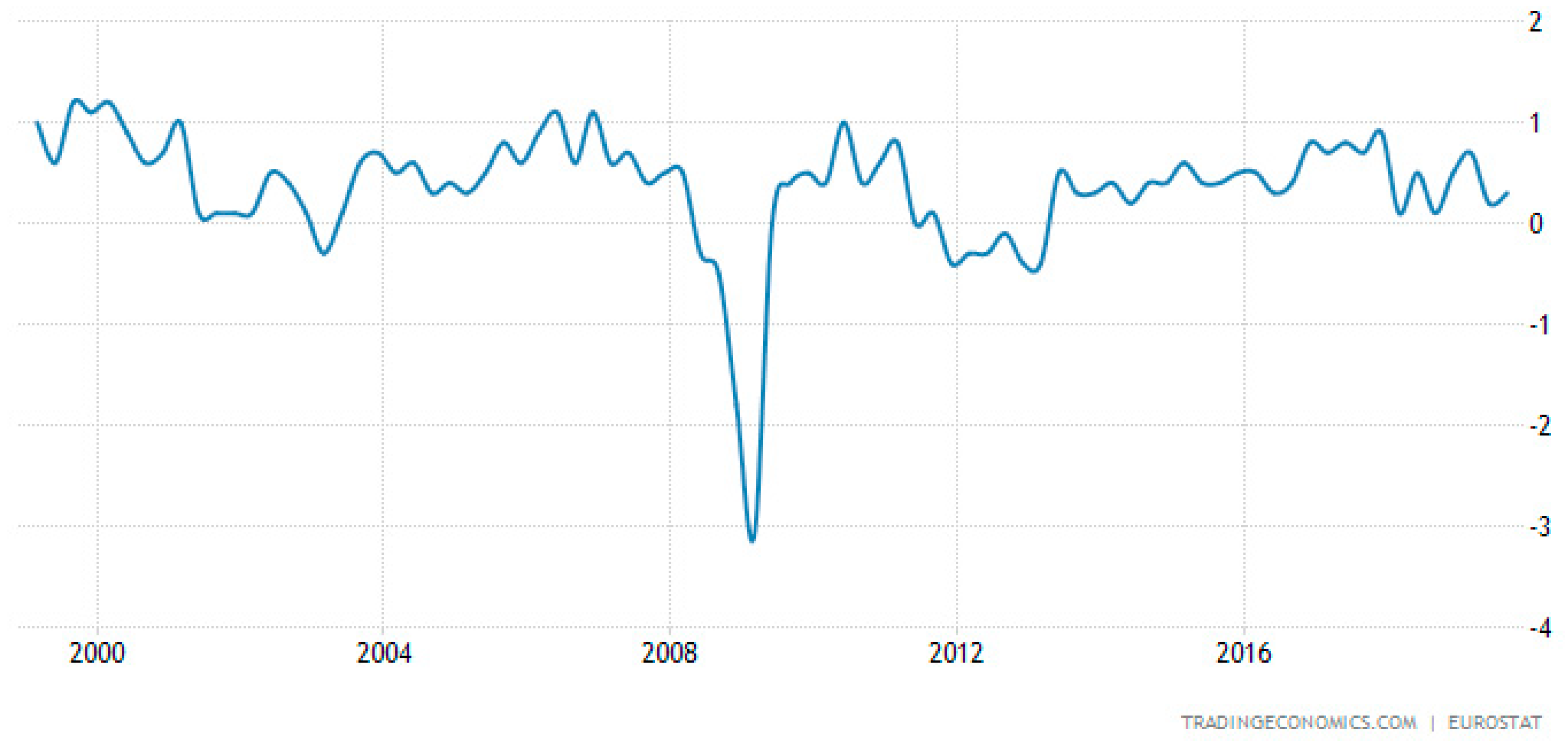
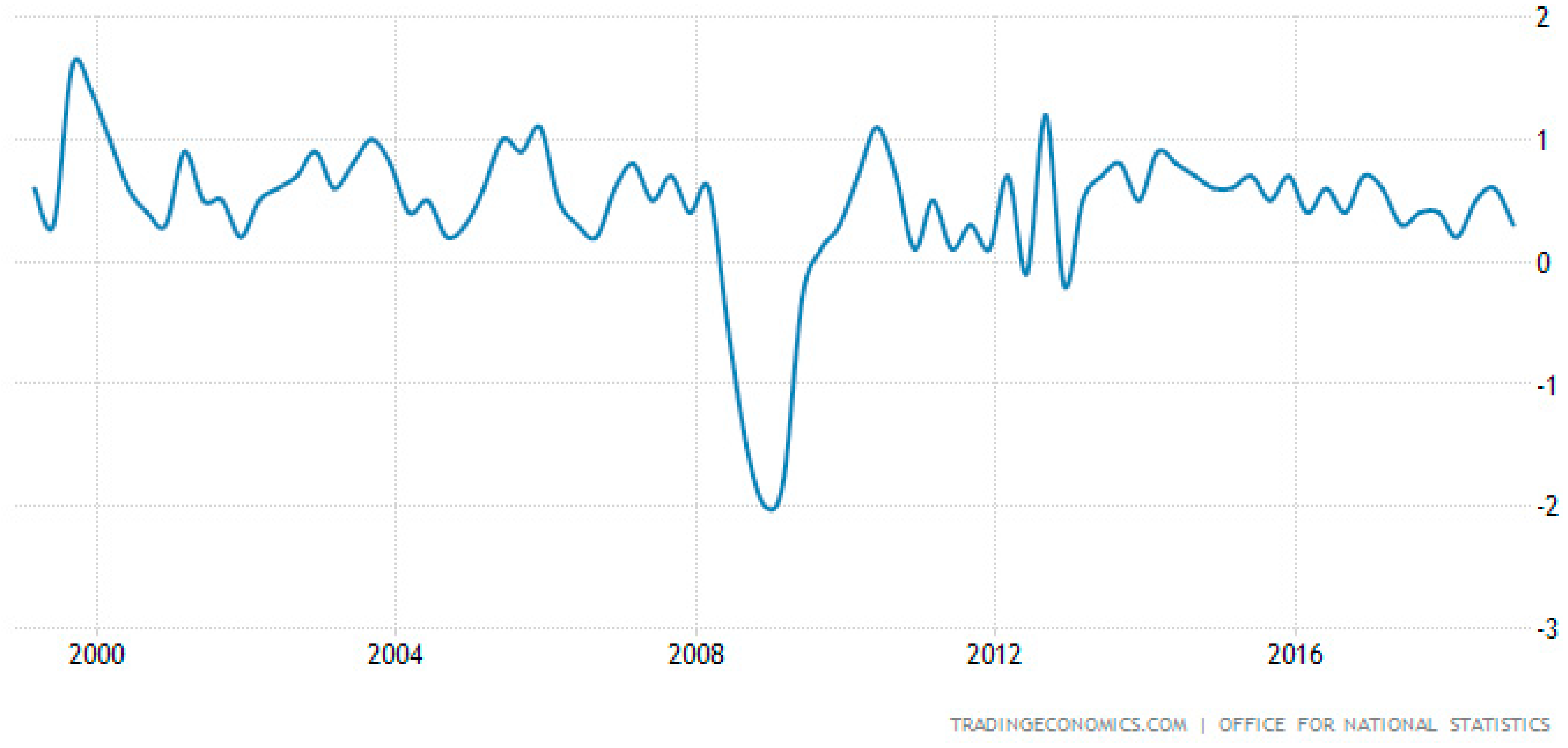
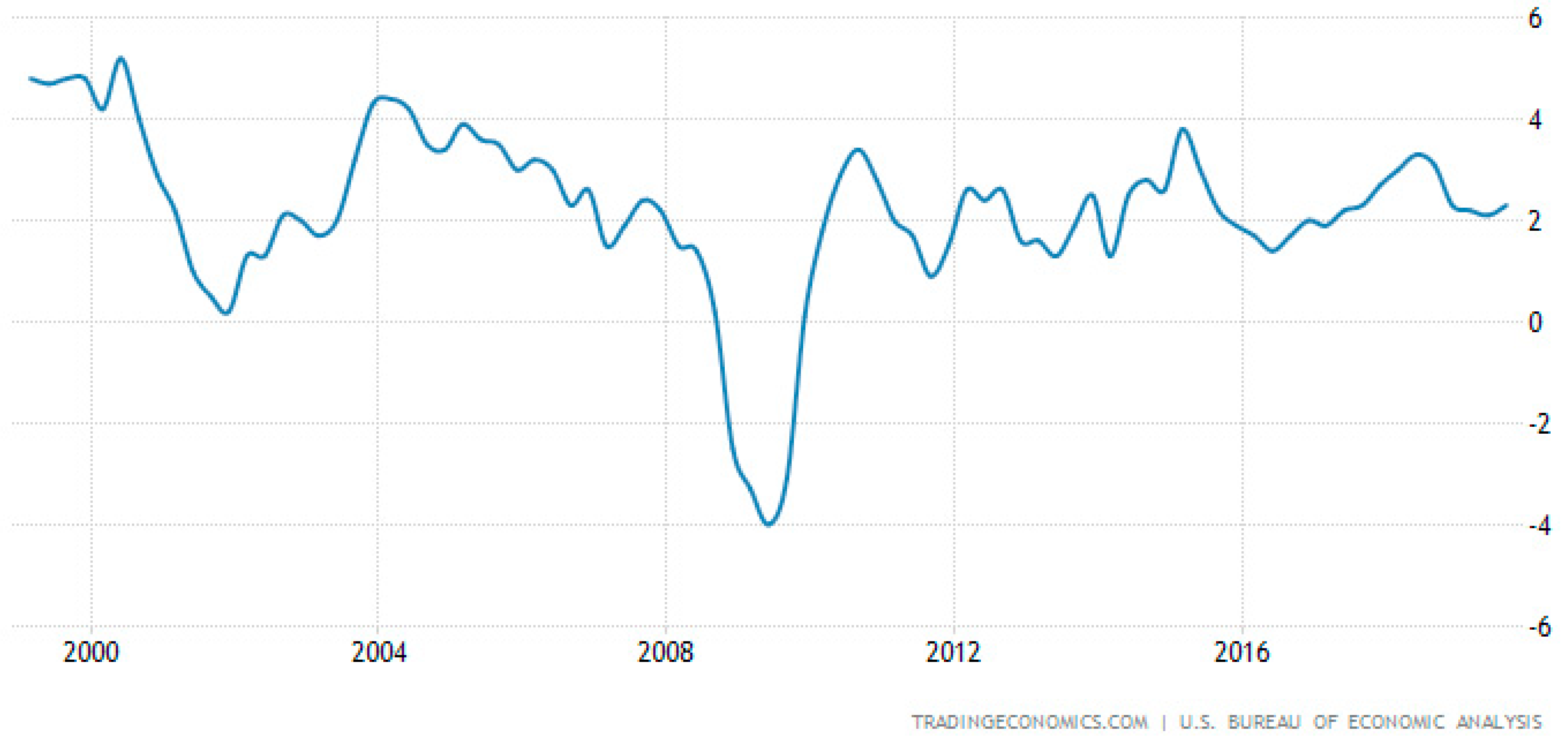
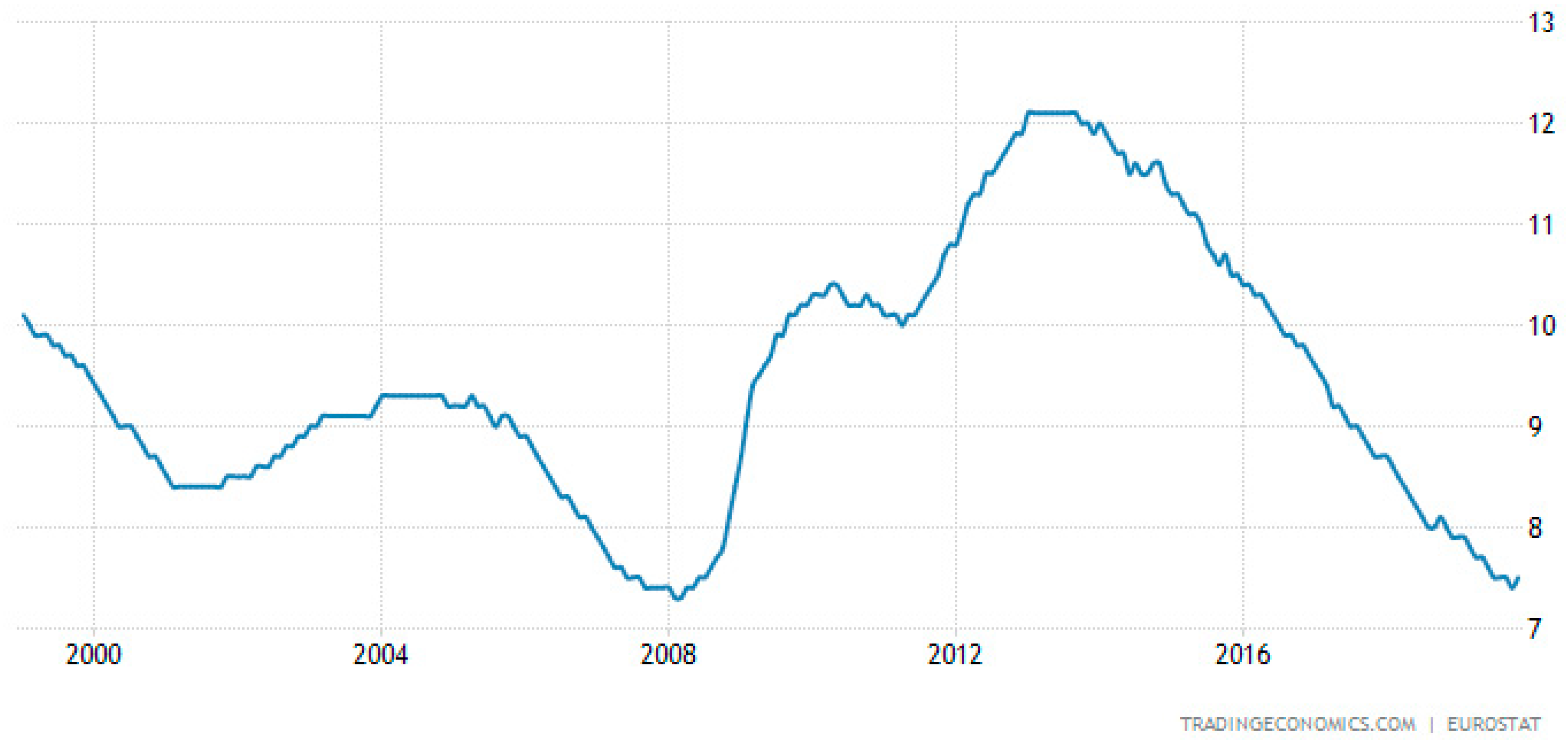
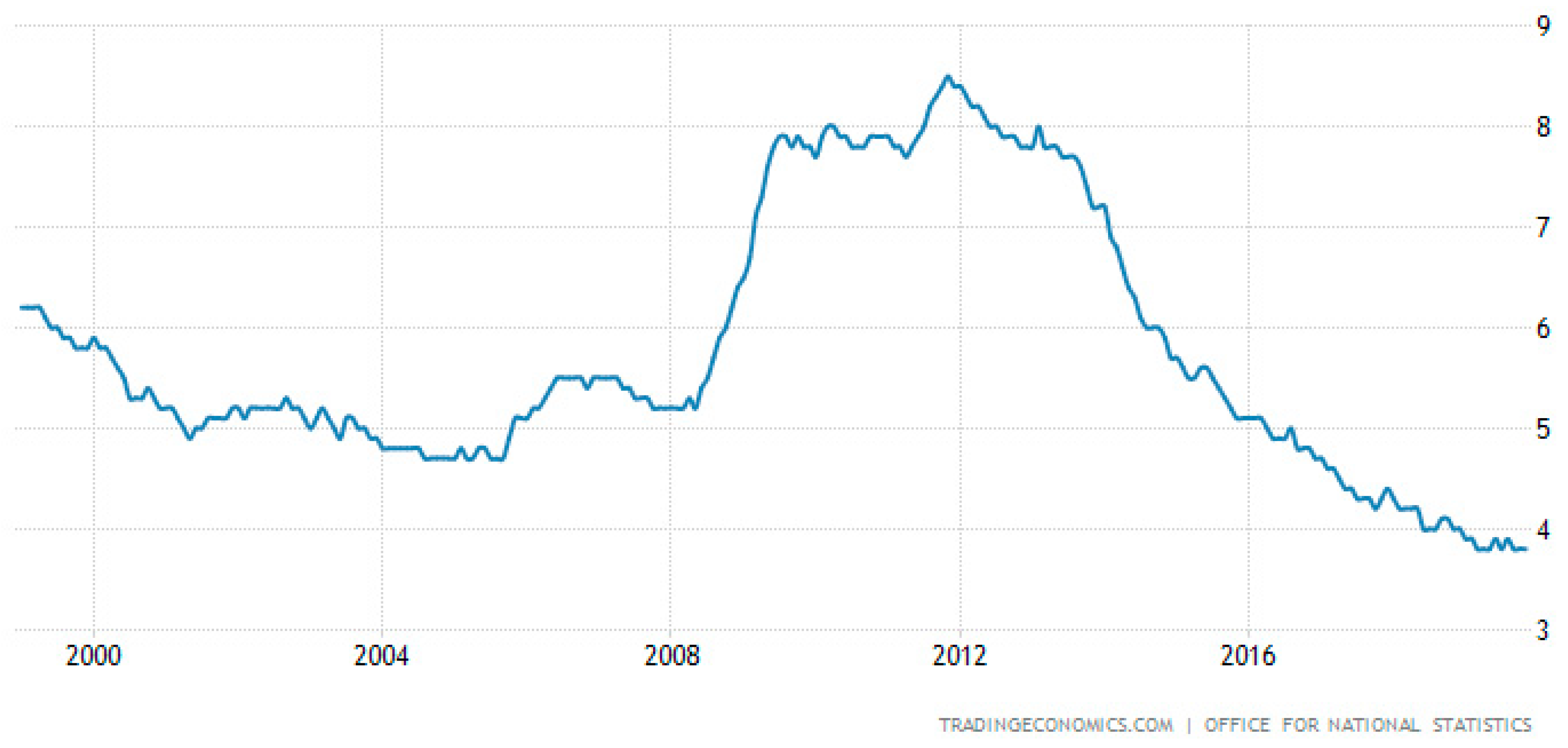
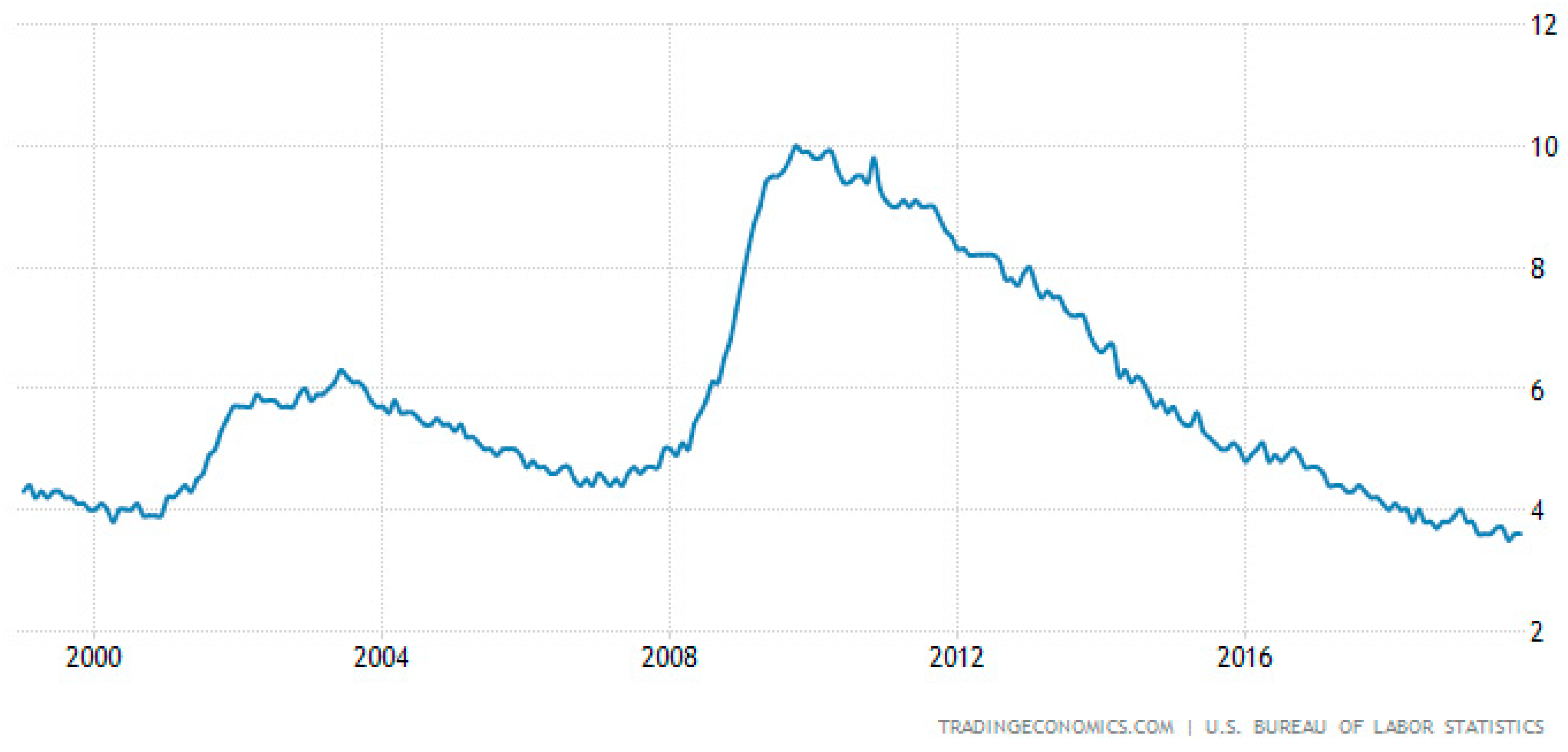
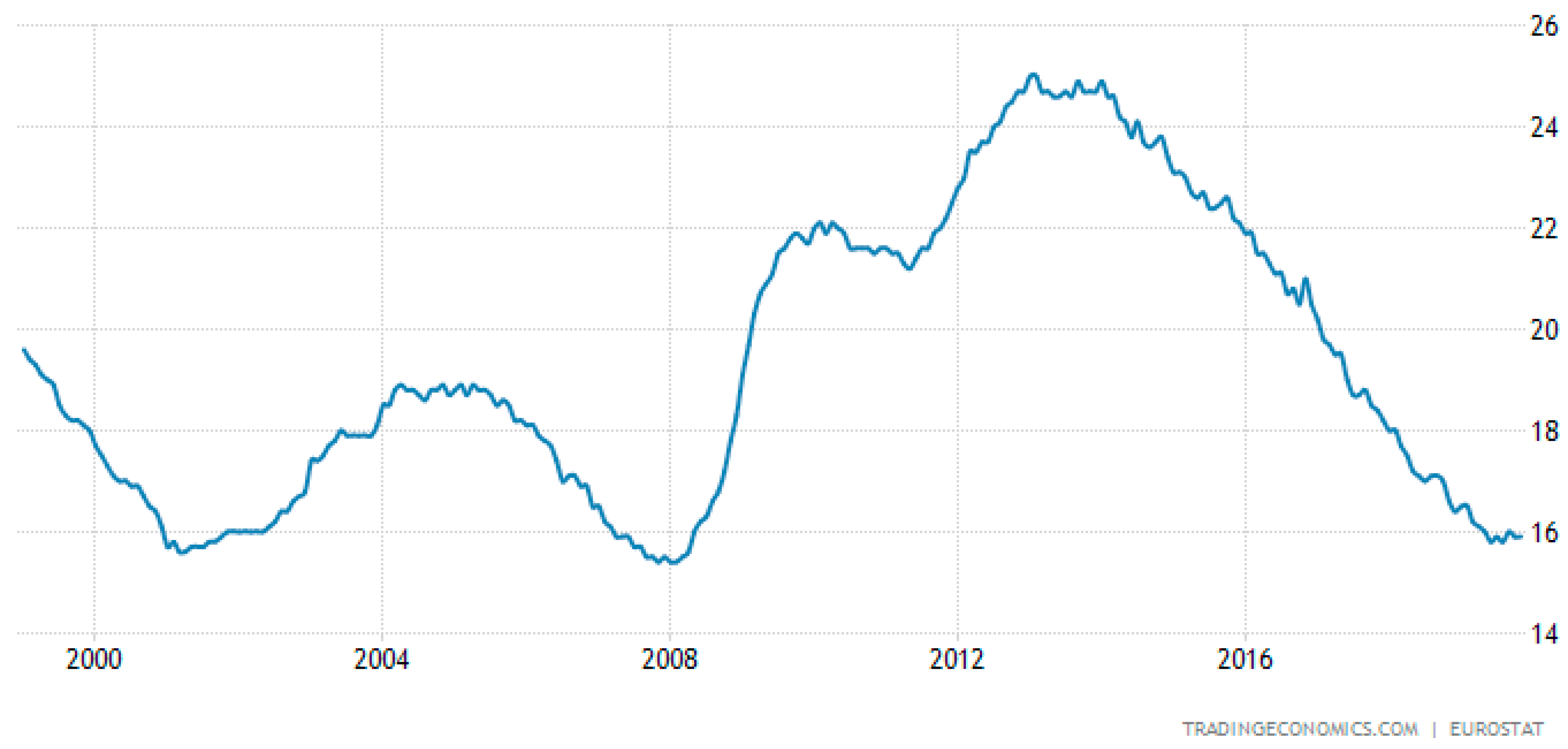
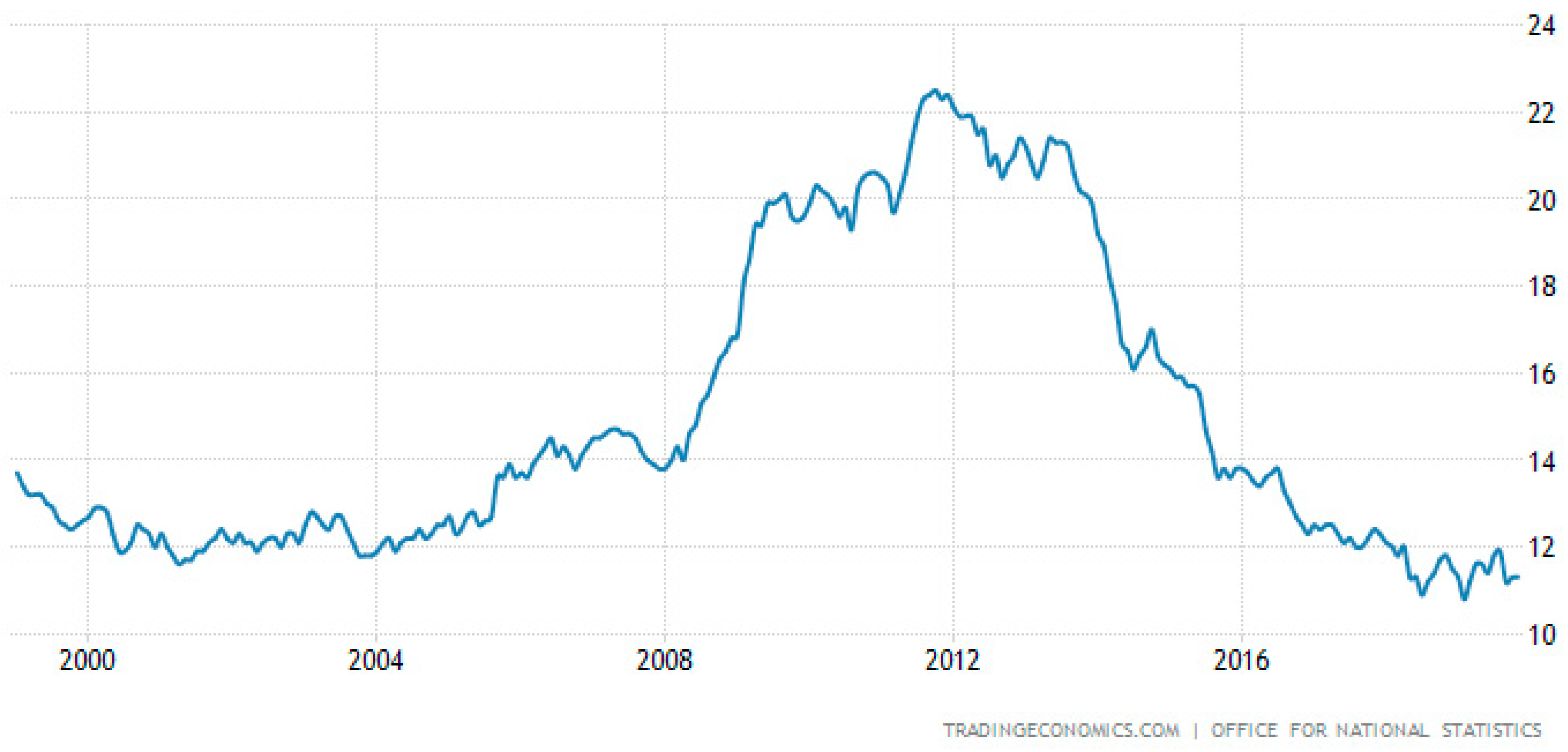
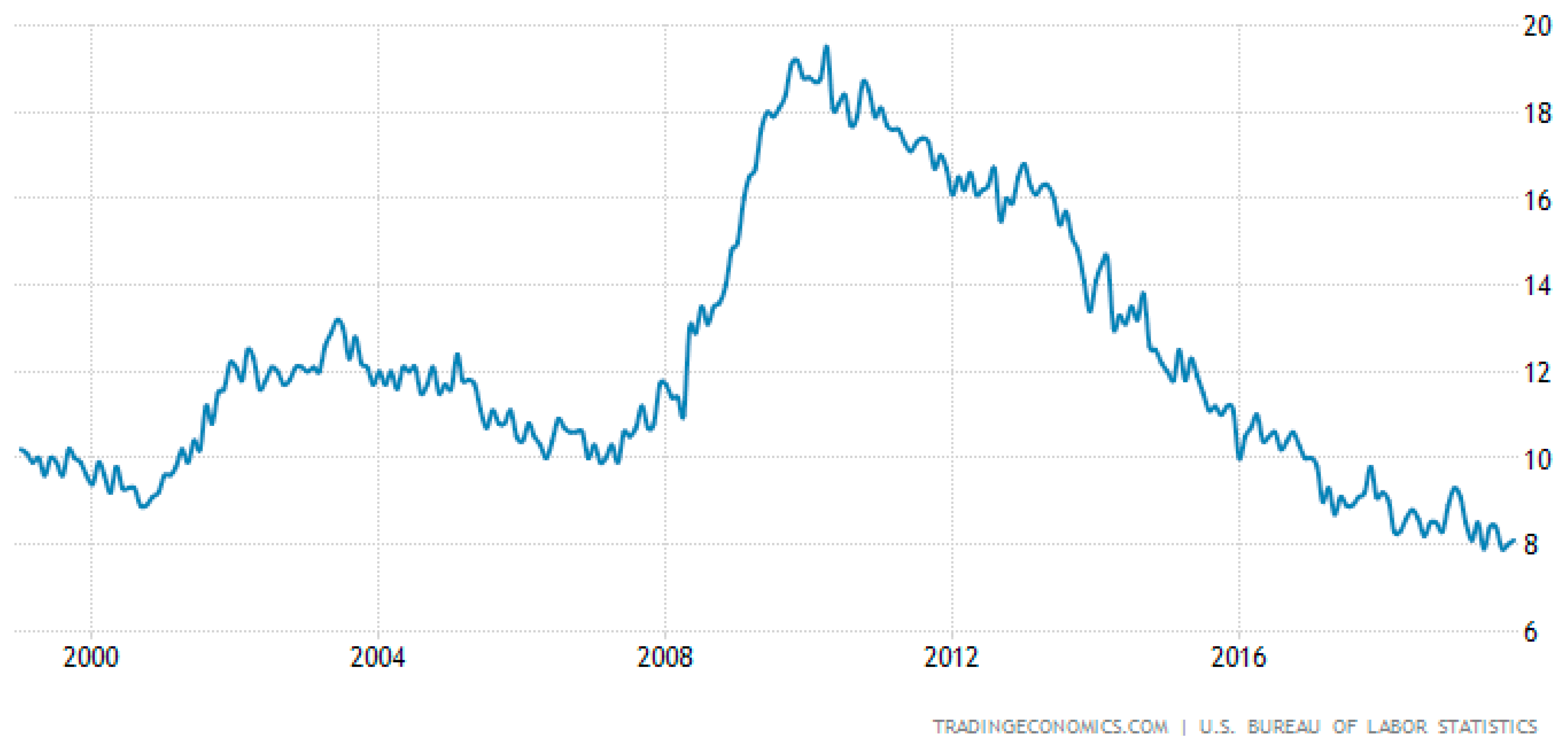
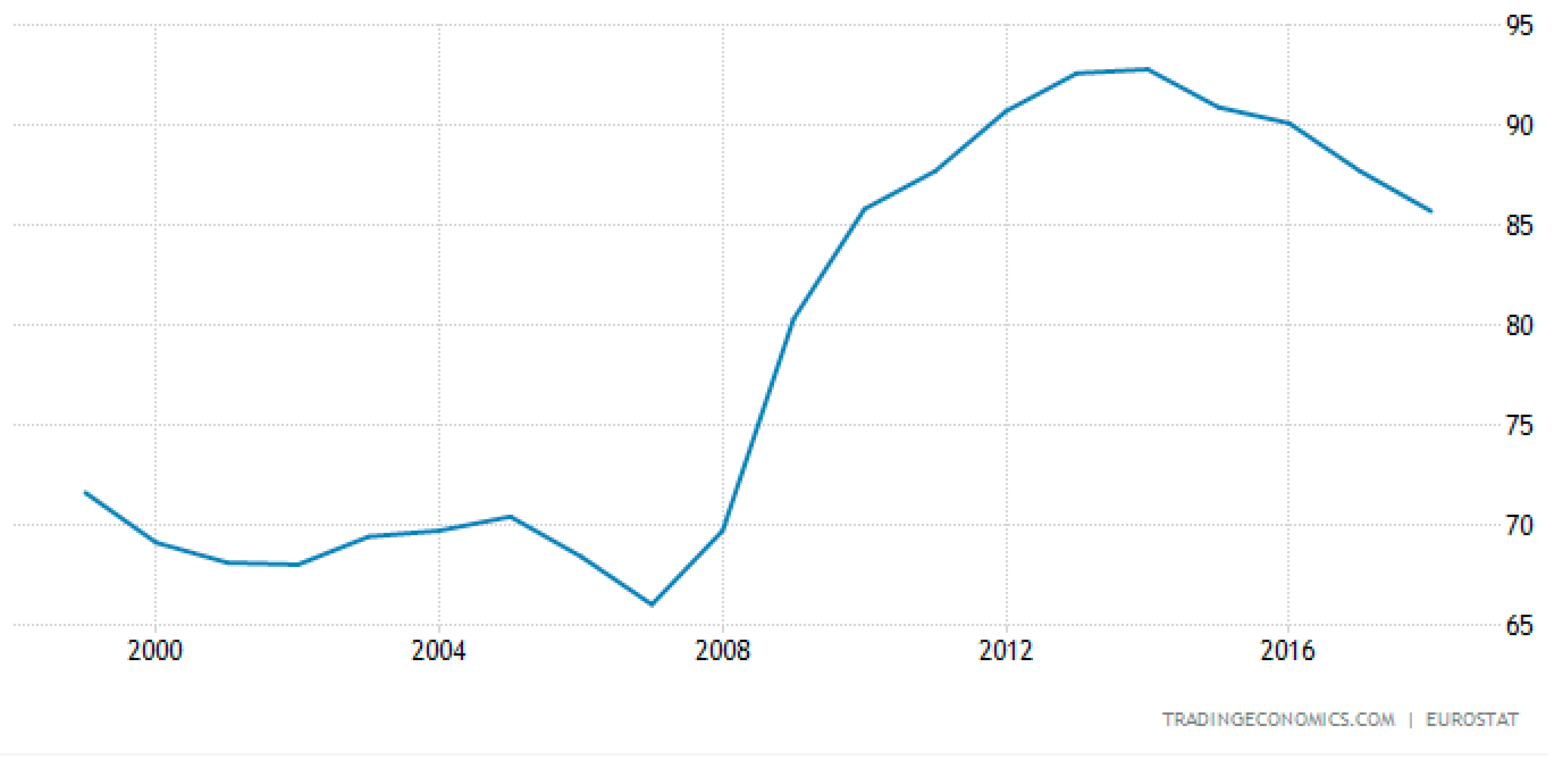
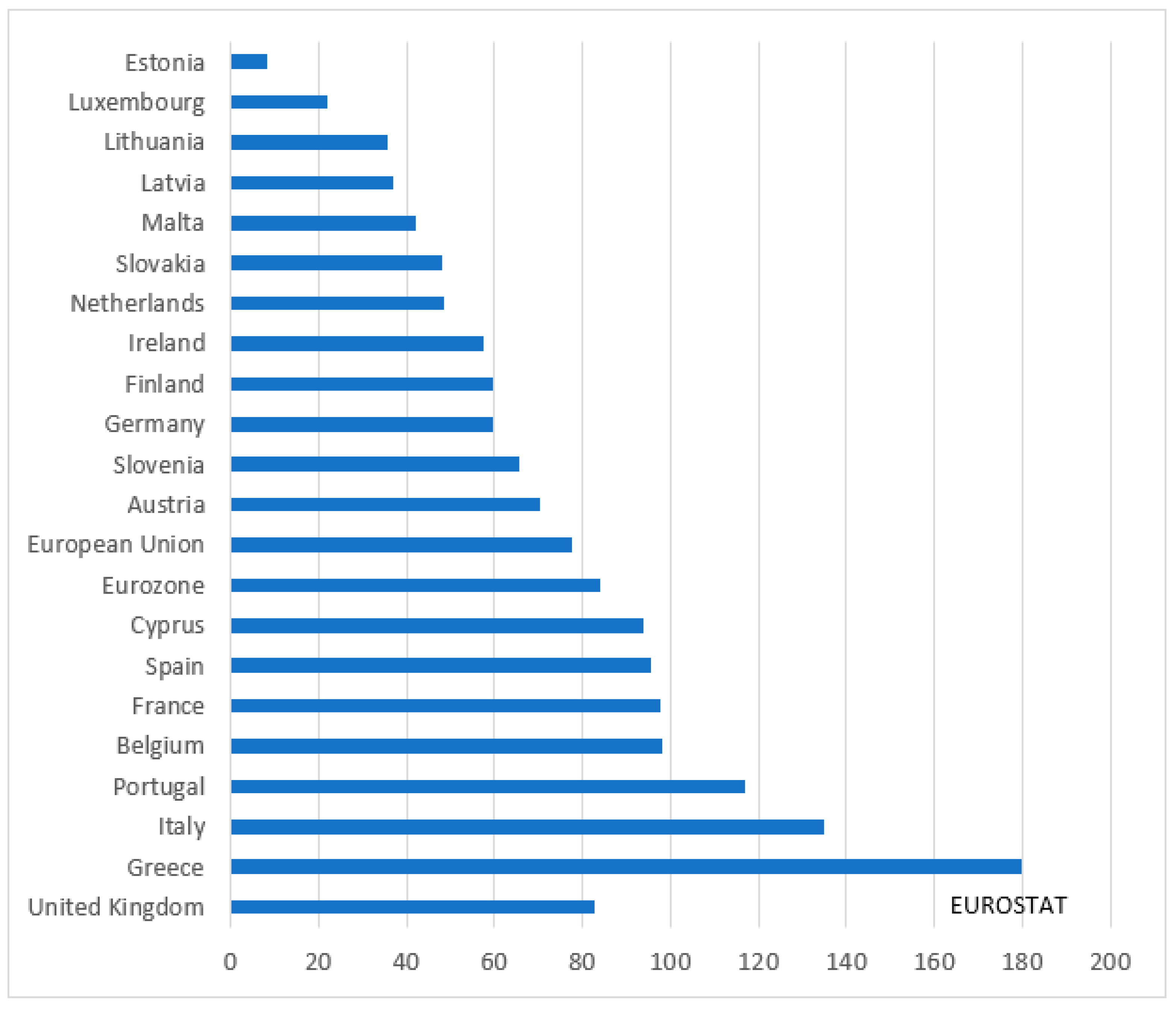
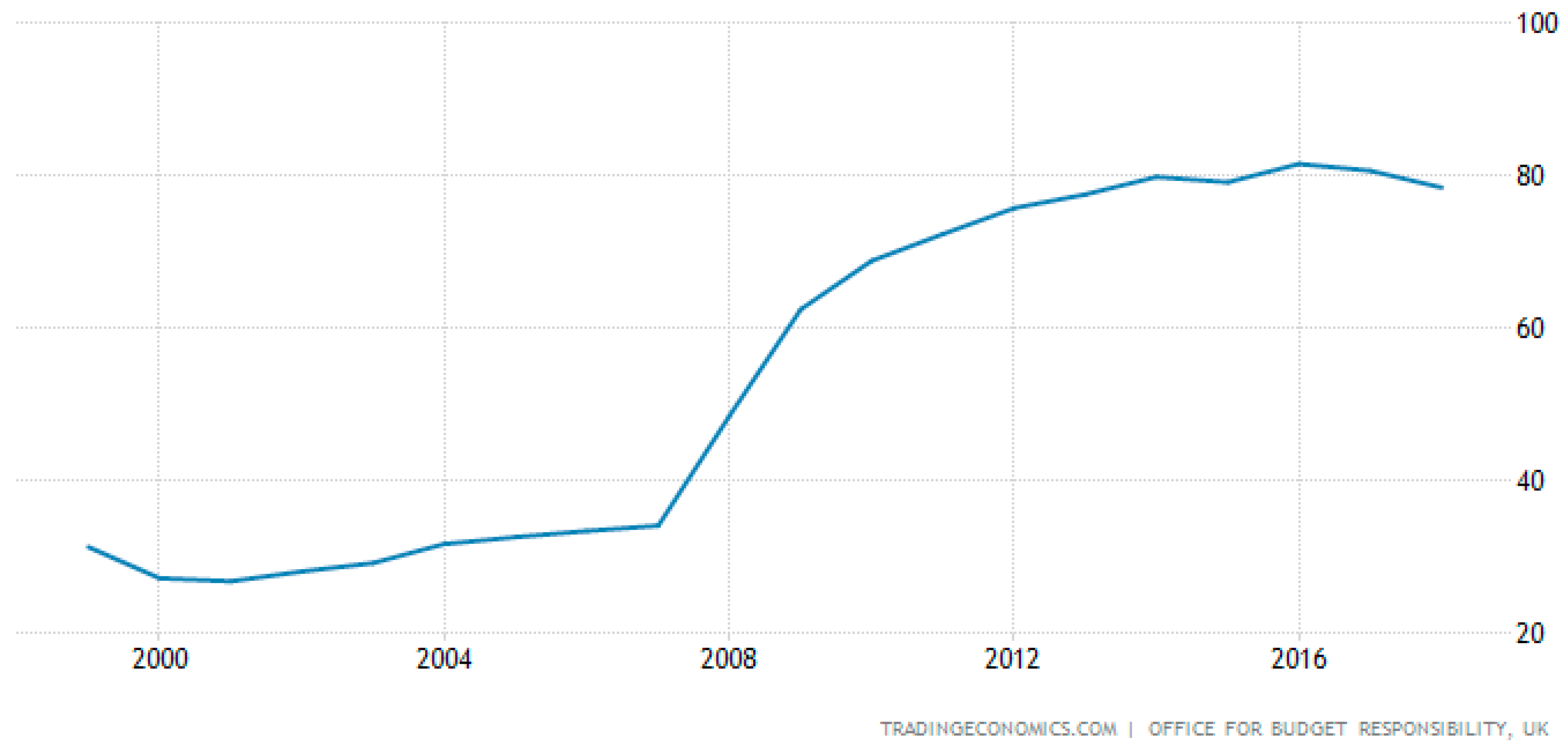
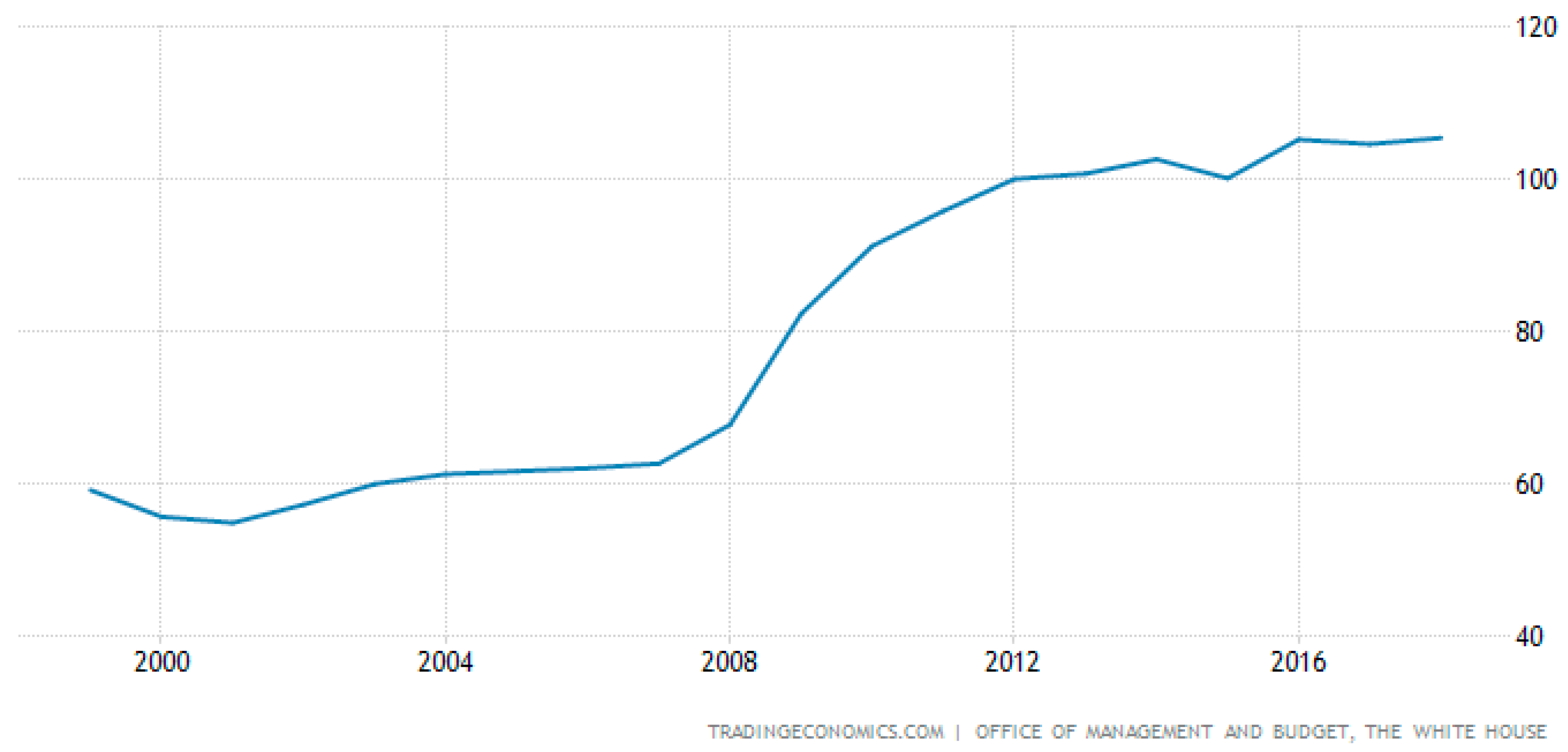
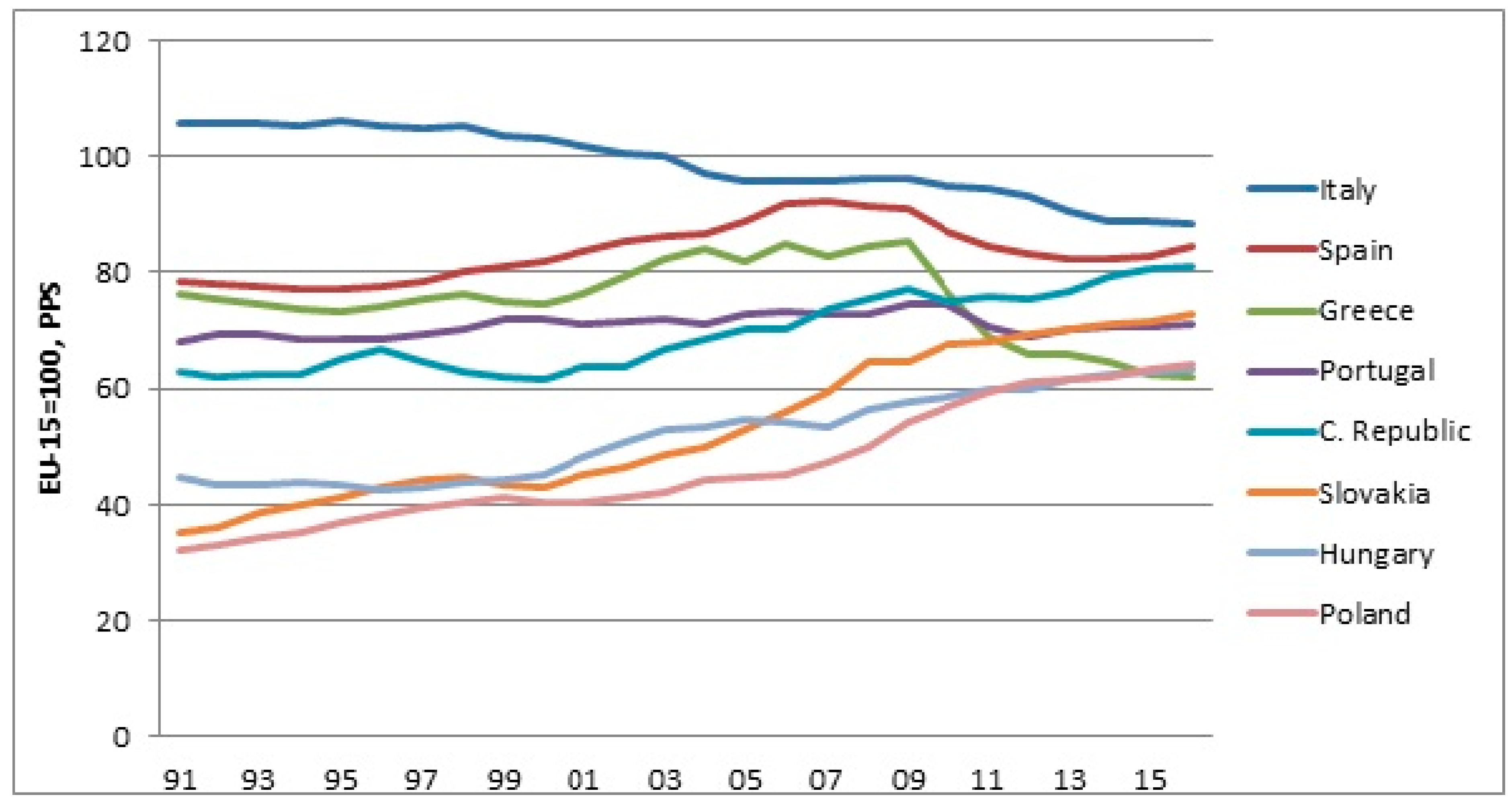
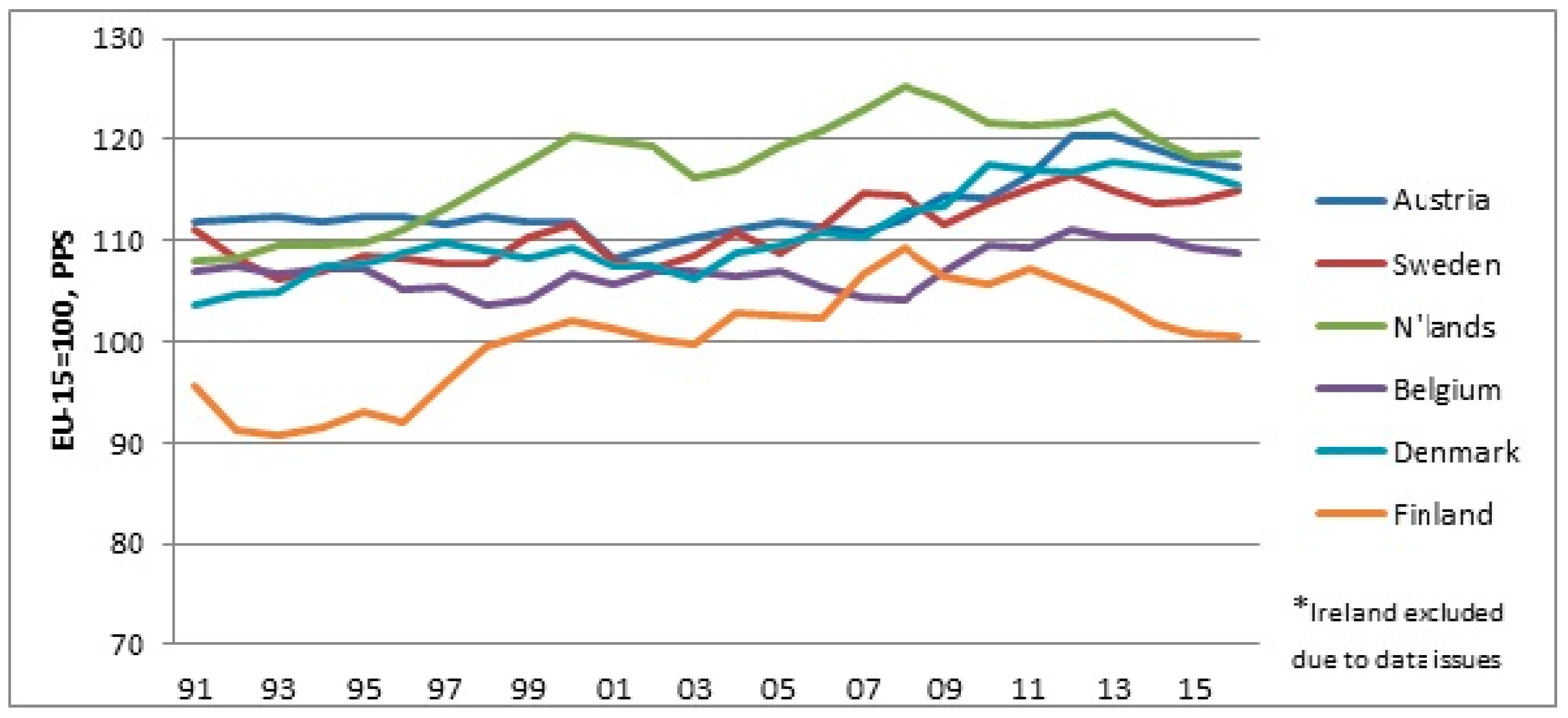
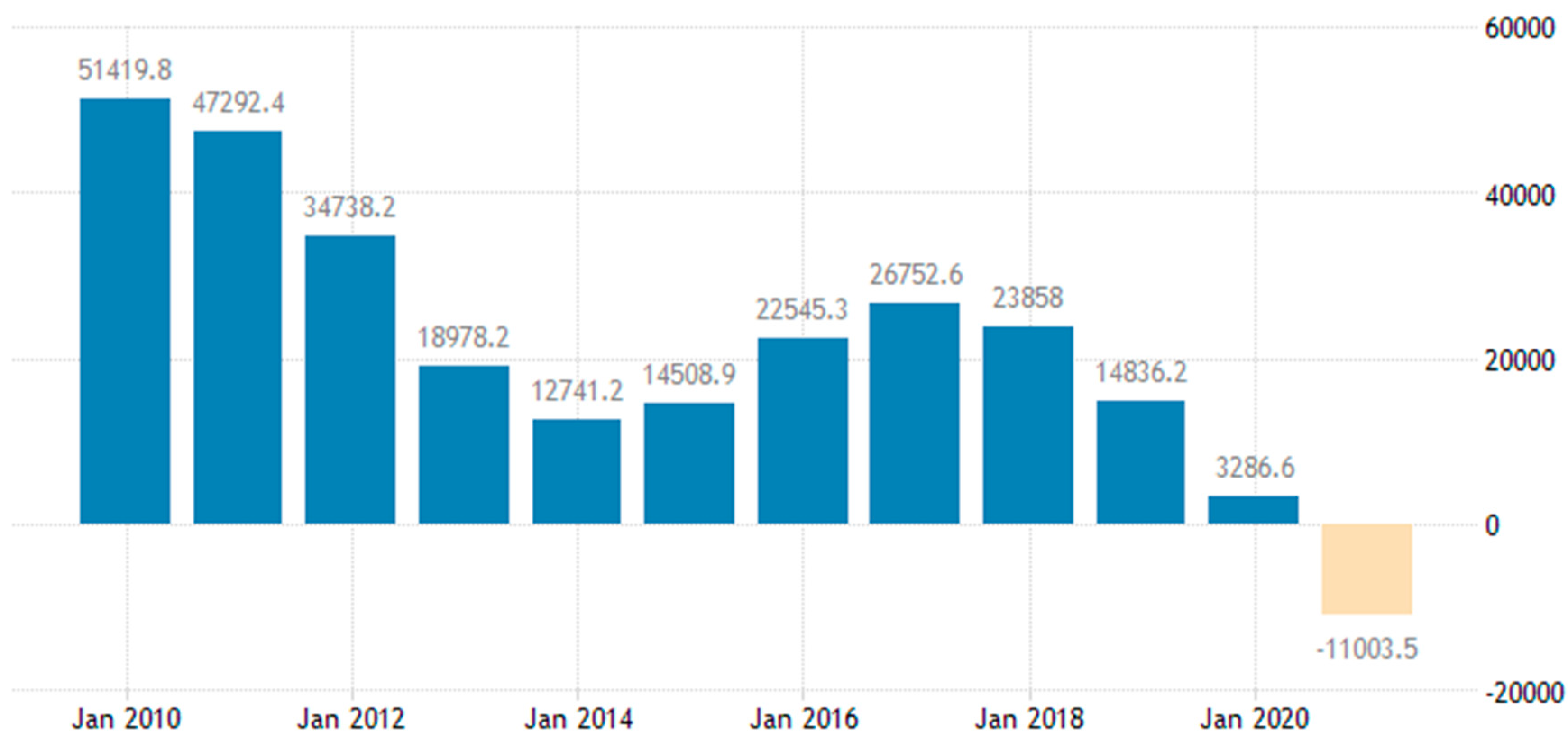
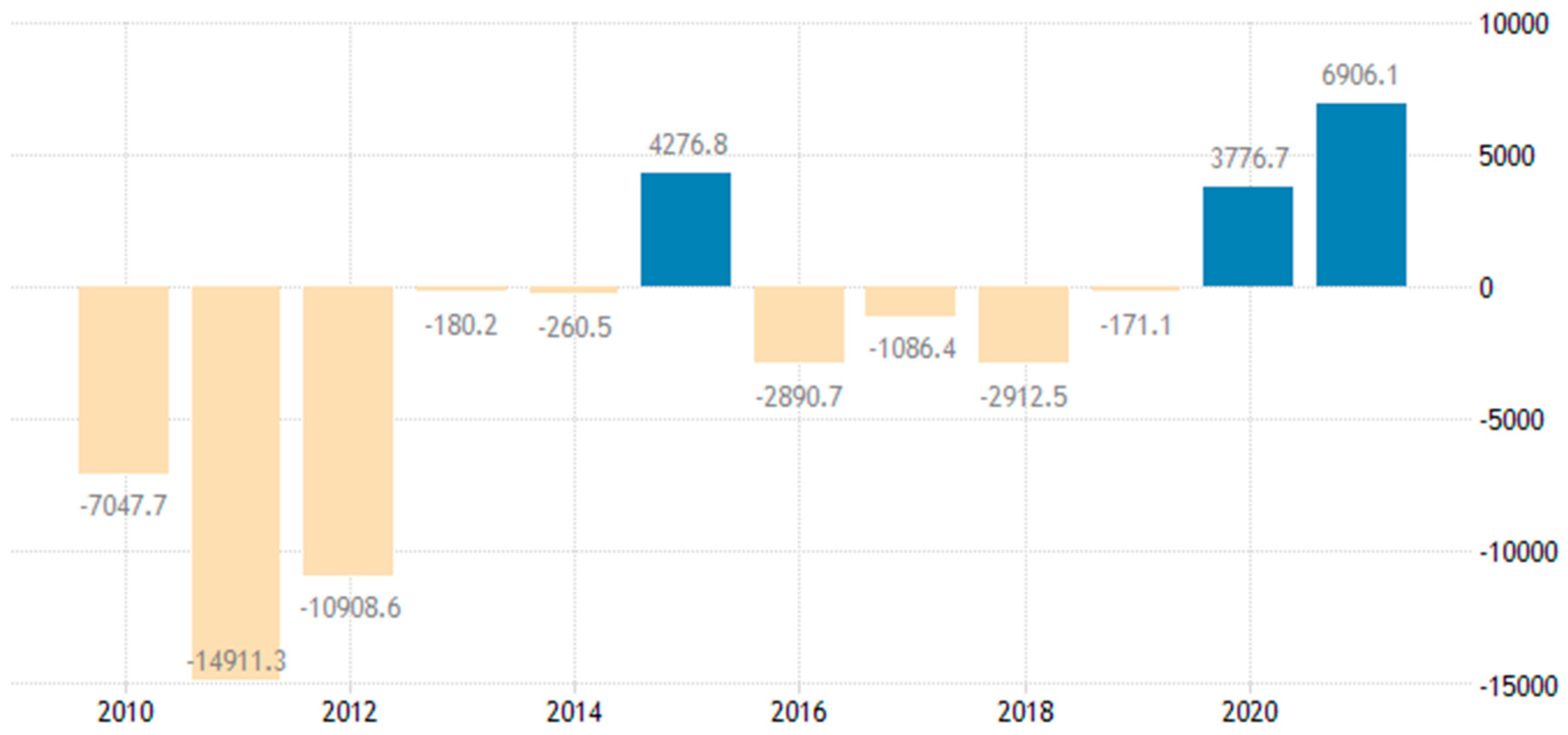
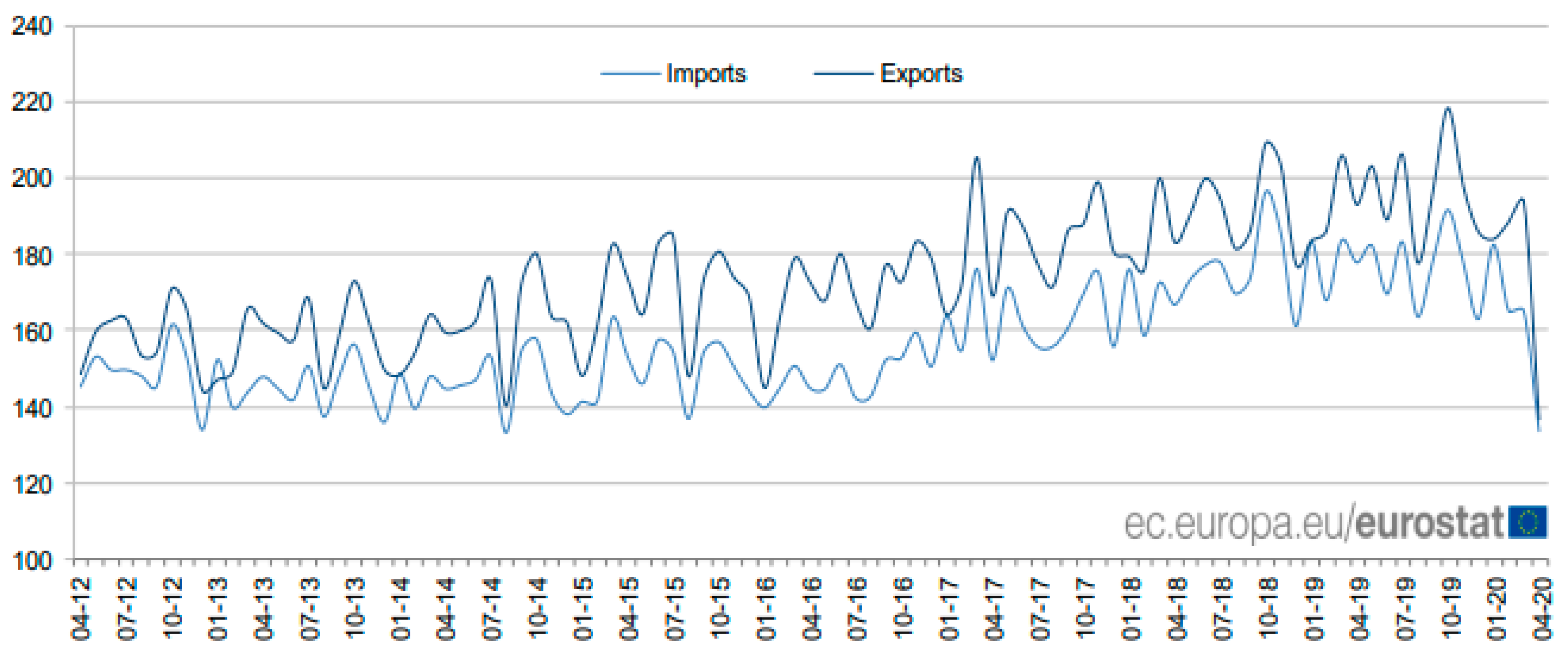
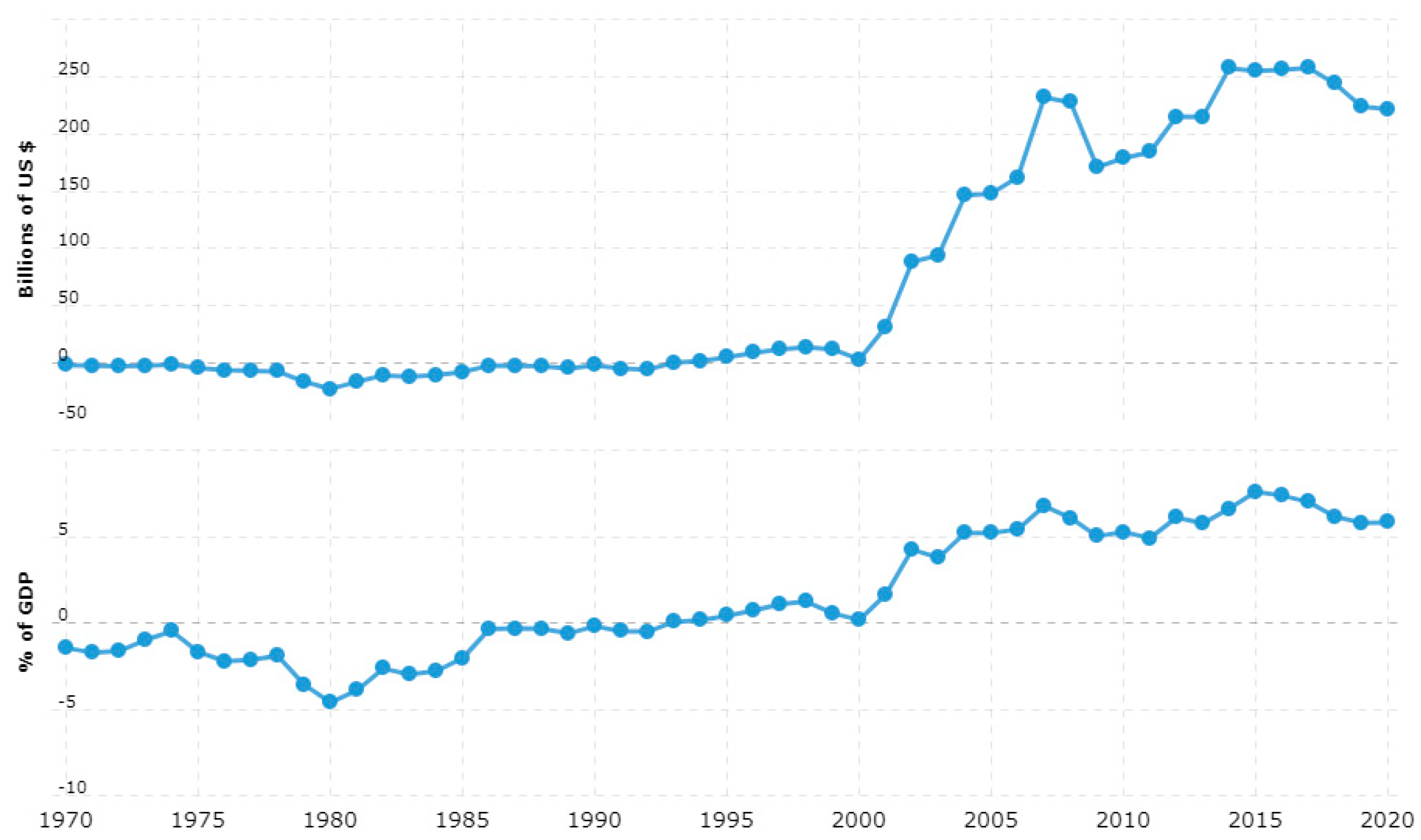
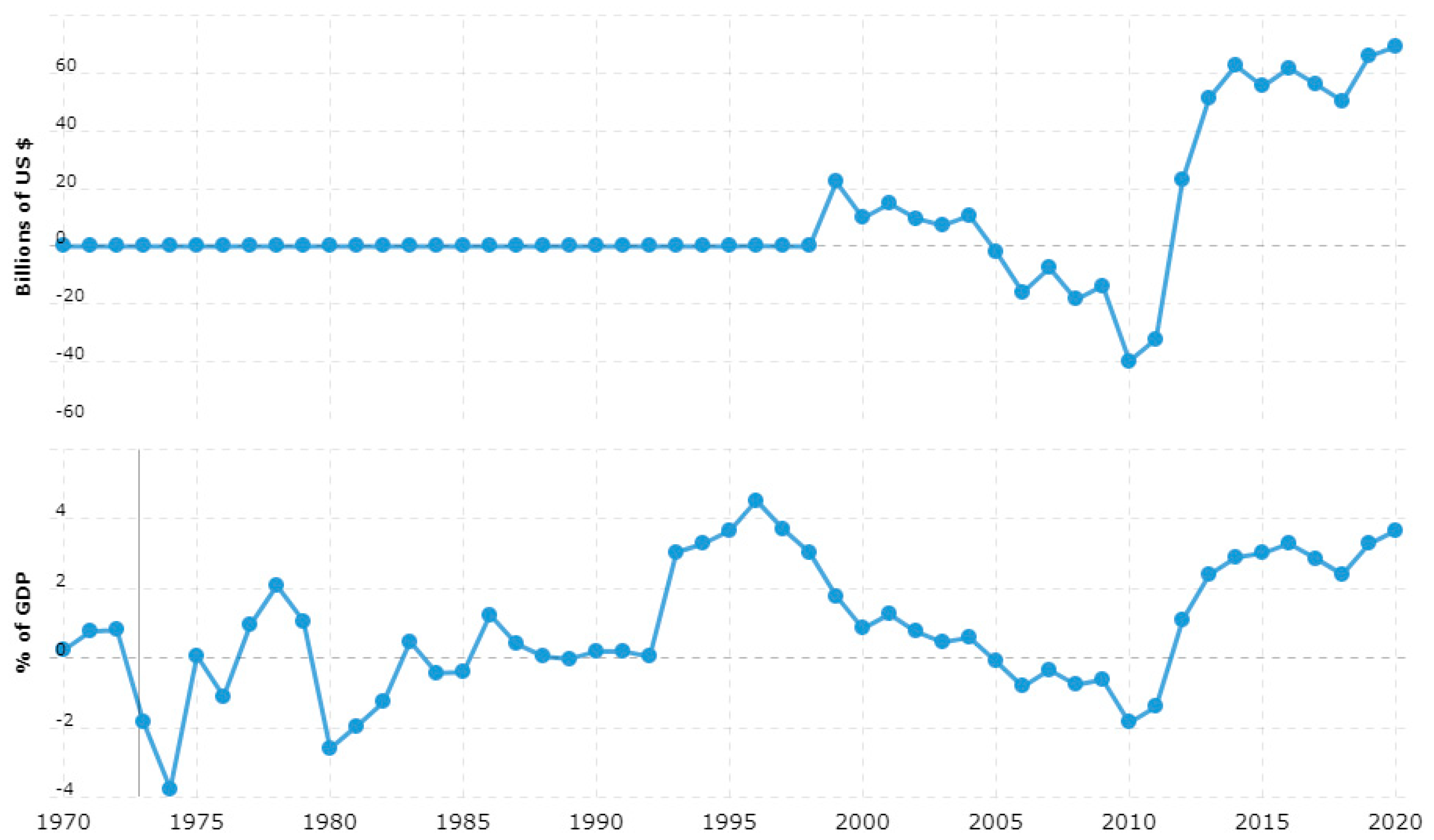
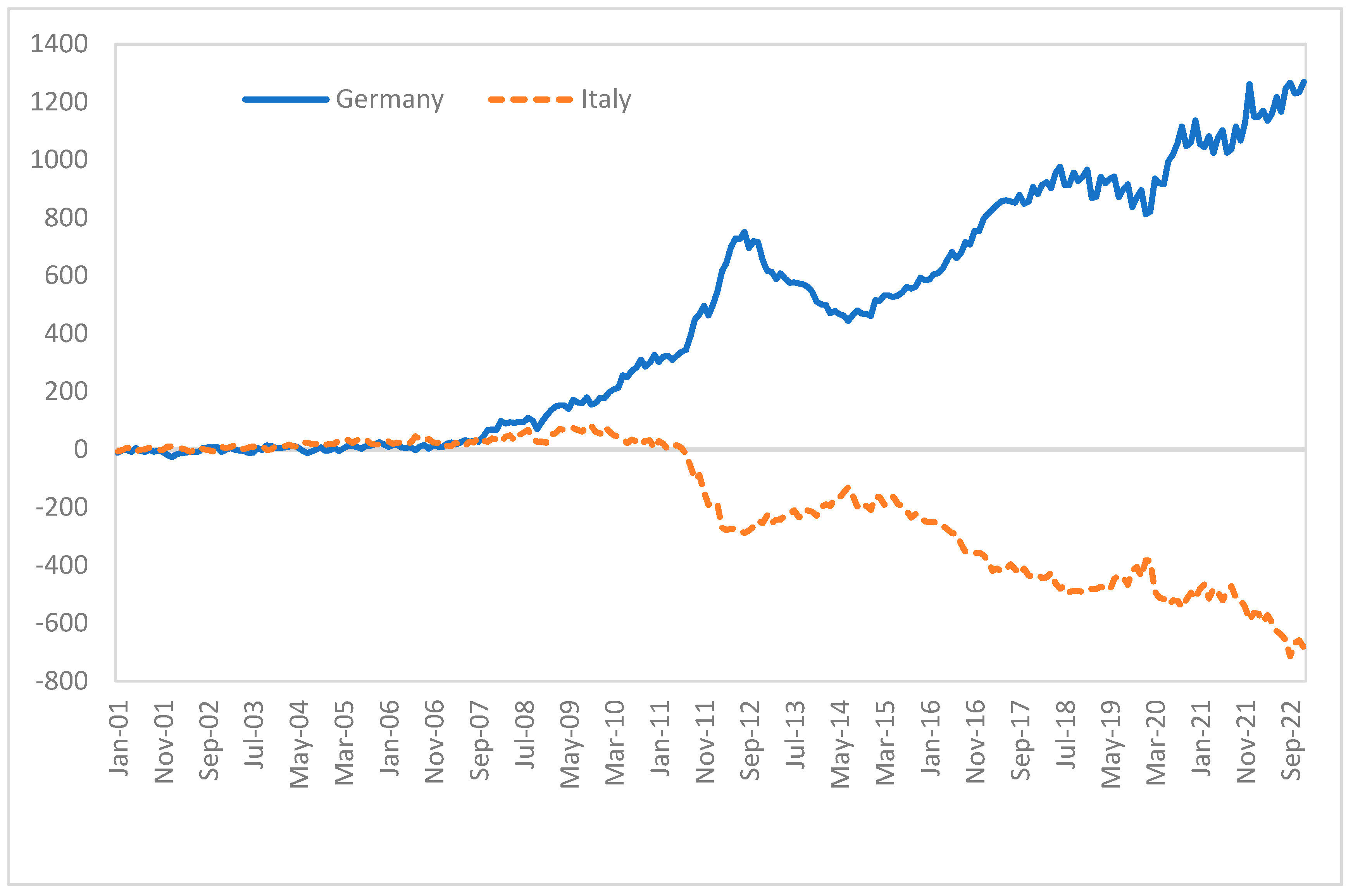
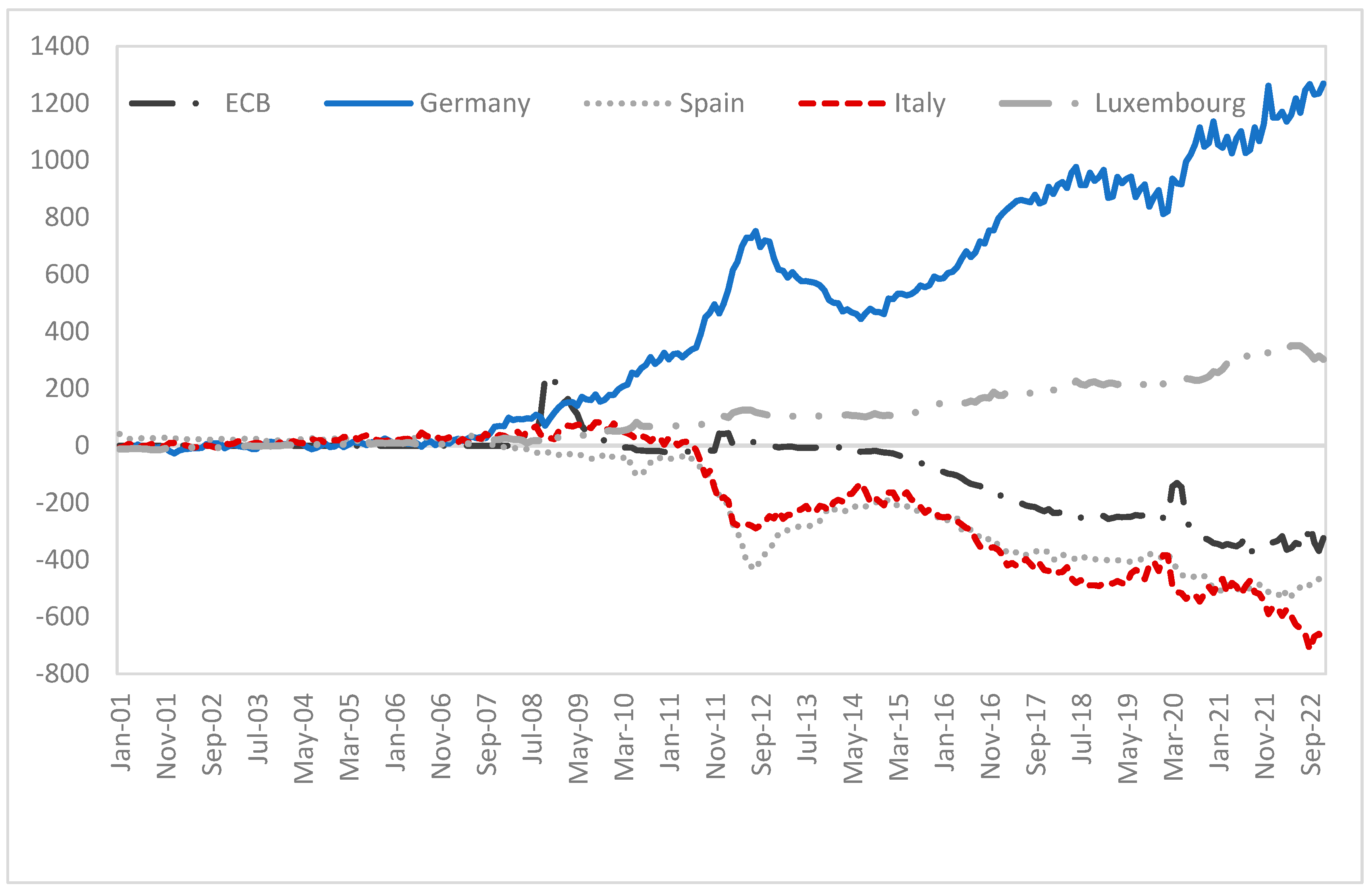
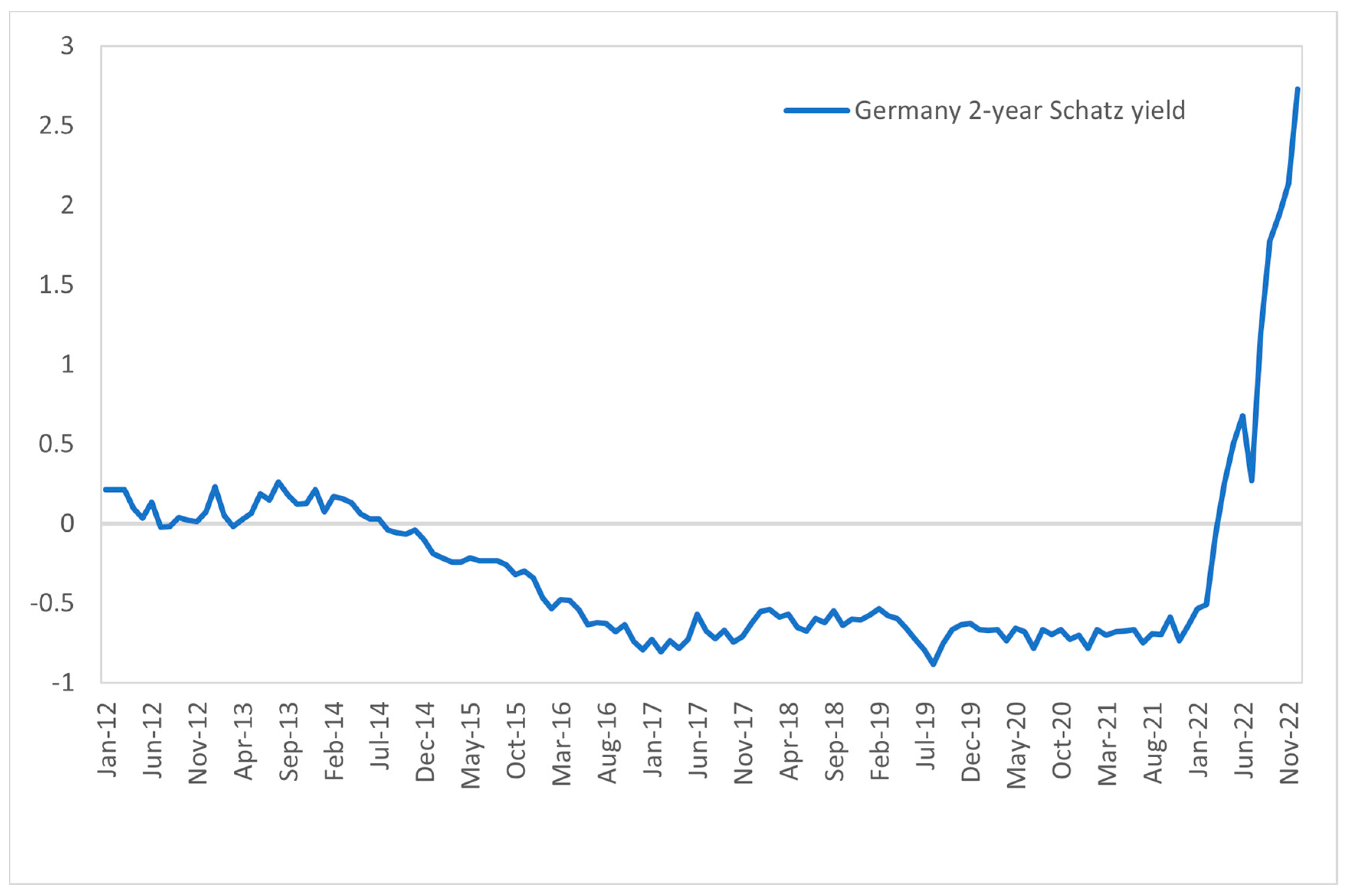
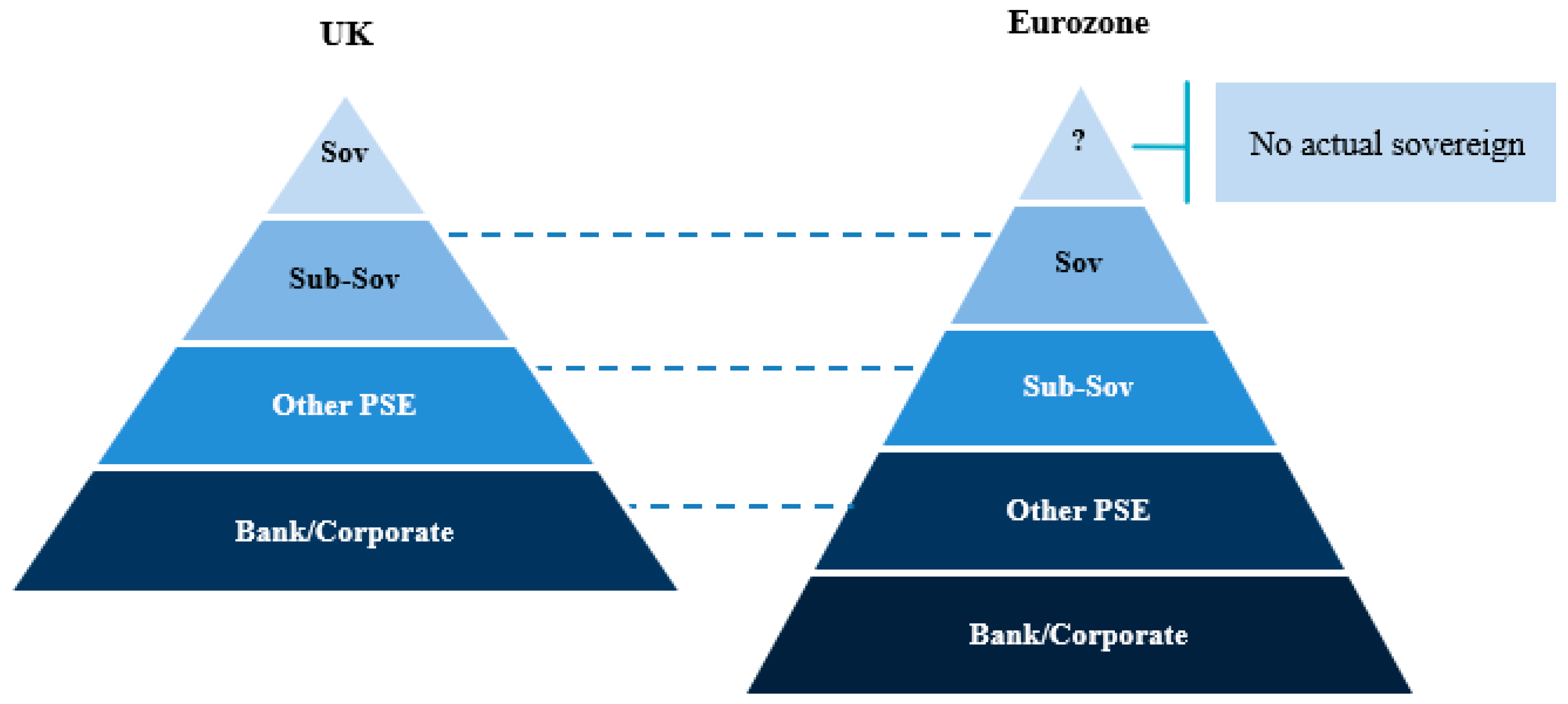
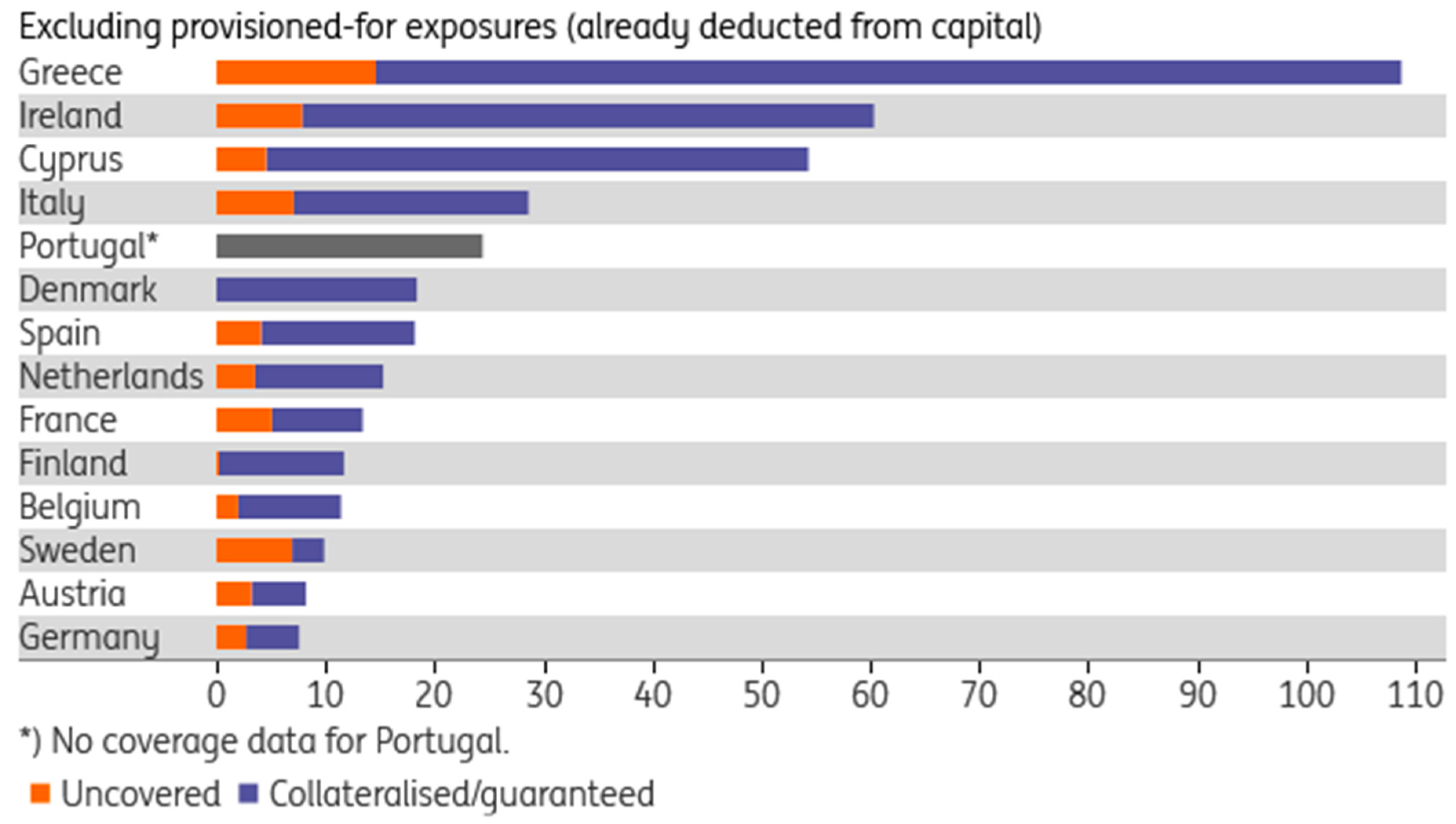
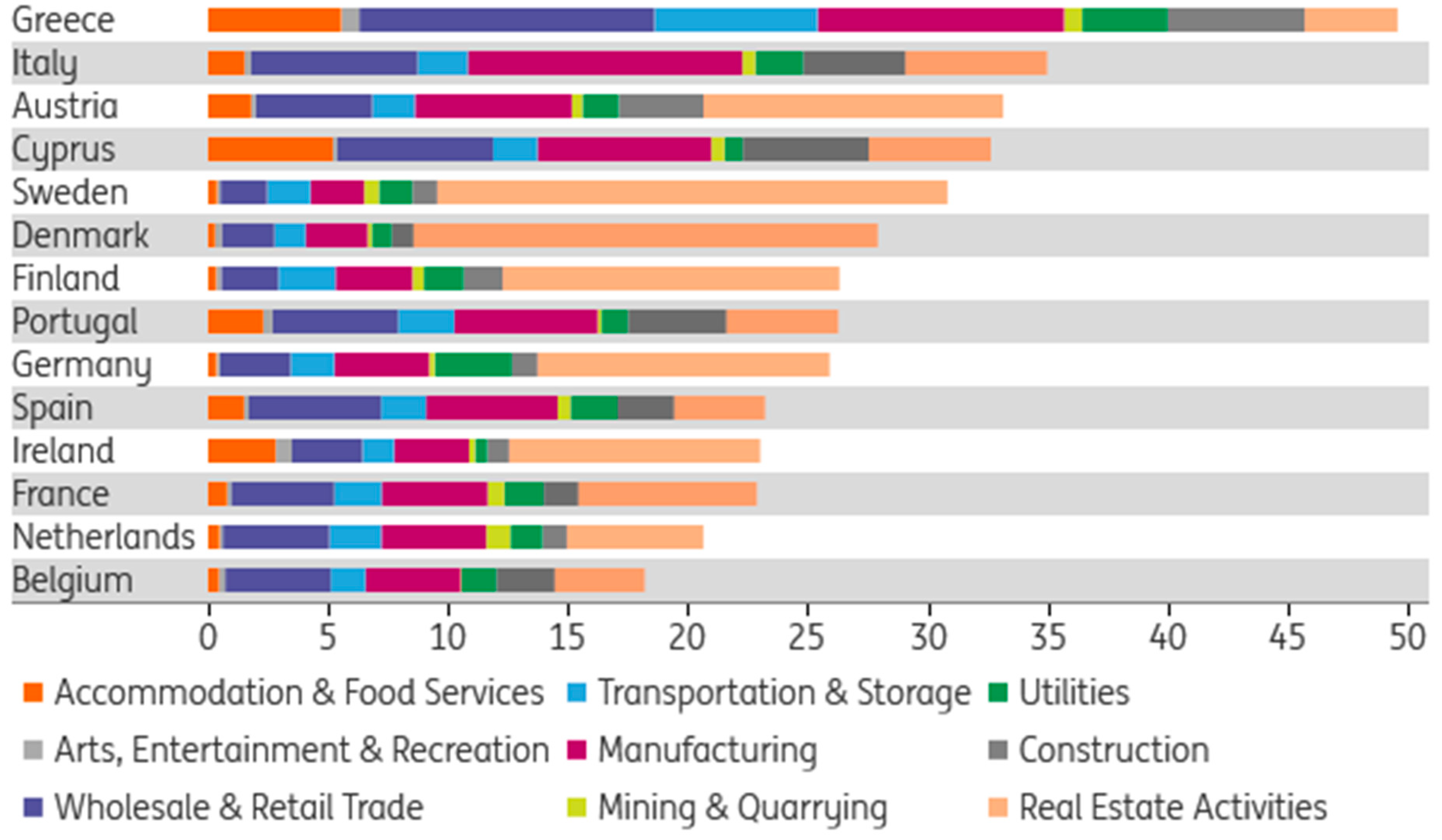
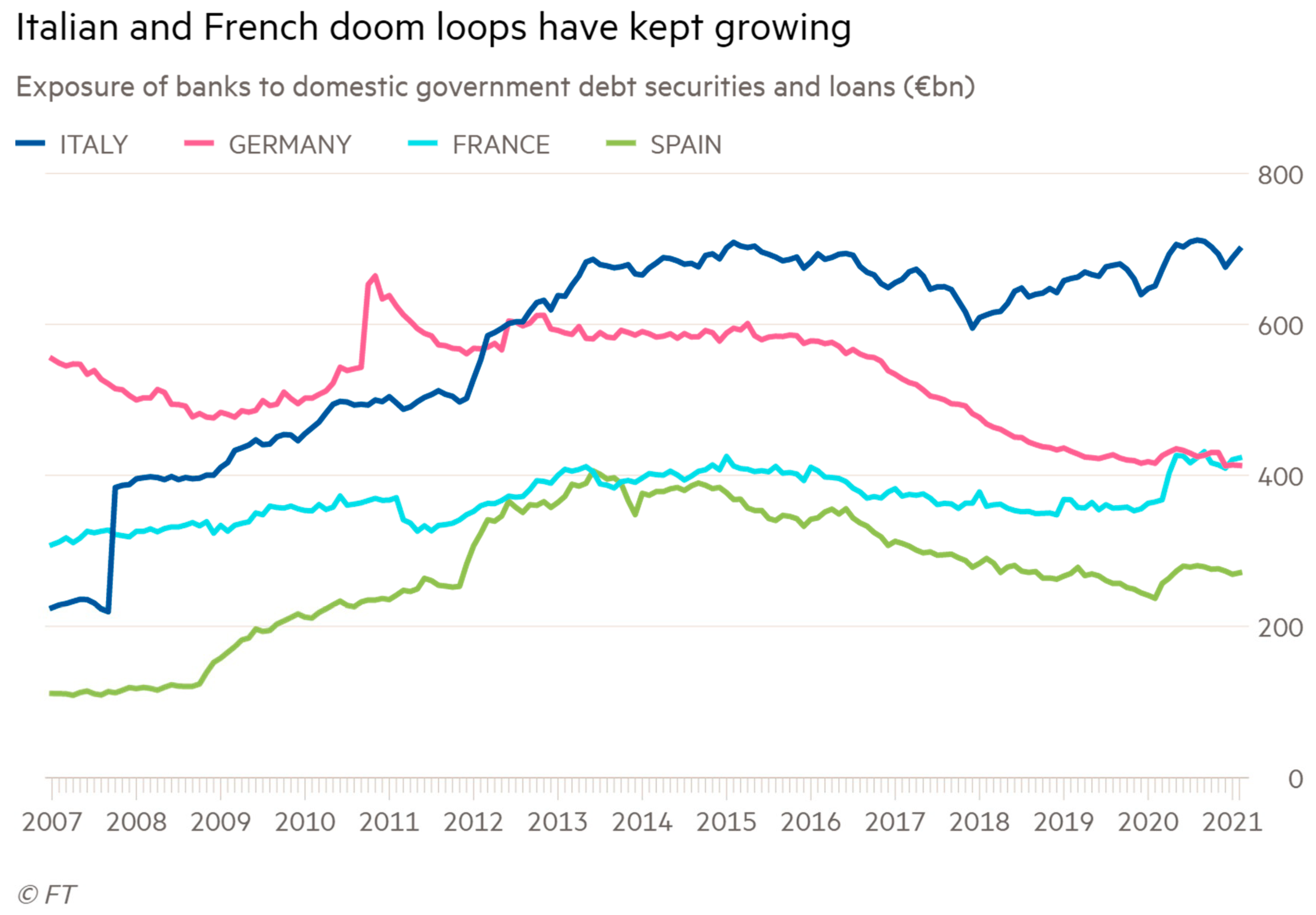
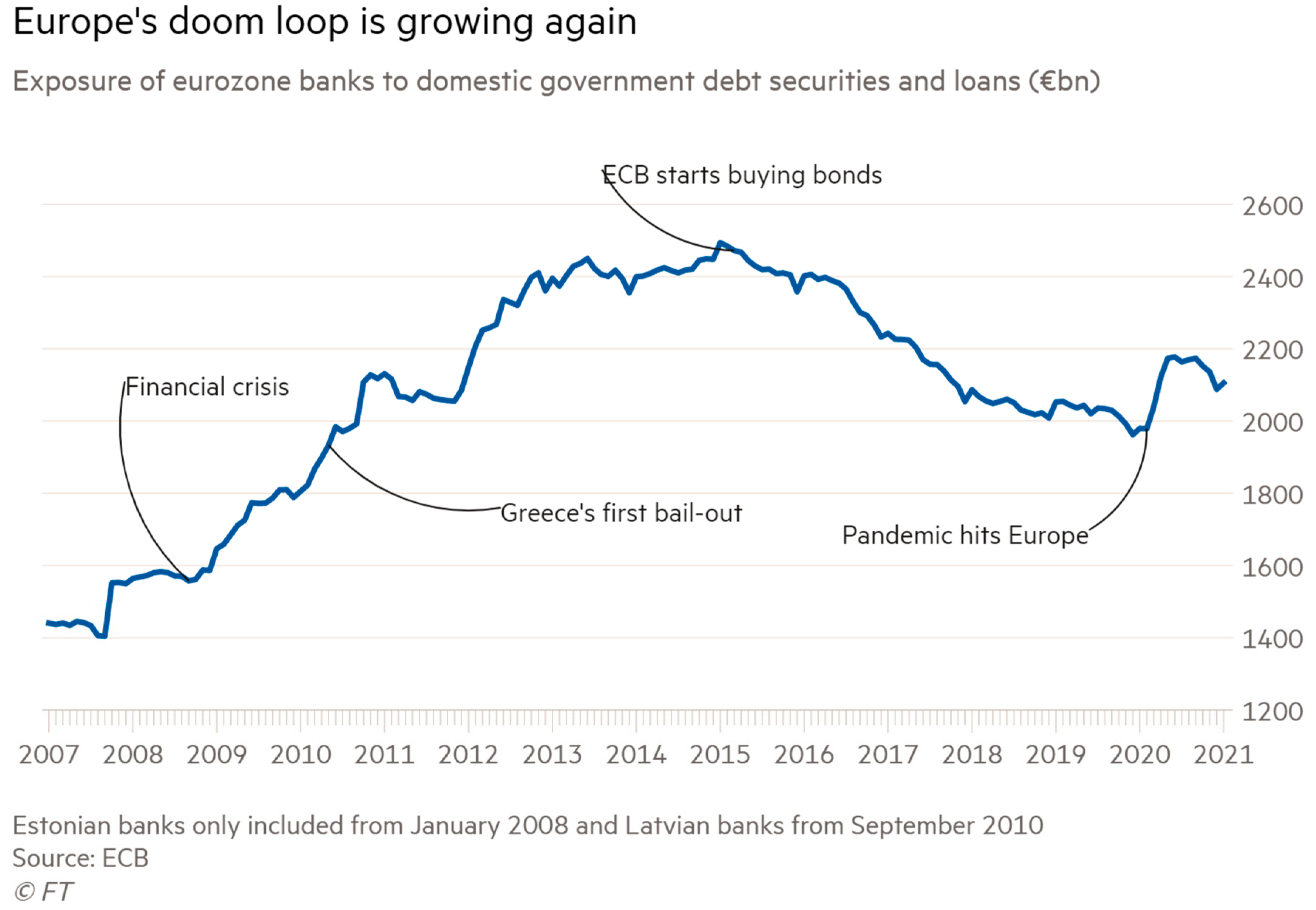
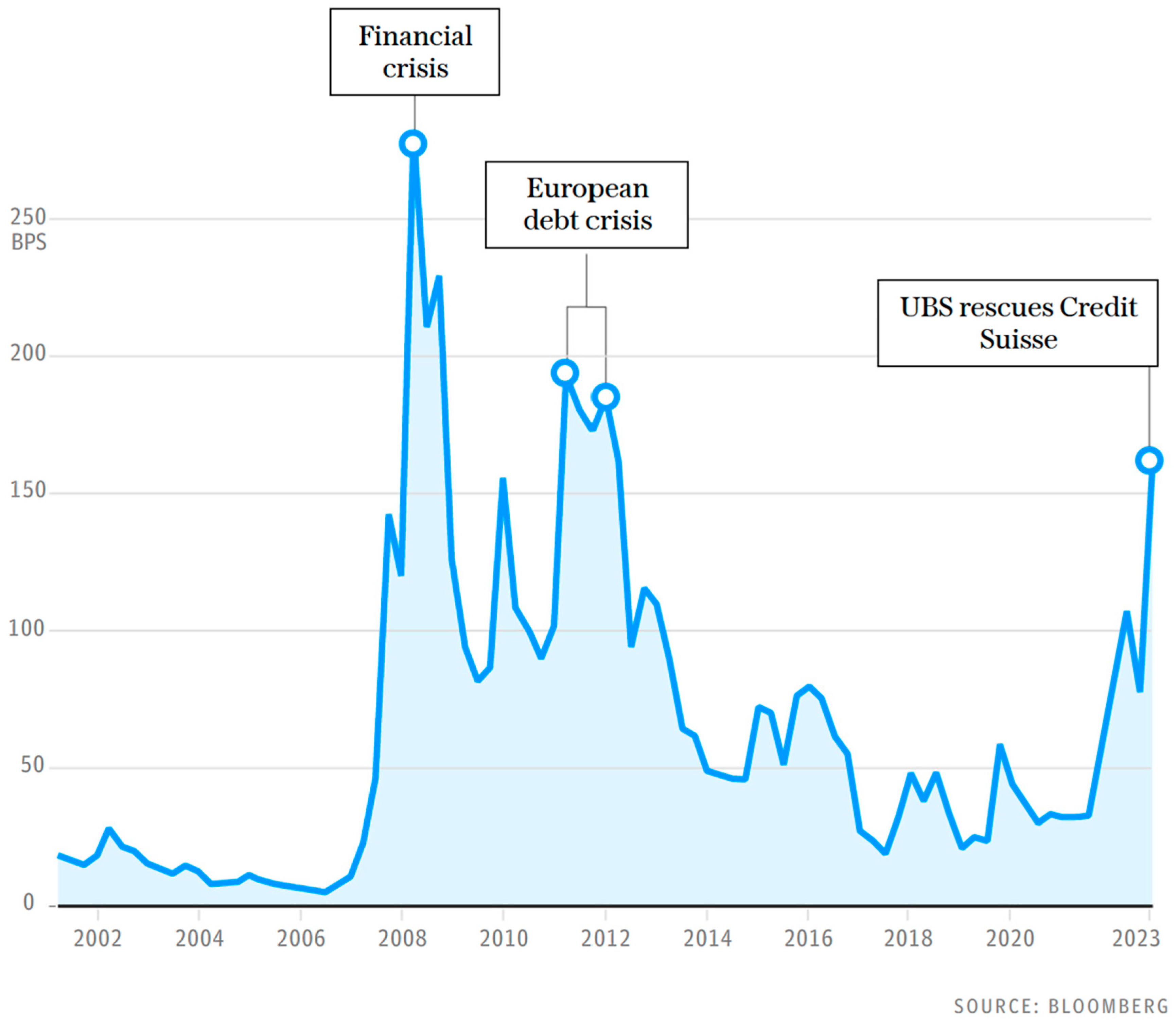

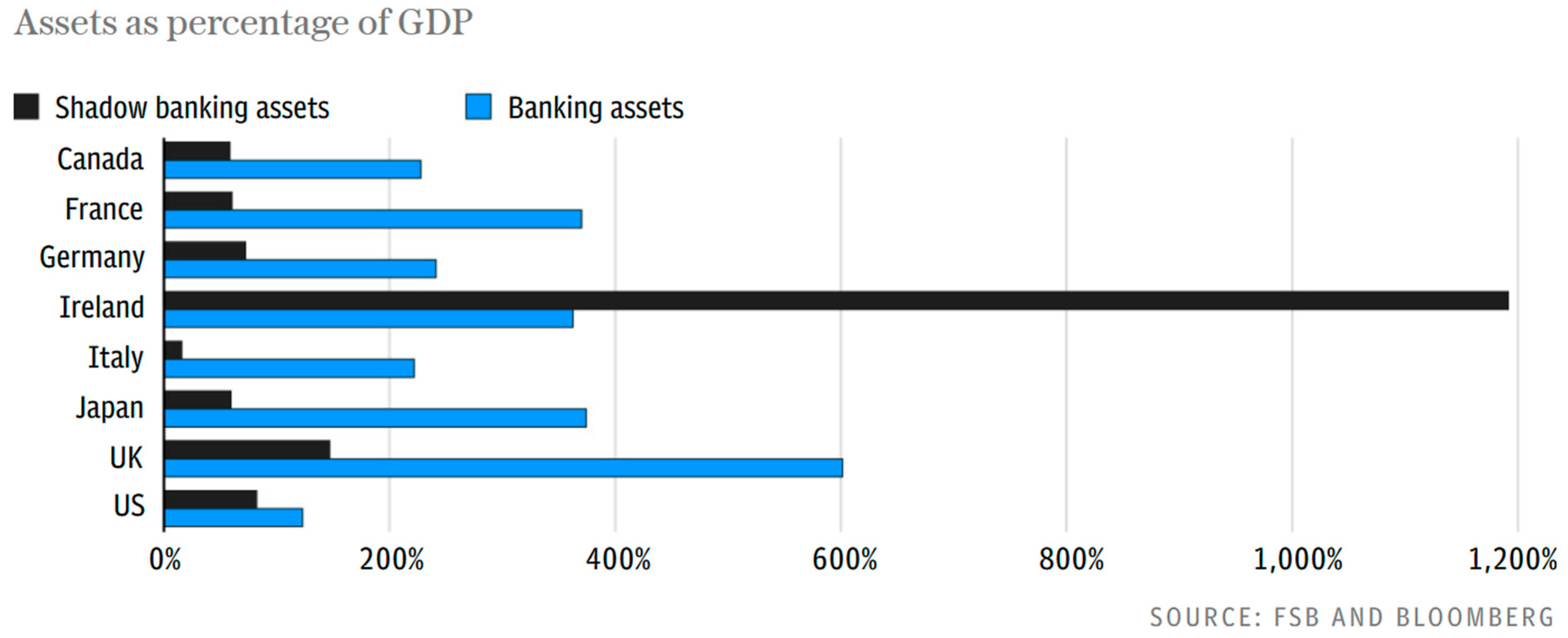
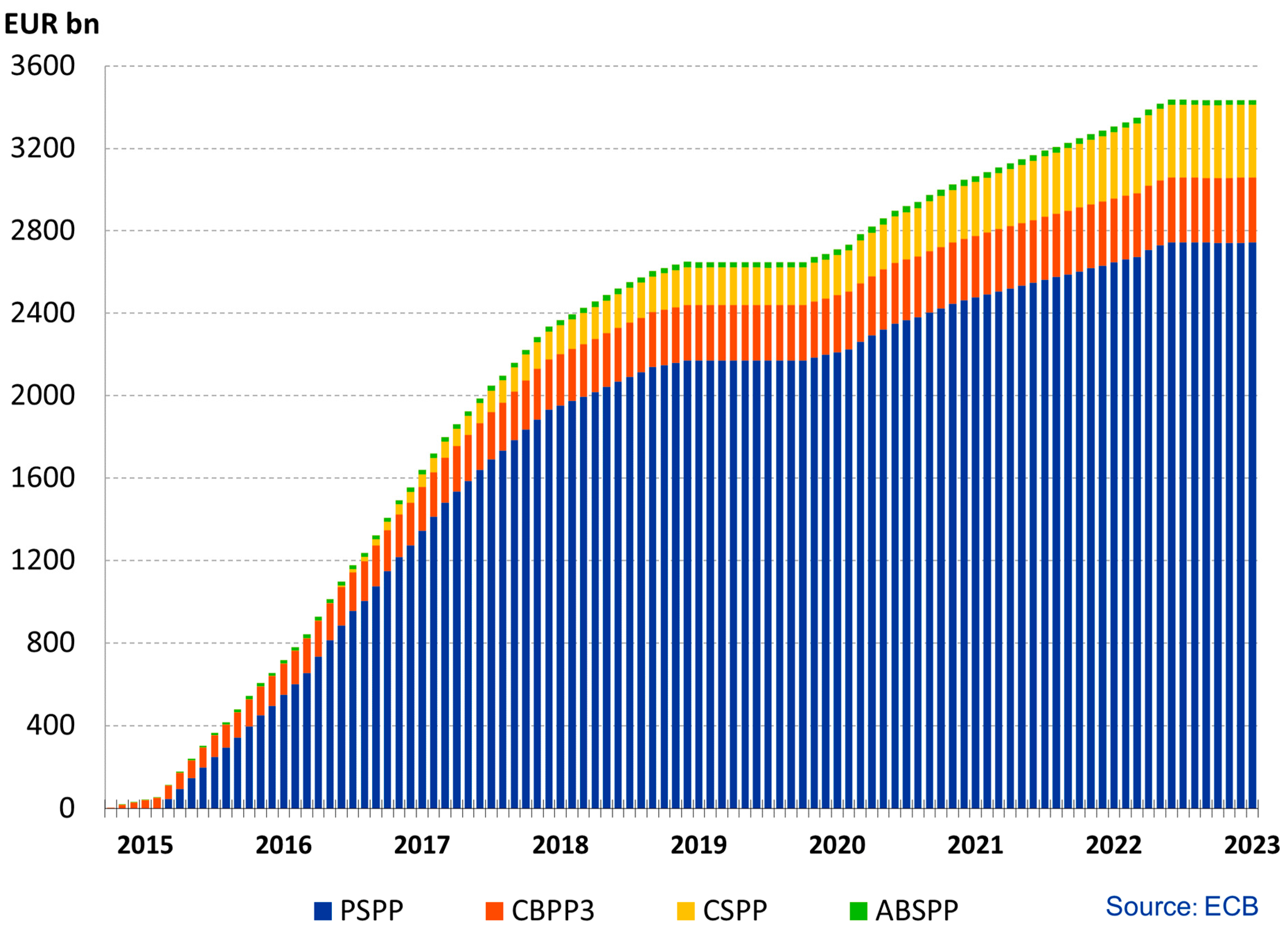
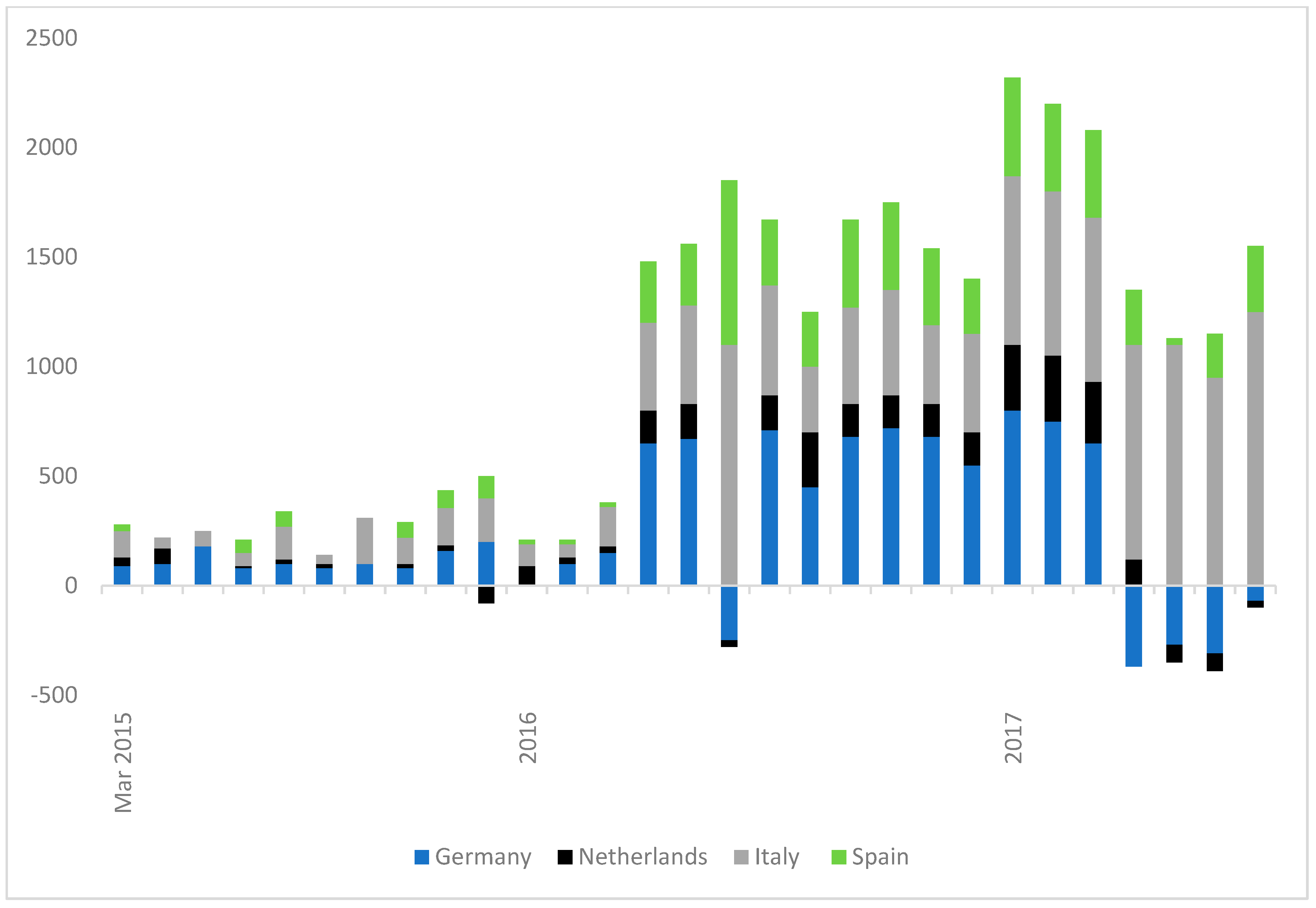
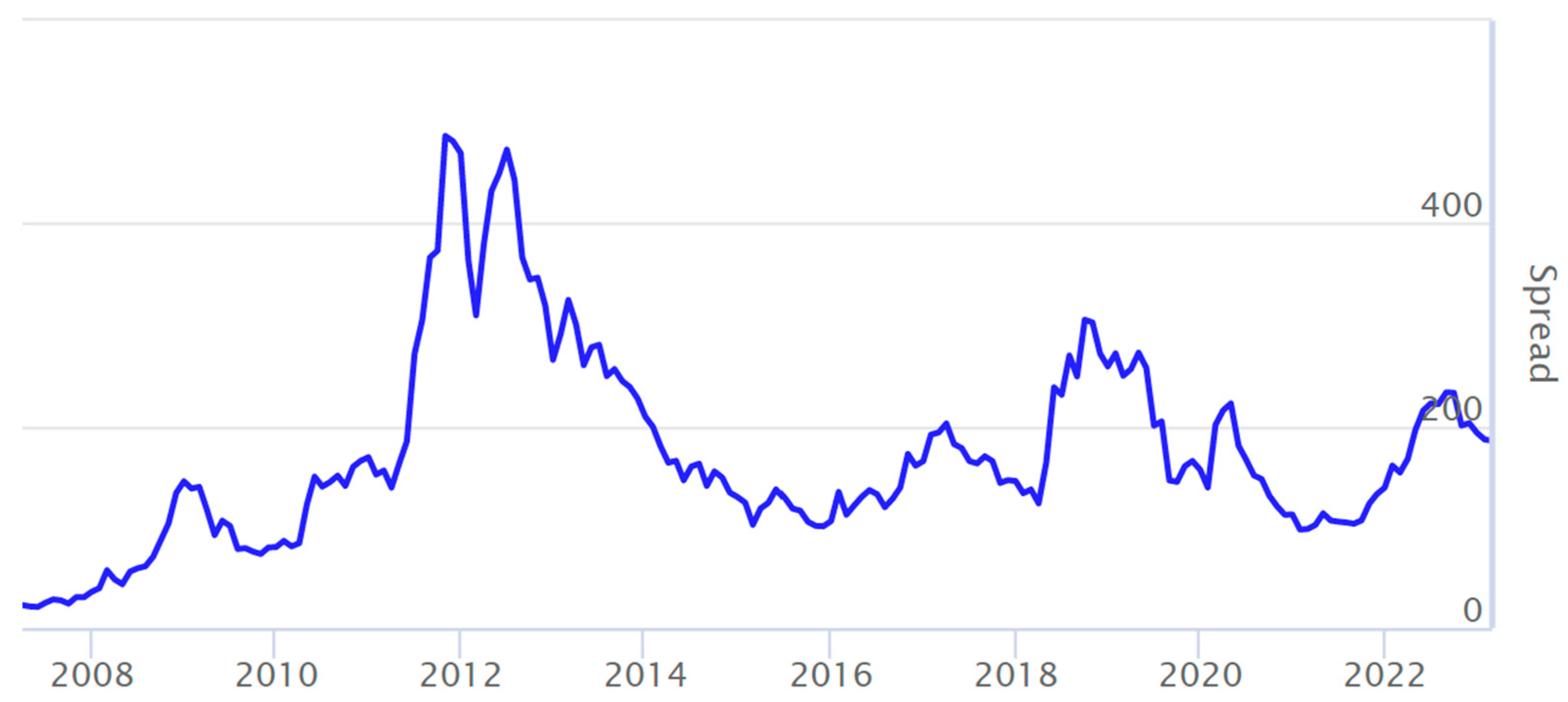
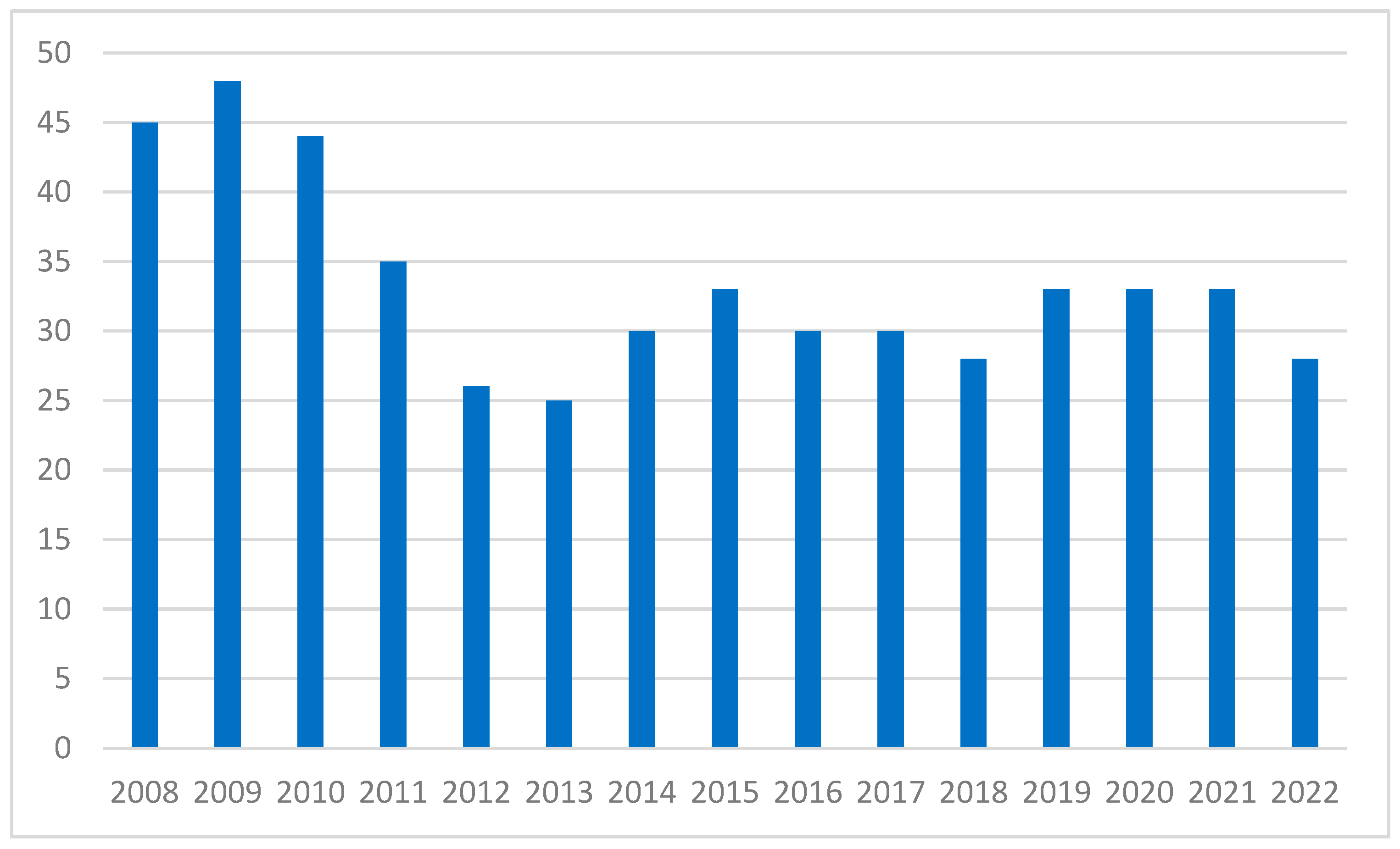
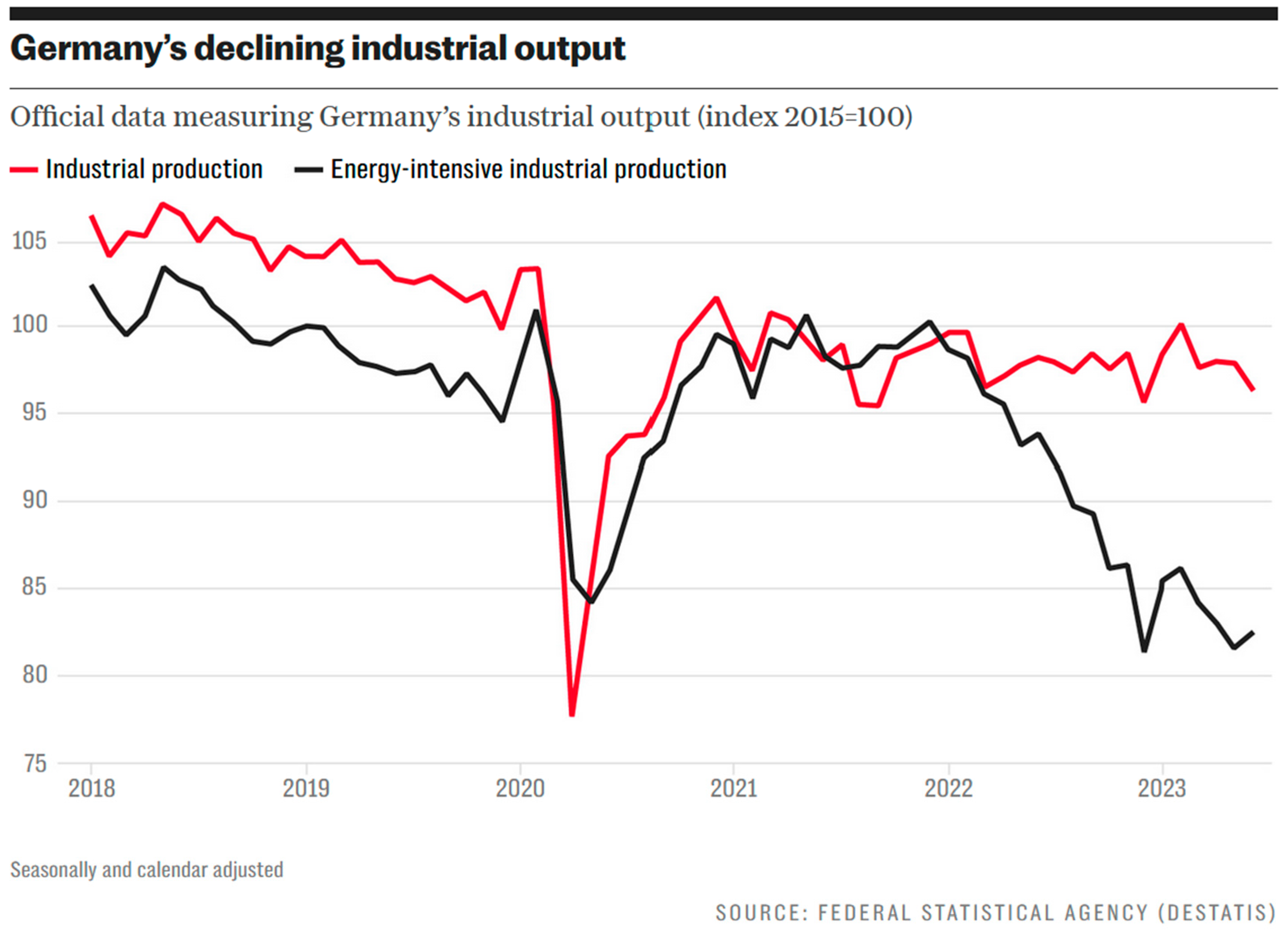

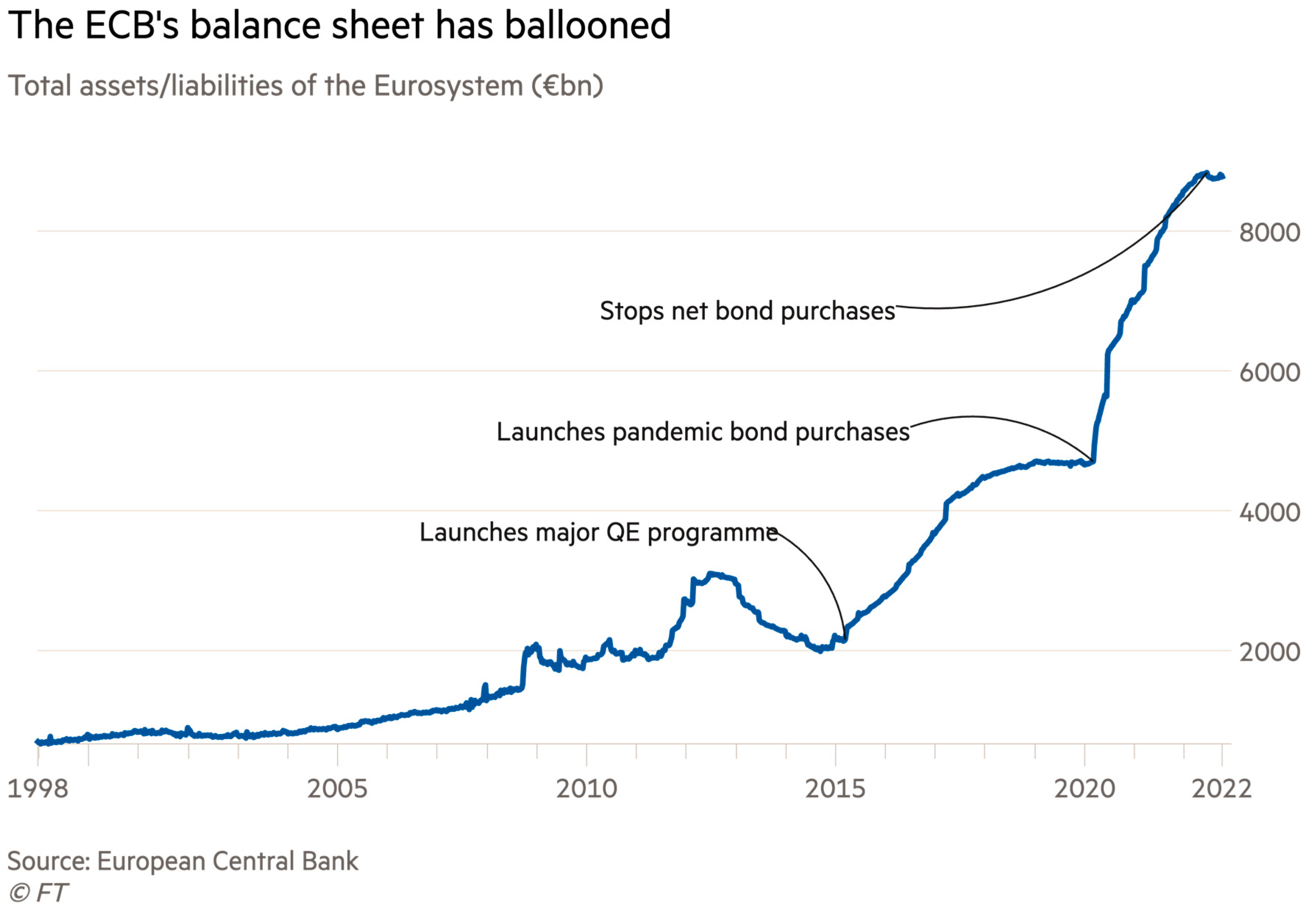
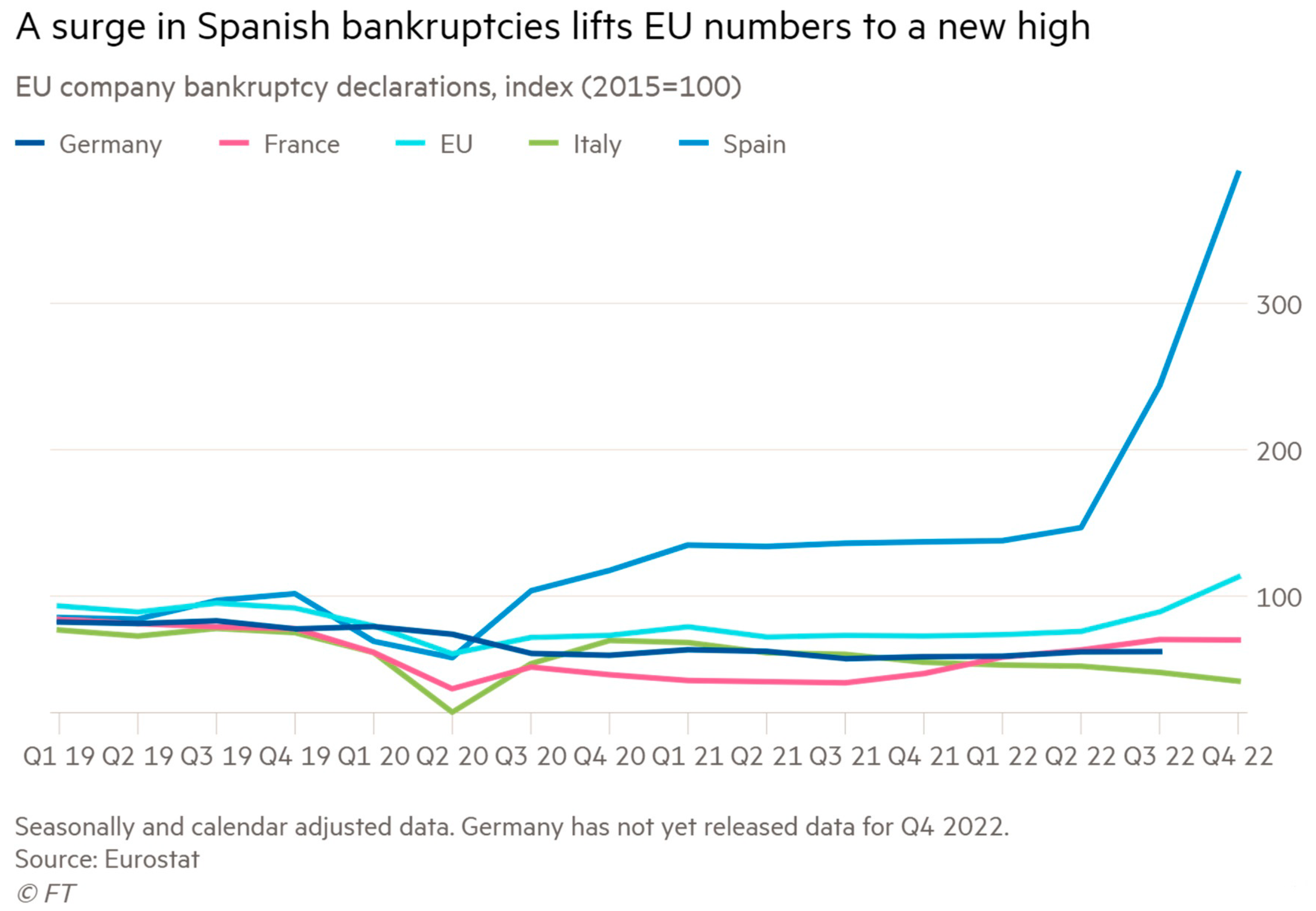

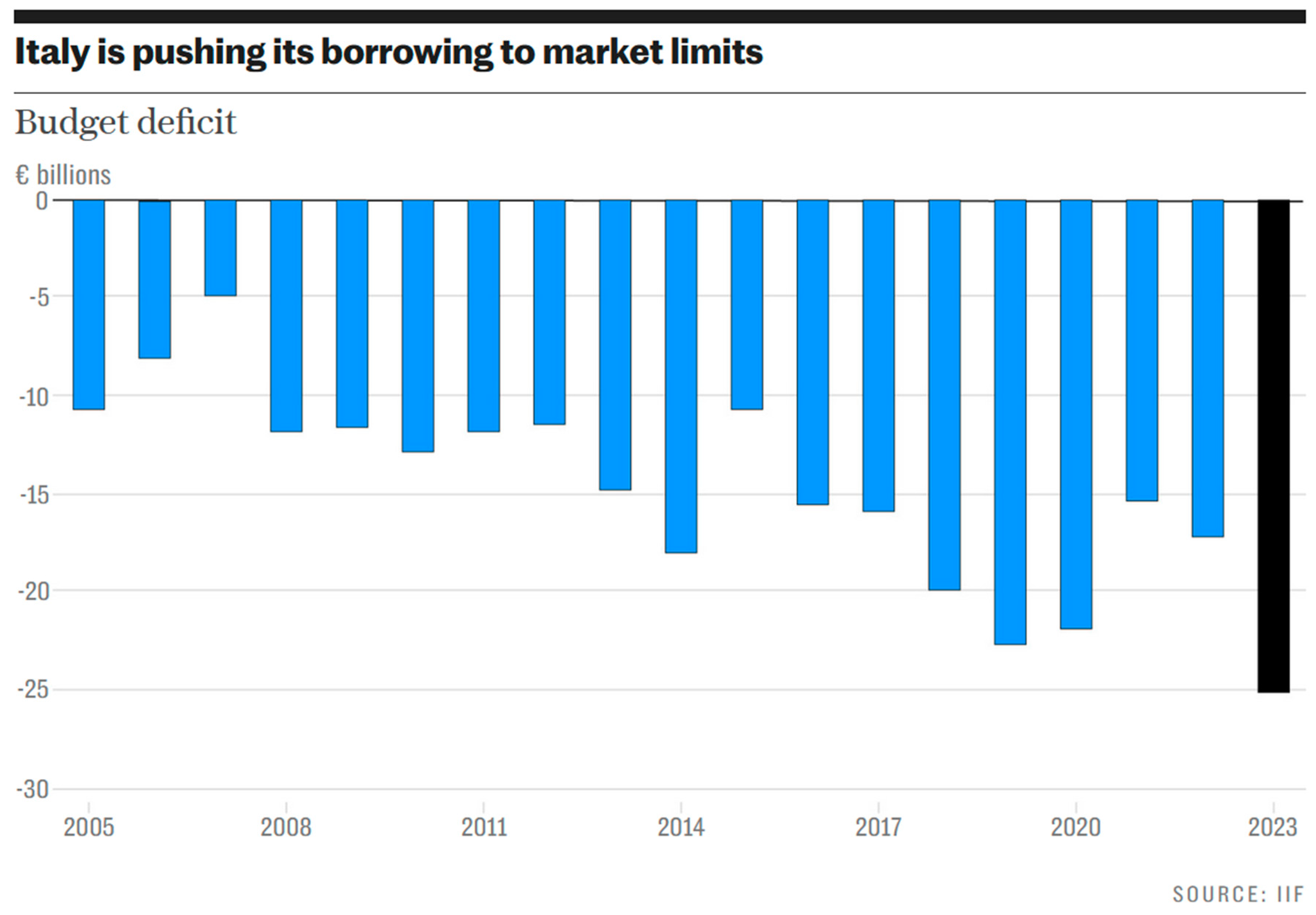

| Currency | FRF | ITL | ESP | NLG | BEF | IE£ | FIM | ATS | PTE | DEM |
|---|---|---|---|---|---|---|---|---|---|---|
| Weight (%) | 17.47 | 12.94 | 5.40 | 10.53 | 7.66 | 4.72 | 3.22 | 2.38 | 1.30 | 34.38 |
| Country | FRA | ITA | ESP | NLD | BEL | IRL | FIN | AUT | PT | DEU |
|---|---|---|---|---|---|---|---|---|---|---|
| Productivity growth (% p.a.) | 1.8 | 0.5 | 0.0 | 1.7 | NA | NA | 2.6 | 1.8 | NA | 1.9 |
| Bank | Exposure (EUR bn) |
|---|---|
| UniCredit | 60.8 |
| Intesa Sanpaolo | 55.8 |
| ICCREA Banca | 45.5 |
| Cassa Centrale Banca | 21.6 |
| Monte Paschi | 20.8 |
| Banco BPM | 20.4 |
| Unione di Banche Italiane | 9.5 |
| Medio-banca | 8.2 |
| BPER Banca | 7.6 |
| Banca Popolare di Sondrio | 7.0 |
| Credito Emiliano | 3.1 |
| Country | Exposure (EUR) |
|---|---|
| France | 295.7 bn |
| Germany | 61.0 bn |
| Spain | 36.8 bn |
| Belgium | 24.9 bn |
| UK | 17.2 bn |
| Portugal | 2.9 bn |
| Luxembourg | 2.5 bn |
| Ireland | 2.3 bn |
| Greece | 1.7 bn |
| Austria | 448.2 m |
| Malta | 148.6 m |
| Cyprus | 64.4 m |
| Lithuania | 20.5 m |
| Bank | Exposure (EUR bn) | Exposure to General Government Debt (%) | Exposure to Private Sector Debt (%) |
|---|---|---|---|
| BNP Paribas (France) | 150.0 | 20 | 80 |
| Crédit Agricole (France) | 99.0 | 18 | 82 |
| Deutsche Bank (Germany) | 29.8 | 10 | 90 |
| DEXIA (Belgium) | 22.0 | 56 | 44 |
| Société Générale (France) | 21.7 | 19 | 81 |
| Barclays (UK) | 17.2 | 43 | 57 |
| BBVA (Spain) | 14.2 | 33 | 67 |
| Commerzbank (Germany) | 13.5 | 83 | 17 |
| BPCE (France) | 12.0 | 60 | 40 |
| BCC (Spain) | 7.7 | 100 | 0 |
| Sabadell (Spain) | 6.9 | 100 | 0 |
| RCI (France) | 6.7 | 0 | 100 |
| SFIL (France) | 6.2 | 35 | 65 |
| Volkswagen Bank (Germany) | 4.8 | 0 | 100 |
| Aareal Bank (Germany) | 4.1 | 20 | 80 |
| Unicaja Banco (Spain) | 3.8 | 100 | 0 |
| DZ (Germany) | 3.4 | 100 | 0 |
| Country | Value (USD bn) |
|---|---|
| Cyprus | 167.0 |
| UK | 52.0 |
| Netherlands | 47.8 |
| Bermuda | 42.4 |
| Luxembourg | 31.3 |
| Ireland | 28.0 |
| France | 23.3 |
| Bahamas | 23.0 |
| Germany | 21.5 |
| Switzerland | 17.6 |
| Country | Dependency (%) |
|---|---|
| North Macedonia | 100 |
| Bosnia & Herzegovina | 100 |
| Moldova | 100 |
| Finland | 94 |
| Latvia | 93 |
| Bulgaria | 77 |
| Germany | 49 |
| Italy | 46 |
| Poland | 40 |
| France | 24 |
| Netherlands | 11 |
| Romania | 10 |
| Georgia | 6 |
| Ireland | 0 |
| Ukraine | 0 |
Disclaimer/Publisher’s Note: The statements, opinions and data contained in all publications are solely those of the individual author(s) and contributor(s) and not of MDPI and/or the editor(s). MDPI and/or the editor(s) disclaim responsibility for any injury to people or property resulting from any ideas, methods, instructions or products referred to in the content. |
© 2023 by the author. Licensee MDPI, Basel, Switzerland. This article is an open access article distributed under the terms and conditions of the Creative Commons Attribution (CC BY) license (https://creativecommons.org/licenses/by/4.0/).
Share and Cite
Blake, D. Target2: The Silent Bailout System That Keeps the Euro Afloat. J. Risk Financial Manag. 2023, 16, 506. https://doi.org/10.3390/jrfm16120506
Blake D. Target2: The Silent Bailout System That Keeps the Euro Afloat. Journal of Risk and Financial Management. 2023; 16(12):506. https://doi.org/10.3390/jrfm16120506
Chicago/Turabian StyleBlake, David. 2023. "Target2: The Silent Bailout System That Keeps the Euro Afloat" Journal of Risk and Financial Management 16, no. 12: 506. https://doi.org/10.3390/jrfm16120506
APA StyleBlake, D. (2023). Target2: The Silent Bailout System That Keeps the Euro Afloat. Journal of Risk and Financial Management, 16(12), 506. https://doi.org/10.3390/jrfm16120506






